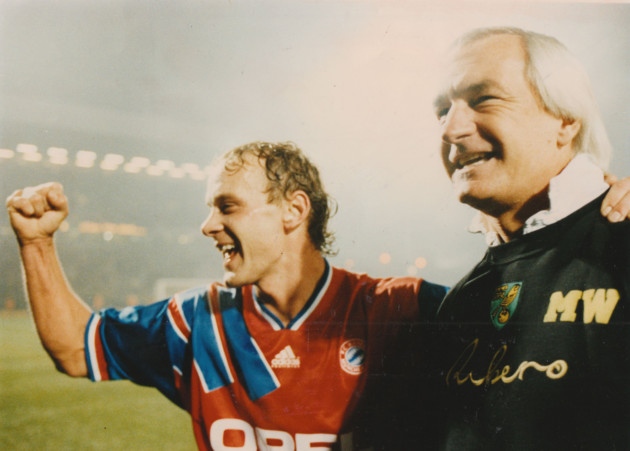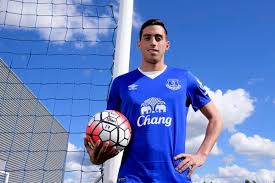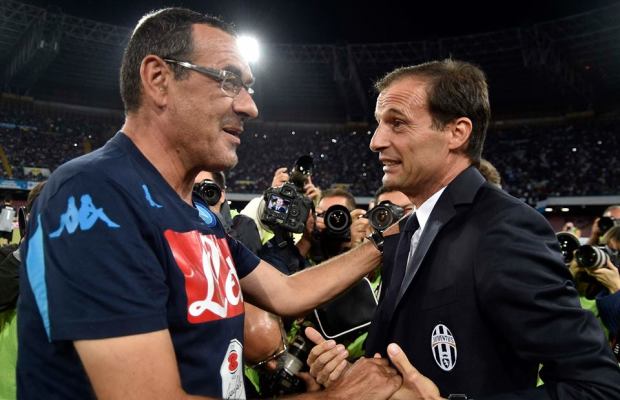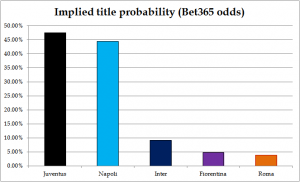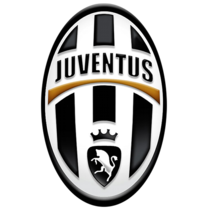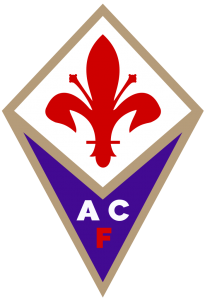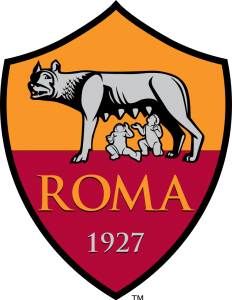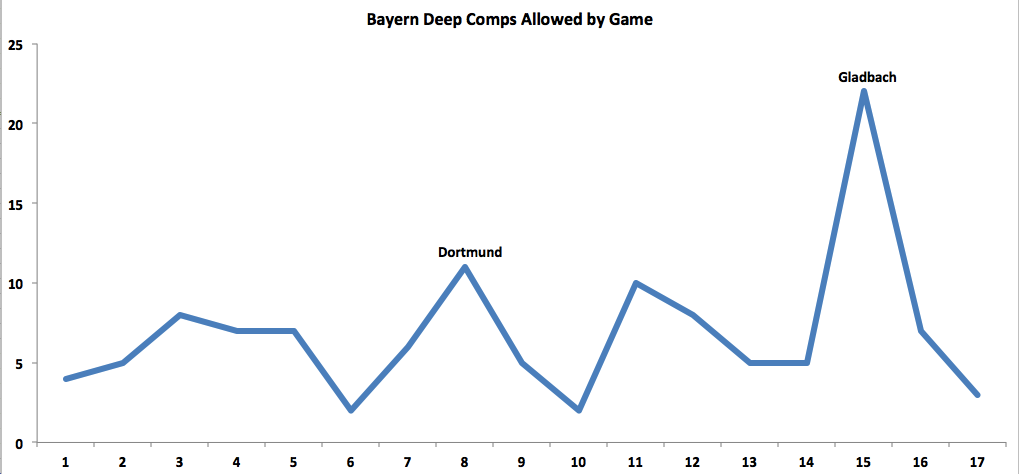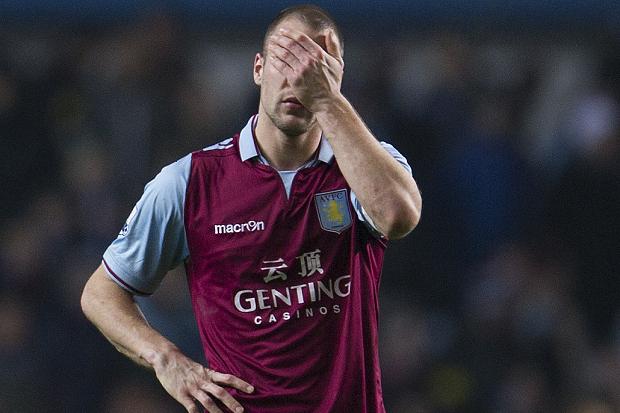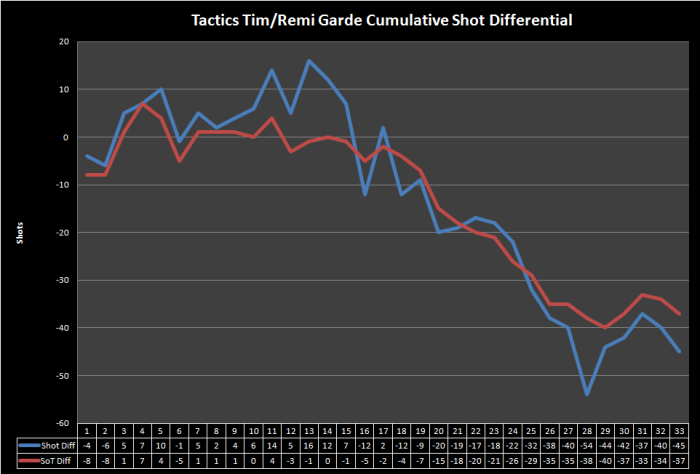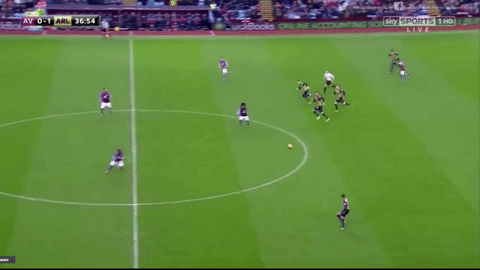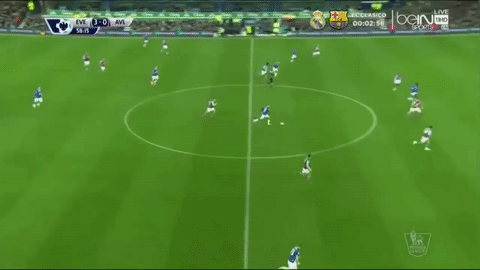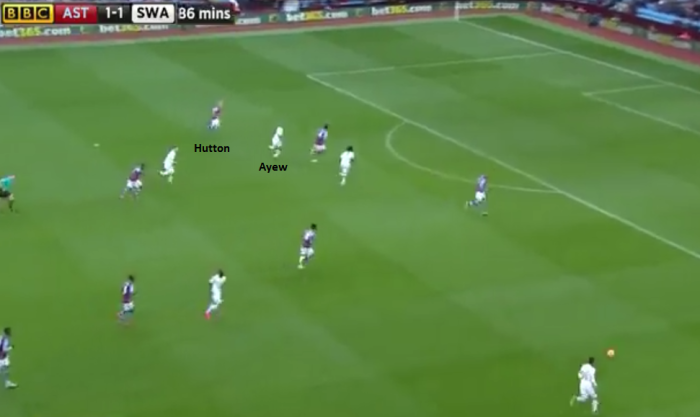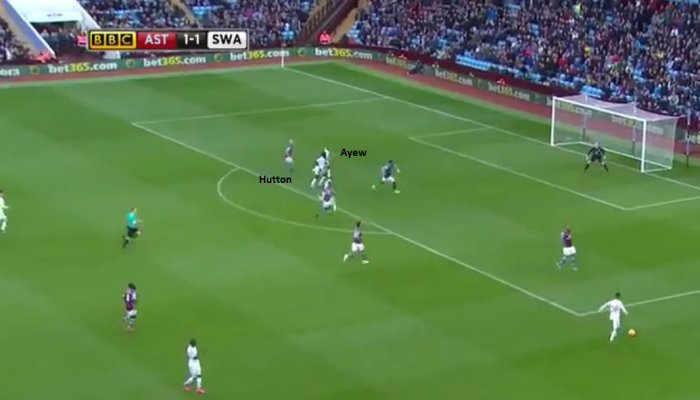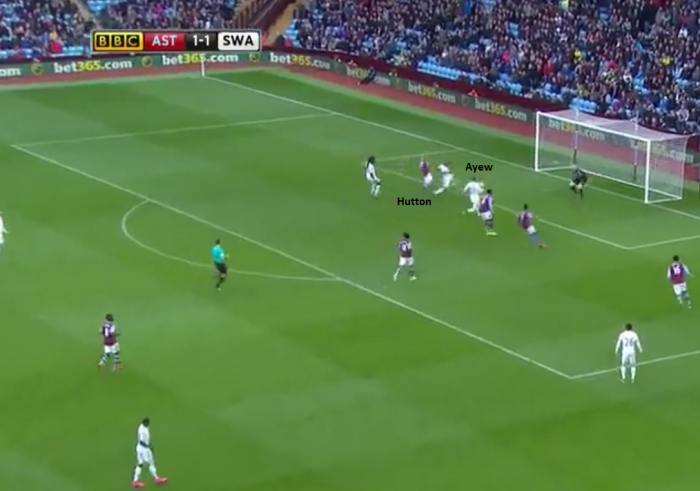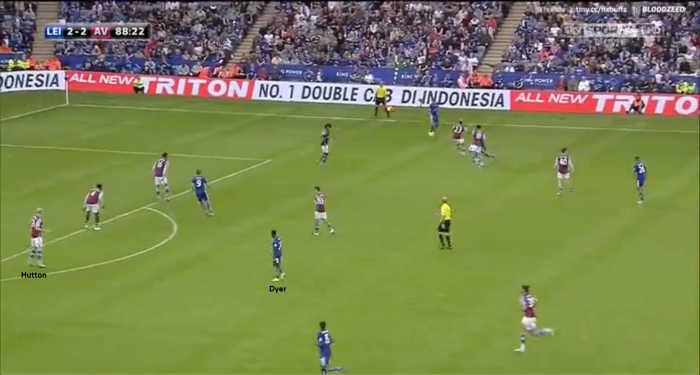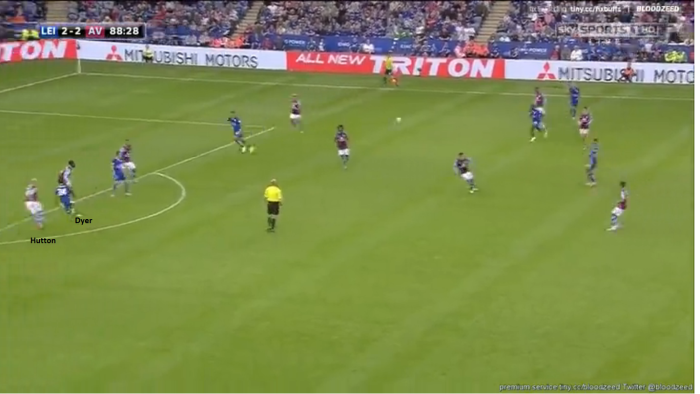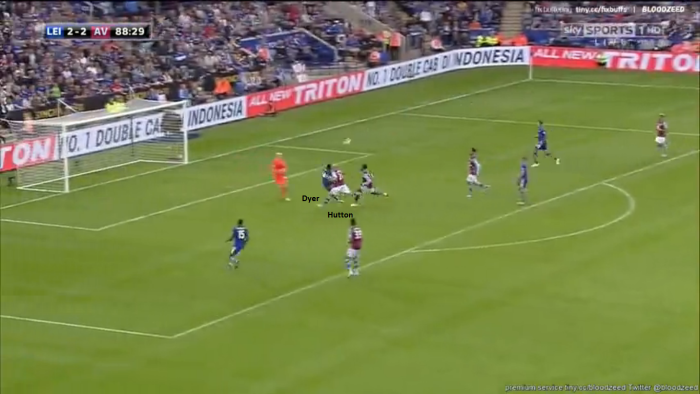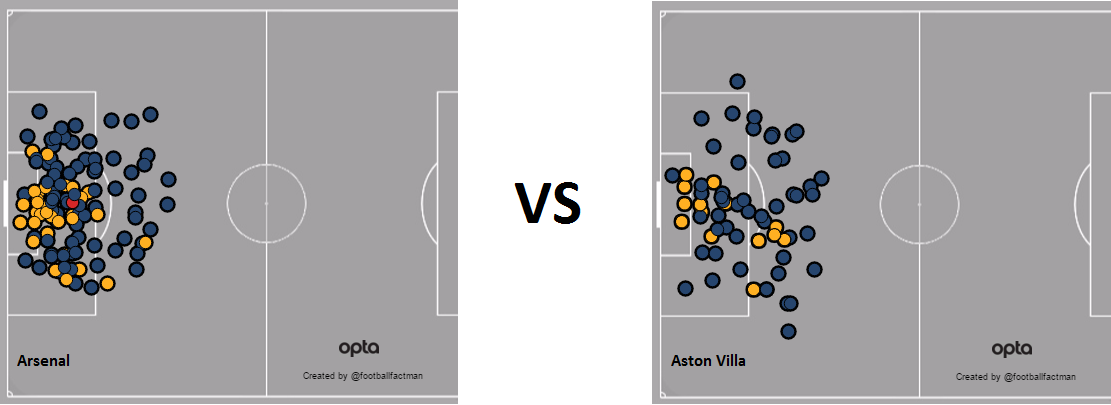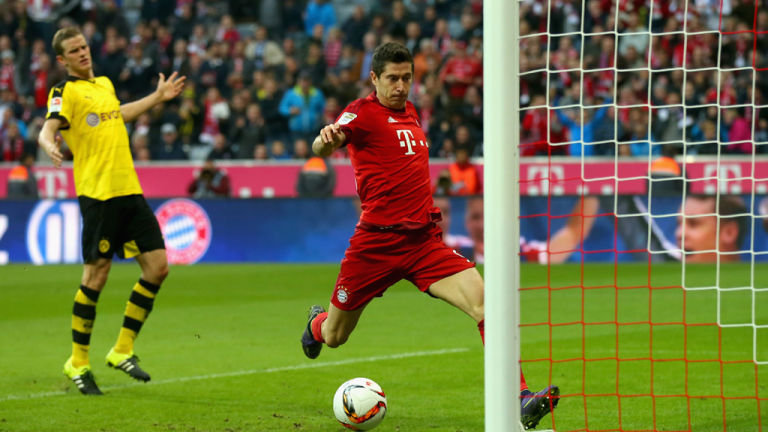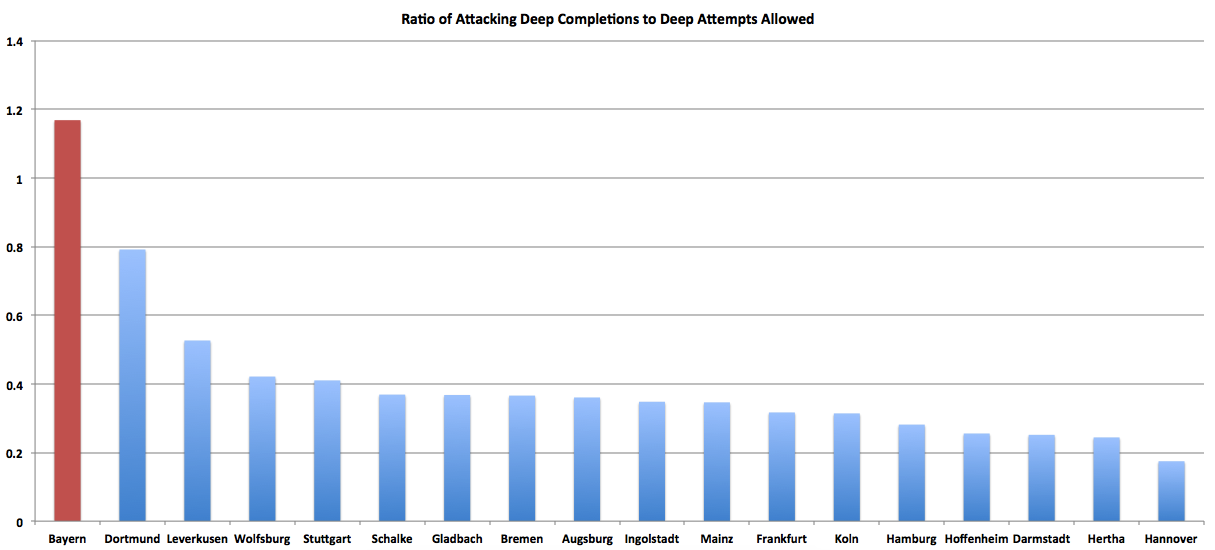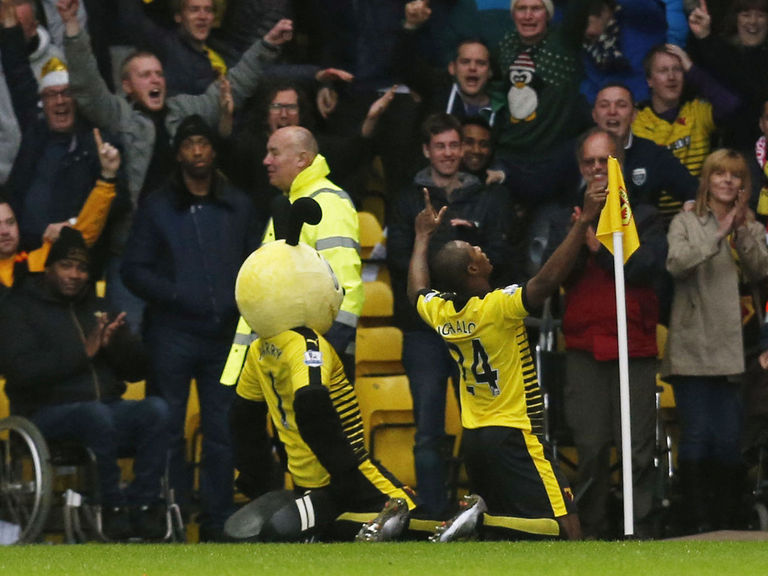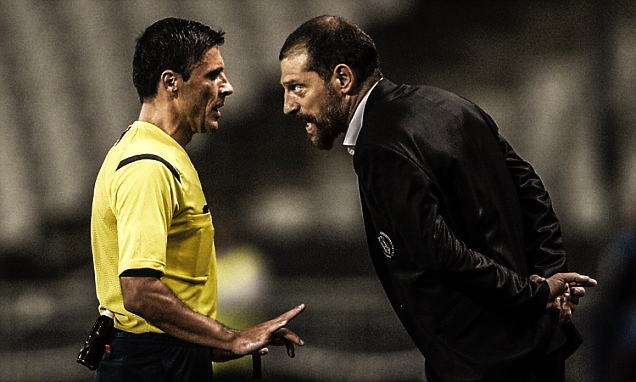 It's easy to imagine that back in May, Sam Allardyce packed up his laptop, prised his name off the office door and swung his Range Rover out of the Boleyn Ground content that he had eked out every last drop of ability from his squad. After all, in four years he had brought them up from the Championship and firmly deposited them in mid-table. Three seasons of finishing 10th , 13th and 12th represented a job well done but for long periods, fans and increasingly the owners were not content with the style. In a results business, he nailed a sensible remit only to get discarded for an idealistic one. All a rather familiar scenario for Allardyce who left both Blackburn and Newcastle mid-season having found new ownership desiring more than a lick of paint. The problem for both these clubs was that his departure set in motion an hourglass of failure; new coaches produced lesser results and each team were relegated the next season. Combine too a rudimentary study of shooting statistics and it shows that the teams Allardyce managed at West Ham consistently created sub-par numbers in comparison to their finishing positions. While maybe not as extreme as the undisputed master of such strategies, Tony Pulis, the methods Allardyce employed were effective and similarly less than scintillating. Knowing all this, come August, I was fairly confident that the challenges West Ham were obliviously idling towards would be tricky to overcome and that once more, a team shorn of the protective bear hug of Allardyce would freeze its way through winter and struggle to survive; indeed I have the betting docket to prove it. The Manager, The Player On paper, the recruitment of a passionate former fan favourite player with zero experience of the league from a managerial perspective looks a little speculative. Slaven Bilić arrived in the early summer fresh from two years of par results at Beşiktaş, a job he took after helming Lokomotiv Moscow's worst season in the post-Soviet game. With his managerial reputation residing almost entirely from work in the international arena as coach of his native Croatia, he represented something of an risky choice, one possibly more borne of emotion than Allardycian reason. A more logical move was the signing of Dimitri Payet. It was one of the more notable signings of a summer that showcased a newly rich second tier of European football residing in the mid to lower echelons of the Premier League. £10.5m wasn't a vast sum but in securing a player who had created more shots than anyone in Europe in 2014-15, West Ham pulled off a neat scoop, surely in years gone by he'd have been a cert for one of the Italian giants? His age was the one potential downside with any contract liable to carry well into his 30s and potential decline. No matter: he's been their standout player and in averaging a goal contribution of 0.68 per 90 minutes from a total shot contribution of 5.70 (per 90) he's placed himself among the league's high performers. Indeed, that he has maintained his rate of shot creation across the last two seasons: 3.9 (per 90) both years suggests that he has not been limited by the higher standard in England. This is where the 28 year old signing can pay off, a career to learn game smarts plus eminent transferable skills and an instant impact. The slightly older player can sometimes lead a team where the 21 year old starlet may shrink. The Start, the Luck During the early months of the season, West Ham benefitted from a peculiar run of scoring. They scored from their first shot on target, then their second on four occasions, a scenario unlikely to repeat–indeed it hasn't–and found themselves spending long periods of time fending off the opposition and holding for good results. Little about the team, bar the excellence of Payet, looked as though it was of sufficient quality to mount a European challenge but in their first ten games they were full of goals: only once did they fail to score at least twice. A superficial look at the results makes it appear that the entire attack revolves around the fitness of Payet, they only scored five times in the seven complete matches he missed but if we scratch a little deeper we find that West Ham's shot profile is almost indistinguishable whether he has played or not:
It's easy to imagine that back in May, Sam Allardyce packed up his laptop, prised his name off the office door and swung his Range Rover out of the Boleyn Ground content that he had eked out every last drop of ability from his squad. After all, in four years he had brought them up from the Championship and firmly deposited them in mid-table. Three seasons of finishing 10th , 13th and 12th represented a job well done but for long periods, fans and increasingly the owners were not content with the style. In a results business, he nailed a sensible remit only to get discarded for an idealistic one. All a rather familiar scenario for Allardyce who left both Blackburn and Newcastle mid-season having found new ownership desiring more than a lick of paint. The problem for both these clubs was that his departure set in motion an hourglass of failure; new coaches produced lesser results and each team were relegated the next season. Combine too a rudimentary study of shooting statistics and it shows that the teams Allardyce managed at West Ham consistently created sub-par numbers in comparison to their finishing positions. While maybe not as extreme as the undisputed master of such strategies, Tony Pulis, the methods Allardyce employed were effective and similarly less than scintillating. Knowing all this, come August, I was fairly confident that the challenges West Ham were obliviously idling towards would be tricky to overcome and that once more, a team shorn of the protective bear hug of Allardyce would freeze its way through winter and struggle to survive; indeed I have the betting docket to prove it. The Manager, The Player On paper, the recruitment of a passionate former fan favourite player with zero experience of the league from a managerial perspective looks a little speculative. Slaven Bilić arrived in the early summer fresh from two years of par results at Beşiktaş, a job he took after helming Lokomotiv Moscow's worst season in the post-Soviet game. With his managerial reputation residing almost entirely from work in the international arena as coach of his native Croatia, he represented something of an risky choice, one possibly more borne of emotion than Allardycian reason. A more logical move was the signing of Dimitri Payet. It was one of the more notable signings of a summer that showcased a newly rich second tier of European football residing in the mid to lower echelons of the Premier League. £10.5m wasn't a vast sum but in securing a player who had created more shots than anyone in Europe in 2014-15, West Ham pulled off a neat scoop, surely in years gone by he'd have been a cert for one of the Italian giants? His age was the one potential downside with any contract liable to carry well into his 30s and potential decline. No matter: he's been their standout player and in averaging a goal contribution of 0.68 per 90 minutes from a total shot contribution of 5.70 (per 90) he's placed himself among the league's high performers. Indeed, that he has maintained his rate of shot creation across the last two seasons: 3.9 (per 90) both years suggests that he has not been limited by the higher standard in England. This is where the 28 year old signing can pay off, a career to learn game smarts plus eminent transferable skills and an instant impact. The slightly older player can sometimes lead a team where the 21 year old starlet may shrink. The Start, the Luck During the early months of the season, West Ham benefitted from a peculiar run of scoring. They scored from their first shot on target, then their second on four occasions, a scenario unlikely to repeat–indeed it hasn't–and found themselves spending long periods of time fending off the opposition and holding for good results. Little about the team, bar the excellence of Payet, looked as though it was of sufficient quality to mount a European challenge but in their first ten games they were full of goals: only once did they fail to score at least twice. A superficial look at the results makes it appear that the entire attack revolves around the fitness of Payet, they only scored five times in the seven complete matches he missed but if we scratch a little deeper we find that West Ham's shot profile is almost indistinguishable whether he has played or not: 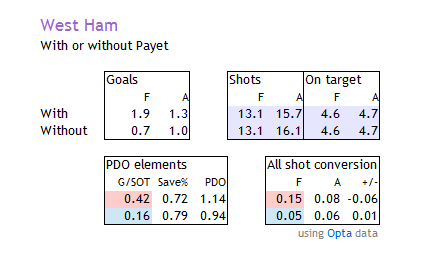 So: this is important and in some way quite impressive, West Ham's form has little to do with Payet's fitness, when he played they were riding an enormous wave of shot conversion (red) that was inevitably going to decline (blue), which it did during the period he didn't play. Bilic's system survived the loss of his best player with little alteration in fundamental shot rates. Next time it is presented that West Ham's success has been based around the form of Payet, anyone reading this will know better. Is he their best attacking player? Probably yes. Are they a better team with him in it? Not necessarily. There is scope for further pulling this apart based on schedule, but that is unlikely to move the dial too far away from the clear point here. Less impressive among these numbers, at least for their medium to long term potential is that West Ham have been a sub-par total shots team and a roughly par on target team. But they're sixth The expected goals models don't deviate far here, both Paul Riley and Michael Caley peg them in 11th and i've got a couple of simple shot-based models that have them 11th or 12th yet they are sitting happily in 6th place having lost only five times. After coming off their conversion fuelled peak in the autumn, they have settled onto an average around 1.6 points per game, with little deviation. They simply haven't had a crippling run of results; even their eight game winless streak involved six draws, enough to keep them ticking along and out of the range of any tabloid powered crisis flashlight. There are genuine problems among their shooting numbers; only Crystal Palace have conceded twenty shots as frequently as West Ham: eight times, and that average of nearly sixteen per game is more often associated with relegation threatened teams. Also an early positive skew towards time spent winning has declined as the season has worn on. Indeed shot rates are not good when faced with a deficit, they rank 13th in shots for (11.4 shots/90) and dead last against (17.6/90) suggesting recovering deficits is not a strong suit. Regarding personnel, given this inability to limit opposition shooting, it seems odd to see that the core of the team that has played most consistently is defensive. Kouyaté, Tomkins, Noble, Cresswell and Adrián have all played over 80% of available minutes and Ogbonna, Reid and Jenkinson have all played 55% or more. Forward options seem to have been less consistent and at least from a numerical perspective the sale of Zarate, a solid shot contributor from limited minutes, seems slightly odd. Lanzini has contributed when fit, but a lack of goals has characterised the play of the chosen forwards: none have more than four all season. Going Forward It's easy to presume that West Ham are at the top of their curve and that a reversion is inevitable. I calculate that they are about four points ahead of a general expected total which is certainly in the realm of likely variance and the nature of a 38 game season means that it's perfectly reasonable to assume that they could continue to overhit an expected level til season's end. It is less likely that they skew any further upwards, and a slight drop down the table is the smart call, certainly Omar Chaudhuri's collation of Sporting Index's predicted points lands them in 8th position but within only three points of 11th. So what do we think of Bilic? In truth it is hard to know; 23 games characterised by a big positive goals skew for at least half of them is masking shooting numbers that aren't far away from those created last season. Much like Allardyce he has so far come out on the right end of them. With relatively little change in the squad year on year, it could be possible that we are seeing a similar situation to that which occurred at Everton after David Moyes 11 year tenure ended. That first season after, 2013-14 under Roberto Martinez, Everton performed solidly, almost as if the Moyes blueprint had carried over into the new man's reign. Last season and this, Everton look far less secure and more like the team that Roberto built. It's possible that it will be next year when we see the true character of a Bilic team, and it is hard to know whether that will be enough to stall the Allardyce hourglass. ___________________________________ Thanks for reading! Follow me on twitter here: @jair1970
So: this is important and in some way quite impressive, West Ham's form has little to do with Payet's fitness, when he played they were riding an enormous wave of shot conversion (red) that was inevitably going to decline (blue), which it did during the period he didn't play. Bilic's system survived the loss of his best player with little alteration in fundamental shot rates. Next time it is presented that West Ham's success has been based around the form of Payet, anyone reading this will know better. Is he their best attacking player? Probably yes. Are they a better team with him in it? Not necessarily. There is scope for further pulling this apart based on schedule, but that is unlikely to move the dial too far away from the clear point here. Less impressive among these numbers, at least for their medium to long term potential is that West Ham have been a sub-par total shots team and a roughly par on target team. But they're sixth The expected goals models don't deviate far here, both Paul Riley and Michael Caley peg them in 11th and i've got a couple of simple shot-based models that have them 11th or 12th yet they are sitting happily in 6th place having lost only five times. After coming off their conversion fuelled peak in the autumn, they have settled onto an average around 1.6 points per game, with little deviation. They simply haven't had a crippling run of results; even their eight game winless streak involved six draws, enough to keep them ticking along and out of the range of any tabloid powered crisis flashlight. There are genuine problems among their shooting numbers; only Crystal Palace have conceded twenty shots as frequently as West Ham: eight times, and that average of nearly sixteen per game is more often associated with relegation threatened teams. Also an early positive skew towards time spent winning has declined as the season has worn on. Indeed shot rates are not good when faced with a deficit, they rank 13th in shots for (11.4 shots/90) and dead last against (17.6/90) suggesting recovering deficits is not a strong suit. Regarding personnel, given this inability to limit opposition shooting, it seems odd to see that the core of the team that has played most consistently is defensive. Kouyaté, Tomkins, Noble, Cresswell and Adrián have all played over 80% of available minutes and Ogbonna, Reid and Jenkinson have all played 55% or more. Forward options seem to have been less consistent and at least from a numerical perspective the sale of Zarate, a solid shot contributor from limited minutes, seems slightly odd. Lanzini has contributed when fit, but a lack of goals has characterised the play of the chosen forwards: none have more than four all season. Going Forward It's easy to presume that West Ham are at the top of their curve and that a reversion is inevitable. I calculate that they are about four points ahead of a general expected total which is certainly in the realm of likely variance and the nature of a 38 game season means that it's perfectly reasonable to assume that they could continue to overhit an expected level til season's end. It is less likely that they skew any further upwards, and a slight drop down the table is the smart call, certainly Omar Chaudhuri's collation of Sporting Index's predicted points lands them in 8th position but within only three points of 11th. So what do we think of Bilic? In truth it is hard to know; 23 games characterised by a big positive goals skew for at least half of them is masking shooting numbers that aren't far away from those created last season. Much like Allardyce he has so far come out on the right end of them. With relatively little change in the squad year on year, it could be possible that we are seeing a similar situation to that which occurred at Everton after David Moyes 11 year tenure ended. That first season after, 2013-14 under Roberto Martinez, Everton performed solidly, almost as if the Moyes blueprint had carried over into the new man's reign. Last season and this, Everton look far less secure and more like the team that Roberto built. It's possible that it will be next year when we see the true character of a Bilic team, and it is hard to know whether that will be enough to stall the Allardyce hourglass. ___________________________________ Thanks for reading! Follow me on twitter here: @jair1970
Month: January 2016
The House that Pardew Built
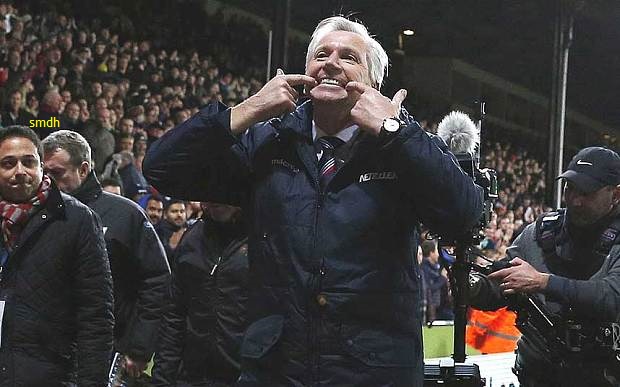 Long before Leicester became the radical counter attacking machine that took the Premier League by storm, Crystal Palace were already setting the blueprint on how to achieve similar things. When Alan Pardew was hired by in the middle of last season, it was obvious what his intentions were; to create a mini counter attacking death machine. And it worked. Crystal Palace accumulated the 6th most points from Pardew's hiring until the end of season with 31, only two points back of Manchester City who accumulated the 2nd most during that same span. There was some form of evidence that Alan Pardew legitimately improved Crystal Palace in that half season in charge and molded them into his utopian ideal of a counter attacking PL side. They earned big victories over Manchester City and Liverpool spoiling Steven Gerrard's final Anfield match, and at times were a hell of a lot of fun to watch. A top 10 finish and that influx of PL money meant that Crystal Palace could be ambitious in the transfer window, which meant that Pardew plucked Yohan Cabaye from PSG's bench and make him a center piece of their attack this season. Now there were some warning signs coming into this season when it came to Pardew's half season cameo. As James Grayson pointed out, while Pardew did raise Crystal Palace's shot metrics to near league average numbers through his preference for high octane football, he also benefitted from Crystal Palace scoring at a ridiculous rate while having a save% that was more or less average compared to the horrors previously. This season for Crystal Palace has been... weird to say the least. There was a considerable amount of excitement for Palace as a pseudo Europa League candidate because of the Pardiola football previously and it hasn't quite turned out as great as some hoped. Crystal Palace are mid table right now despite some wacky shot numbers. They rank in the bottom 5 in total shot ratio, yet rank mid of the road in shots on target ratio. Only Tottenham have a bigger positive difference between TSR and SoTR.
Long before Leicester became the radical counter attacking machine that took the Premier League by storm, Crystal Palace were already setting the blueprint on how to achieve similar things. When Alan Pardew was hired by in the middle of last season, it was obvious what his intentions were; to create a mini counter attacking death machine. And it worked. Crystal Palace accumulated the 6th most points from Pardew's hiring until the end of season with 31, only two points back of Manchester City who accumulated the 2nd most during that same span. There was some form of evidence that Alan Pardew legitimately improved Crystal Palace in that half season in charge and molded them into his utopian ideal of a counter attacking PL side. They earned big victories over Manchester City and Liverpool spoiling Steven Gerrard's final Anfield match, and at times were a hell of a lot of fun to watch. A top 10 finish and that influx of PL money meant that Crystal Palace could be ambitious in the transfer window, which meant that Pardew plucked Yohan Cabaye from PSG's bench and make him a center piece of their attack this season. Now there were some warning signs coming into this season when it came to Pardew's half season cameo. As James Grayson pointed out, while Pardew did raise Crystal Palace's shot metrics to near league average numbers through his preference for high octane football, he also benefitted from Crystal Palace scoring at a ridiculous rate while having a save% that was more or less average compared to the horrors previously. This season for Crystal Palace has been... weird to say the least. There was a considerable amount of excitement for Palace as a pseudo Europa League candidate because of the Pardiola football previously and it hasn't quite turned out as great as some hoped. Crystal Palace are mid table right now despite some wacky shot numbers. They rank in the bottom 5 in total shot ratio, yet rank mid of the road in shots on target ratio. Only Tottenham have a bigger positive difference between TSR and SoTR.
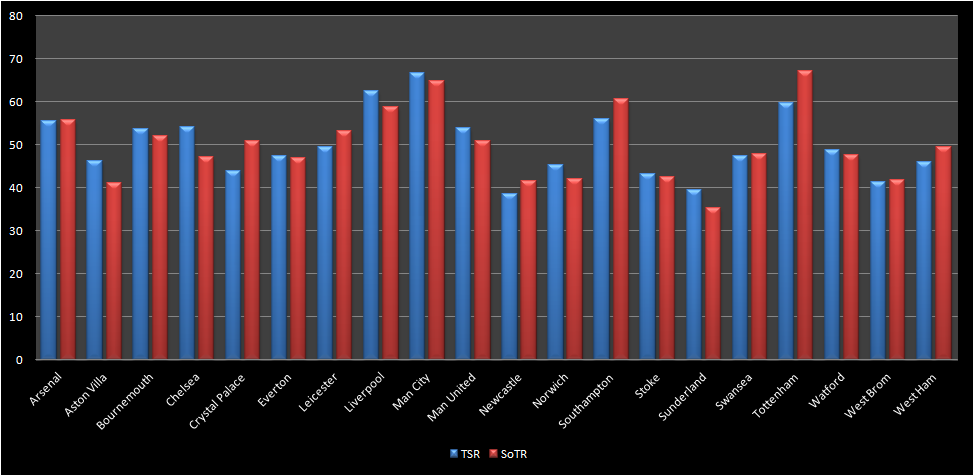 (up to 22nd January, using Opta data)
(up to 22nd January, using Opta data)
It gets even weirder when adding shot quality to it. When accounting for all shots, Crystal Palace are objectively bad. When only accounting for the shots that hit the target, Palace are again quite okay, ranking in the top 8 in SoT expected goal difference. This has been a running theme for Pardew since becoming Crystal Palace's manager. His teams have somehow been able to stay afloat in the SoT differentials despite being outshot heavily. 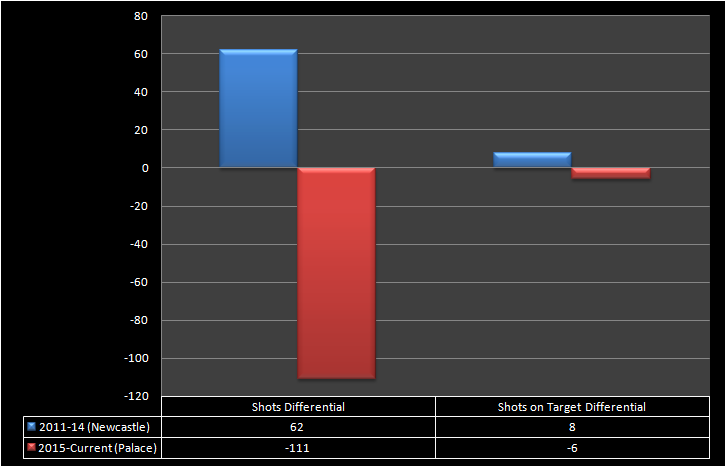 When at Newcastle, the opposite was going on for Pardew. They basically couldn't buy any variance in terms of shots hitting the target. Seeing the massive discrepancy with his teams is probably some sort of sign that this is what you get with Pardew as your manager, that his system somehow manages to create a lopsided relationship between overall shots and shots that hit the target. I have high suspicions that Palace can't keep up what they’re doing right now for much longer but that remains to be seen. It’s easy to make some comparisons between Palace and Leicester. They’re both primarily based on executing off of opposition mistakes and banking on variance being on their side in these situations, which is shown as both are tied for last in shots coming from established possessions. They’re both shaky shot differential teams that at different points got very helpful assistance from PDO swings, and they’re at their best when the game is either tied or in a winning state. But to Leicester’s credit, at least their shot numbers are in the 50-52% range and they somehow unearthed possibly the best forward duo in the PL. Crystal Palace on the other hand hasn’t found something close to Vardy/Mahrez and that’s probably the most interesting thing with this club going forward. They’re still stocked with a number of fun albeit at times inefficient attacking midfielders who are mostly in their prime years. Bakary Sako, Yannick Bolasie, Wilfred Zaha, Jason Puncheon. Add in Yohan Cabaye and his passing abilities and there’s a base there for a really lethal counter attack that could maybe punch above their weight and contend for something grand. And then you look at their forward core and it’s so uninspiring. Connor Wickham to this point has been a bad striker who garnered way too much hype because of his mini goal-scoring streak that kept Sunderland up in 2014. Dwight Gayle hasn’t amounted to anything other than being the guy who finished off Liverpool’s title run, and Marouane Chamakh and his hairline is somehow on the squad. For a club blessed with exciting counter-attacking demons, complimenting them with the strikers they have is kind of depressing. With the news that Marseille inked Michy Batshuayi to a contract extension, a January transfer is all but gone. However in my piece about Michy in October, I wrote about how Crystal Palace could be the perfect fit for Batshuayi stylistically with the talent surrounding him. If Crystal Palace called Marseille during the summer, I could see Palace’s pitch resembling this Pardew: “Hello Michy, this is Alan Pardew; the greatest manager in the history of English football. Hell, what am I saying? I’m the greatest manager in the history of football. Anyways, we’re building something interesting here. A fun counter attacking system that pounces on the first mistake made by opponents. You see how Leicester are in pole position to qualify for the Champions League? Leicester! I’m pretty sure you barely heard of them until this season. We’re trying to create some of that same magic. We think you’re our missing piece to the puzzle that we’re trying to solve” Michy: “I’m sorry, you want me to play for Crystal Palace? I’m playing for one of the most famous clubs in France!” Pardew: “Yes. Look we get it. We’re not a glamour club. We don’t have a new stadium coming like Tottenahm nor are we Arsenal orChelsea. I understand your apprehension but just hear me out. First off we have a lot of cash, certainly much more than your current club has. You see how we plucked Cabaye from PSG? We can make you a very rich man. We also play in London so it’s not like I’m making you live out in Siberia. And here’s the big kicker, we’re making you our lead man here. Tottenham can’t do that; Arsenal and Chelsea probably won’t take that chance with you. We’re making you our centerpiece for our club and we genuinely think we can make a run at the CL with you on our squad. We’ve seen your goal scoring record and we think you’ll be amazing for us in a system complimenting you. And hell, you can probably still get your dream club move in ~3 years time if you still desperately want it. ” Michy: “Tempting, but I still have to play for Palace. You’ve seen your kits?” Pardew: “Look we can fix that later. You’ll love it here. Selhurst Park isn’t the Stade Veledrome but the atmosphere is certainly comparable. You get to be on Sky Sports every weekend for an up and coming force and you get to be managed by me. Also, have I mentioned how much money we can offer you? What do you say?” Michy: “Again, tempting. I’ll get back to you soon” There’s something interesting brewing in Crystal Palace. The skeletons are there for a high tempo squad that kills it on the counter and in the PL that can take you a long way. Certainly, this current iteration isn’t that because they’re a below average side that leaks shots attempts at will and can’t make any of that up offensively. I’m also skeptical of trusting a team with Alan Pardew as their manager but he probably grades out as an average manager so this experiment could still work. Going after a striker, preferably one in the 22-24 age bracket would be wise for them in the future and they have to find a workable fix in the midfield so they don’t concede shots easily while still being to play a playmaker like Cabaye. If they can address both of those needs, perhaps Crystal Palace could be the next PL counter attacking side that challenges for Europe.
When at Newcastle, the opposite was going on for Pardew. They basically couldn't buy any variance in terms of shots hitting the target. Seeing the massive discrepancy with his teams is probably some sort of sign that this is what you get with Pardew as your manager, that his system somehow manages to create a lopsided relationship between overall shots and shots that hit the target. I have high suspicions that Palace can't keep up what they’re doing right now for much longer but that remains to be seen. It’s easy to make some comparisons between Palace and Leicester. They’re both primarily based on executing off of opposition mistakes and banking on variance being on their side in these situations, which is shown as both are tied for last in shots coming from established possessions. They’re both shaky shot differential teams that at different points got very helpful assistance from PDO swings, and they’re at their best when the game is either tied or in a winning state. But to Leicester’s credit, at least their shot numbers are in the 50-52% range and they somehow unearthed possibly the best forward duo in the PL. Crystal Palace on the other hand hasn’t found something close to Vardy/Mahrez and that’s probably the most interesting thing with this club going forward. They’re still stocked with a number of fun albeit at times inefficient attacking midfielders who are mostly in their prime years. Bakary Sako, Yannick Bolasie, Wilfred Zaha, Jason Puncheon. Add in Yohan Cabaye and his passing abilities and there’s a base there for a really lethal counter attack that could maybe punch above their weight and contend for something grand. And then you look at their forward core and it’s so uninspiring. Connor Wickham to this point has been a bad striker who garnered way too much hype because of his mini goal-scoring streak that kept Sunderland up in 2014. Dwight Gayle hasn’t amounted to anything other than being the guy who finished off Liverpool’s title run, and Marouane Chamakh and his hairline is somehow on the squad. For a club blessed with exciting counter-attacking demons, complimenting them with the strikers they have is kind of depressing. With the news that Marseille inked Michy Batshuayi to a contract extension, a January transfer is all but gone. However in my piece about Michy in October, I wrote about how Crystal Palace could be the perfect fit for Batshuayi stylistically with the talent surrounding him. If Crystal Palace called Marseille during the summer, I could see Palace’s pitch resembling this Pardew: “Hello Michy, this is Alan Pardew; the greatest manager in the history of English football. Hell, what am I saying? I’m the greatest manager in the history of football. Anyways, we’re building something interesting here. A fun counter attacking system that pounces on the first mistake made by opponents. You see how Leicester are in pole position to qualify for the Champions League? Leicester! I’m pretty sure you barely heard of them until this season. We’re trying to create some of that same magic. We think you’re our missing piece to the puzzle that we’re trying to solve” Michy: “I’m sorry, you want me to play for Crystal Palace? I’m playing for one of the most famous clubs in France!” Pardew: “Yes. Look we get it. We’re not a glamour club. We don’t have a new stadium coming like Tottenahm nor are we Arsenal orChelsea. I understand your apprehension but just hear me out. First off we have a lot of cash, certainly much more than your current club has. You see how we plucked Cabaye from PSG? We can make you a very rich man. We also play in London so it’s not like I’m making you live out in Siberia. And here’s the big kicker, we’re making you our lead man here. Tottenham can’t do that; Arsenal and Chelsea probably won’t take that chance with you. We’re making you our centerpiece for our club and we genuinely think we can make a run at the CL with you on our squad. We’ve seen your goal scoring record and we think you’ll be amazing for us in a system complimenting you. And hell, you can probably still get your dream club move in ~3 years time if you still desperately want it. ” Michy: “Tempting, but I still have to play for Palace. You’ve seen your kits?” Pardew: “Look we can fix that later. You’ll love it here. Selhurst Park isn’t the Stade Veledrome but the atmosphere is certainly comparable. You get to be on Sky Sports every weekend for an up and coming force and you get to be managed by me. Also, have I mentioned how much money we can offer you? What do you say?” Michy: “Again, tempting. I’ll get back to you soon” There’s something interesting brewing in Crystal Palace. The skeletons are there for a high tempo squad that kills it on the counter and in the PL that can take you a long way. Certainly, this current iteration isn’t that because they’re a below average side that leaks shots attempts at will and can’t make any of that up offensively. I’m also skeptical of trusting a team with Alan Pardew as their manager but he probably grades out as an average manager so this experiment could still work. Going after a striker, preferably one in the 22-24 age bracket would be wise for them in the future and they have to find a workable fix in the midfield so they don’t concede shots easily while still being to play a playmaker like Cabaye. If they can address both of those needs, perhaps Crystal Palace could be the next PL counter attacking side that challenges for Europe.
Norwich City: Backing Towards the Cliff's Edge
I'm worried about Norwich City, concerned. I fear for them. They're in trouble.
Turns out Ed Balls is their chairman and he's been a fan “All [his] life, for 48 years..."
Eagle eyed readers will have already spotted a little bit of politician truth-mangling there since club support is rarely given direct from the cradle and his introduction at board level extends the strange trend for wonkish ex-finance guys to intermingle with football people. He also noted that Norwich have "...gone up and down, up and down, and there’s a chance we can secure Premier League football for the long term."
Having sat front and central for the boom and bust Brown years, he's well placed to comment here, but even within the course of this season, we have seen evidence of short term goal wealth among long term shot poverty to a degree that forecasts are understandably being scaled back to focus on one slot in the table: 17th. Survival equals cash money and a license to quantitatively ease the club with TV riches. Rest assured, this isn't a political standpoint; a Tory chairman would probably reject relegation on grounds of entitlement and a UKIP leader would have doomed a club before Christmas on an all-English policy.
It is doubtful that Balls expected the game against Liverpool to heed his words so literally; we saw one of the silliest games in Premier League history as they went down then up, then down, then up before finally going down again to end up on the wrong end of a nine goal split. Klopp once more showed a keen mind for a quip with the "hard to find glasses without glasses" line and everyone went home pleased that they had juiced their "goals for" column.
Norwich's problem is that this four goal glut is entirely at odds with the last three months; they have only managed to hit double figures for shots three times since Halloween. This is in complete contrast to their start in which they managed 16 shots or more in seven of their first ten.
So who are they really and where are they going?
That initial run of ten games garnished nine points and they have since collected 14 from 13 games. A point per game lightly paints the team as one that should endeavour to improve its options during the transfer window and they are at least trying. Two signings, a large sunk fee for 29 year old Steven Naismith and consolidation on 29 year old Matt Jarvis suggest that someone hasn't been reading the analytics playbook or at least they may have designed their own; older players, longish contracts and the team with dicey prospects doesn't thrill. Contrast that with giant sporadic Swiss international centre back Timm Klose, signed from Wolfsburg after playing only thirty league games in three seasons and Ivo Pinto, a Portuguese right back who arrived via Croatia and you wonder if the algorithms have starting making picks. The quandary modern technical and analytical scouting faces is that large parts of it are highly experimental and few know what really works. Good news if gambles are landed and speculation has tangible returns less so if it is ad hoc and poorly integrated. The inner machinations of Norwich's scouting and buying team remain beyond my scope but it's probably wise that they are doing something as they employed a risky strategy by recruiting lightly in the summer. Mid-season integration is tough on systems and adaptation timescales are necessarily short and now they gamble with huge benefits for correctly calling the coin.
Anyway: Naismith scored, Pinto was part of a defence that conceded five. Some you win, some you lose and one game means nothing.
To some degree their woes have slipped beneath the wider football consciousness. Despite a four game run of defeats in the autumn, they have otherwise picked up points reasonably frequently, Talk of crisis usually needs long winless runs and a short recent run of three victories in four games against Manchester United, Aston Villa and Southampton was powered by scoring five goals from 11 shots on target, all masking inferior shot volumes but enough to keep people looking the other way. Since then they have shipped 11 goals in three games, lost the lot and we have a scenario where the poor shots numbers on both ends are being magnified by unpleasant conversions.
To add fuel to an already smoking pile of tires, they really don't start games well: they have conceded the first goal on 16 occasions, a total only matched by Aston Villa. This figure makes sense when we realise they take fewer shots than any other team when the game is at 0-0 (7.9 per game, 2.3 on target, feeding into league low 37% shot ratio and 32% on target ratio here). Overall, their decline has been continual and their baseline is pretty low. All this makes them look the most vulnerable team currently outside the bottom three and a Tottenham visit a week on Tuesday looks a tough fixture to start the recovery. If improvement fails to arrive soon Ed Balls could find himself in the unfortunate position of losing his parliamentary seat one May and his club's seat at the top table the next.
______________
Thanks for reading!
Find me on twitter: @jair1970
Check out @_PeteOwen on parity in the Premier League too while you're here
Podcast coming this week also and @MoeSquare on Palace
StatsBomb: January Podcast
[soundcloud url="https://api.soundcloud.com/tracks/243730268" params="auto_play=false&hide_related=false&show_comments=true&show_user=true&show_reposts=false&visual=true" width="100%" height="450" iframe="true" /] Downloadable, listenable. Also now on iTunes Enjoy!
Is the Premier League a Level Playing Field?
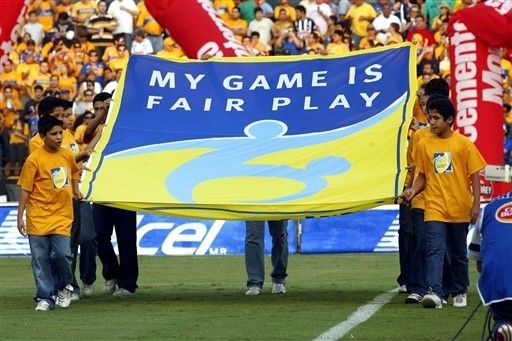 This article was inspired by a recent post by John Urschel, a mathematician/American football player for the Baltimore Ravens. He's written a few articles now, and such a unique blend of professions has lead to great insight in the sport, something we can hope for but are maybe unlikely to see from our brand of professional footballers anytime soon. www.theplayerstribune.com/john-urschel-ravens-parity-ideal Obviously I recommend reading his article first since it's the basis of this piece but, to summarise, he looks into the parity of the 4 major league sports in America (NBA, NFL, MLS, and NHL) also known as the Big 4. He does this by analysing 2 main factors in order to distinguish how "fair" each league is:
This article was inspired by a recent post by John Urschel, a mathematician/American football player for the Baltimore Ravens. He's written a few articles now, and such a unique blend of professions has lead to great insight in the sport, something we can hope for but are maybe unlikely to see from our brand of professional footballers anytime soon. www.theplayerstribune.com/john-urschel-ravens-parity-ideal Obviously I recommend reading his article first since it's the basis of this piece but, to summarise, he looks into the parity of the 4 major league sports in America (NBA, NFL, MLS, and NHL) also known as the Big 4. He does this by analysing 2 main factors in order to distinguish how "fair" each league is:
- Distribution of wins
- Year on year reversion to the mean
Both of which I'm going to replicate using Premier League data. Distribution of wins Mr. Urshcel found that the "Big 4" Major league sports in the US all had a negative skew of win percentage. In this context this means that "there are more above-average than below-average teams, but more very bad teams than very good ones." 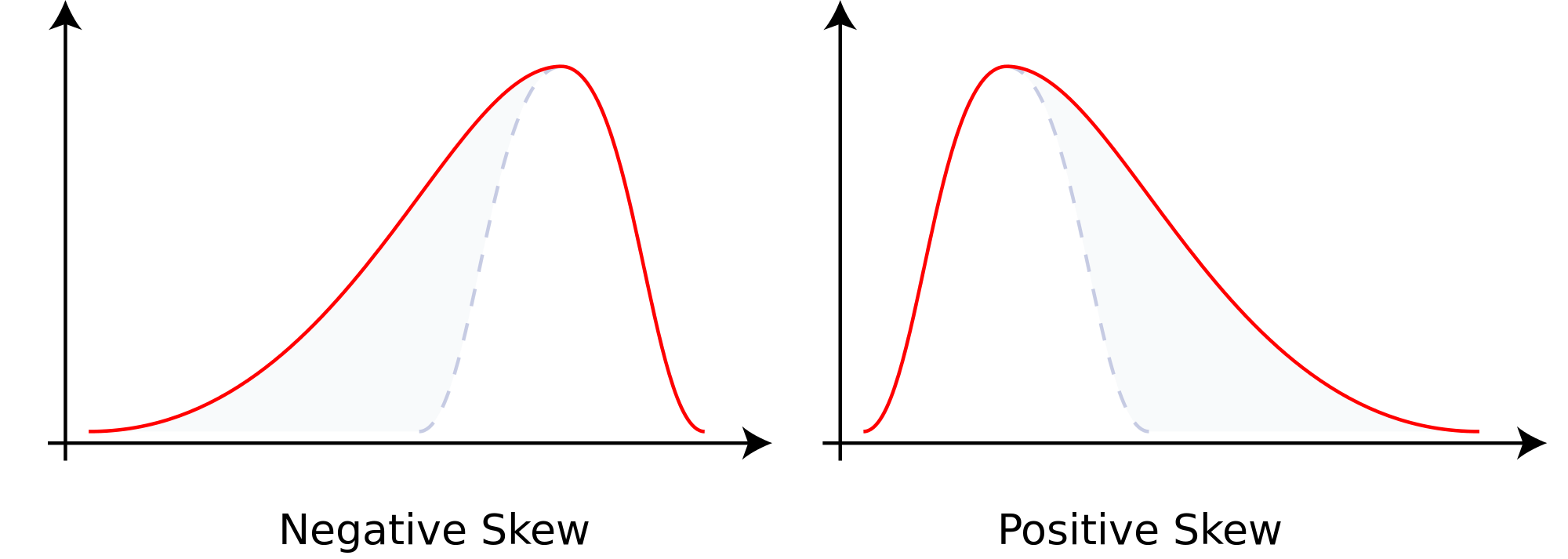 Let's see how the distribution from the Premier League looks. Data is taken since the 2000/2001 season and I've set boundaries as right open (a <= x < b). I have counted draws as half a win so that the data still has a mean of 50%. I also felt like ignoring draws would be ignoring the information that on the day the two teams were relatively evenly matched, and it turns out that the results are the same whether or not draws are included.
Let's see how the distribution from the Premier League looks. Data is taken since the 2000/2001 season and I've set boundaries as right open (a <= x < b). I have counted draws as half a win so that the data still has a mean of 50%. I also felt like ignoring draws would be ignoring the information that on the day the two teams were relatively evenly matched, and it turns out that the results are the same whether or not draws are included. 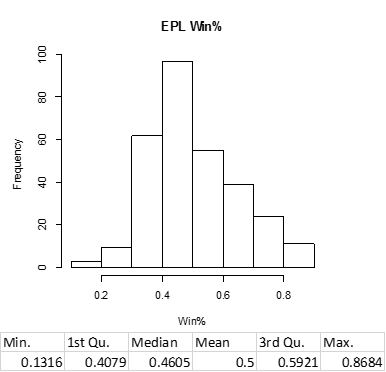 Unlike the Big 4 leagues, the Premier League has a noticeable positive skew with a fairly wide spread of records between teams. It follows that the distribution of average and extreme teams is also different.
Unlike the Big 4 leagues, the Premier League has a noticeable positive skew with a fairly wide spread of records between teams. It follows that the distribution of average and extreme teams is also different. 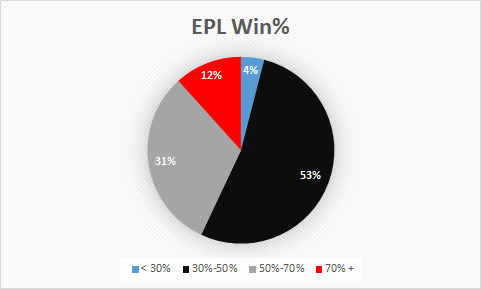 The majority of Premier League teams are actually slightly below average, and there are more "very good" teams than "very bad" teams. It seems like the level of fairness in the premier league is opposite of what has been attained in the major leagues. Instead of teams being highly competitive in fighting to become elite, Premier league teams tend to be highly competitive in fighting to avoid relegation. The chart shows that each year there are generally 2 or 3 "elite" teams battling for the title, whereas on average you would expect less than 1 team that could be considered significantly worse than the rest of the lower half. I'll have to test the for similarities in the other top European leagues but this type of positive skew seems like it would roughly fit the other top 3 leagues, with each seeming to have 2 or 3 elite teams and the majority of teams being slightly below average. Year on year reversion to the mean In a fair league you would, over time, expect teams to revert to the mean more often than not, and John Urschel provides evidence of this in each of the Big 4 leagues. In the Premier League however this is not the case.
The majority of Premier League teams are actually slightly below average, and there are more "very good" teams than "very bad" teams. It seems like the level of fairness in the premier league is opposite of what has been attained in the major leagues. Instead of teams being highly competitive in fighting to become elite, Premier league teams tend to be highly competitive in fighting to avoid relegation. The chart shows that each year there are generally 2 or 3 "elite" teams battling for the title, whereas on average you would expect less than 1 team that could be considered significantly worse than the rest of the lower half. I'll have to test the for similarities in the other top European leagues but this type of positive skew seems like it would roughly fit the other top 3 leagues, with each seeming to have 2 or 3 elite teams and the majority of teams being slightly below average. Year on year reversion to the mean In a fair league you would, over time, expect teams to revert to the mean more often than not, and John Urschel provides evidence of this in each of the Big 4 leagues. In the Premier League however this is not the case. 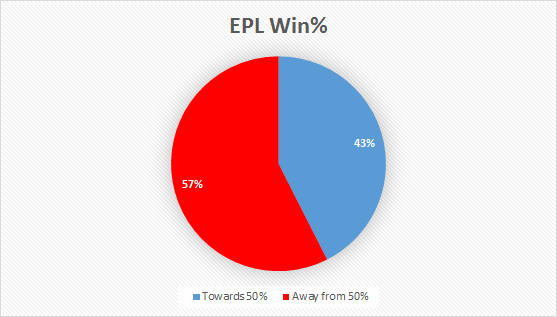 It's a clear case of "The rich get richer and the poor get poorer". Ideally a league would want at least 50% of teams reverting to the mean or else disparity can occur between the top and lower tiers of the league, which seems to have occurred here. The differing structure of the Premier League, mainly the prevalence of relegation, does influence the numbers slightly. Each season 3 teams that probably would have reverted to the mean don't get the chance to due to relegation. Even if you assume all 3 relegated teams will definitely improve next year then the percentage of teams that revert to the mean would still be <52%, only slightly better than if the league was completely random and still significantly less than the Big 4. Relegation itself though is a cause of disparity, the fact that that the worst 3 teams get relegated only augments the inequality in the league, since teams that perform poorly may not even get a chance to improve. Pair this with the financial reward of playing in Europe, given to the teams at the top of the table, and it's easy to see why the spread of success amongst Premier League teams is nothing like that which we see in America. I think this shows how the introduction of salary caps, drafts etc. have helped maintain relative parity within the Big 4 leagues, and how much of an unbalance can occur if there is no real effort made in maintaining parity. There have been a few attempts to create a more level playing field, with TV money providing some of the poorer teams with an increased opportunity for investment in the club, but it is no where near enough if parity is to be seen as a target for the Premier League. A tiered football league may create enjoyment for teams climbing up the ladder but the current system means no team has a chance at becoming an elite club without a large cash injection from outside investors. I'm not sure if the majority of fans are happy with the structure and level of equality within the Football League but one things for sure, the Premier League is certainly not a level playing field.
It's a clear case of "The rich get richer and the poor get poorer". Ideally a league would want at least 50% of teams reverting to the mean or else disparity can occur between the top and lower tiers of the league, which seems to have occurred here. The differing structure of the Premier League, mainly the prevalence of relegation, does influence the numbers slightly. Each season 3 teams that probably would have reverted to the mean don't get the chance to due to relegation. Even if you assume all 3 relegated teams will definitely improve next year then the percentage of teams that revert to the mean would still be <52%, only slightly better than if the league was completely random and still significantly less than the Big 4. Relegation itself though is a cause of disparity, the fact that that the worst 3 teams get relegated only augments the inequality in the league, since teams that perform poorly may not even get a chance to improve. Pair this with the financial reward of playing in Europe, given to the teams at the top of the table, and it's easy to see why the spread of success amongst Premier League teams is nothing like that which we see in America. I think this shows how the introduction of salary caps, drafts etc. have helped maintain relative parity within the Big 4 leagues, and how much of an unbalance can occur if there is no real effort made in maintaining parity. There have been a few attempts to create a more level playing field, with TV money providing some of the poorer teams with an increased opportunity for investment in the club, but it is no where near enough if parity is to be seen as a target for the Premier League. A tiered football league may create enjoyment for teams climbing up the ladder but the current system means no team has a chance at becoming an elite club without a large cash injection from outside investors. I'm not sure if the majority of fans are happy with the structure and level of equality within the Football League but one things for sure, the Premier League is certainly not a level playing field.
Everton: Where Is The Luck?
Everton With plenty of attacking thrills in the shape of Romelu Lukaku, Ross Barkley and Gerard Deulofeu, it is easy to see why people have warmed to Everton this season. However, this bed of attacking roses has found its beauty tempered by a proliferation of defensive brambles. For every sublime Deulofeu cross bouncing invitingly onto the fringe of the six yard box, we find John Stones mysteriously alongside Barkley somewhere in central midfield with the team out of possession. We see Lukaku arriving a yard from goal with the trajectory and velocity expected from a turnbuckle dismount while Gareth Barry attempts to direct the chaos around him from the age-enforced position of a sentry. Aaron Lennon continues to look "not bovvered" by anything and Tim Howard rues the double crossed deal he made with the footballing Gods during the last World Cup. But by heck is he trying. There have also been media story lines this year that decided, predominantly driven by starry-eyed viewers drinking down the good stuff, that Everton have been "unlucky". With nearly half the team's shots derived from the boots and foreheads of Barkley and Lukaku (135/282) we have evidence of clear strategy but statistical categories offer diverging insights. So we have a bit of a puzzle. Is this Everton side actually any good? Or are they a Ramiro Funes Mori away from completing another season of pretty but ultimately futile football? All the while comfortable in the knowledge that they are far too good to get sucked into the nether regions of the table; a bit like Newcastle, or at least a bit like Newcastle used to be before they forgot their whole strategy was to get enough points to survive by Christmas. Numbers In basic terms, Everton have won six games from twenty-two, which isn't good and is the same as struggling outfits such as Chelsea or Norwich. On the flip side we have a mere five defeats: the same as Manchesters City and United. If we trudge over to the public expected goals number of Paul Riley, we find them 13th and overachieving by ten goals yet Michael Caley has recently had them around 7th or 8th but only slightly overachieving their goal difference by about three. Seventh seems to reflect a good side, thirteenth less so but there's been enough teeth gnashing around to feel that not everyone is content with the efforts of the nicest guy in football, Roberto Martinez. Pointedly, these numbers seem to suggest they've been fortunate; the opposite of the media view. The thing is they are currently 11th; which when held up against these numbers tells me very little. To project around mid table and be around mid table doesn't suggest a whole lot of luck at either end, so what is going on? 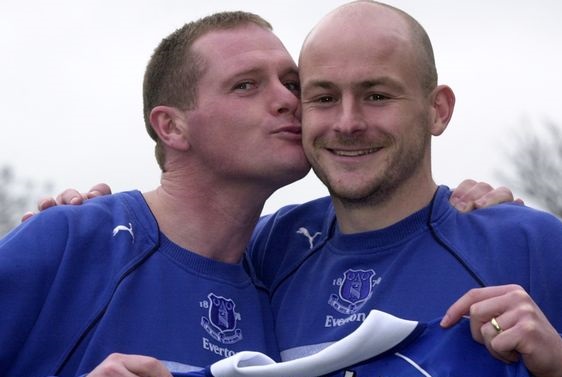 Further numbers Part of what made me ponder Everton was noting their very high shot conversion rates. Both they and Leicester have been converting all their shots at over 13% and their shots on target at over 38% (Everton actually hit 40% this week). No other team is above 12% or 35% respectively giving both teams a steady advantage on the front end. Partly this is why Leicester remain in an unlikely title contending position where more repeatable shooting numbers suggest they are at best European contenders. In fact, season long figures for Everton and Leicester look remarkably similar:
Further numbers Part of what made me ponder Everton was noting their very high shot conversion rates. Both they and Leicester have been converting all their shots at over 13% and their shots on target at over 38% (Everton actually hit 40% this week). No other team is above 12% or 35% respectively giving both teams a steady advantage on the front end. Partly this is why Leicester remain in an unlikely title contending position where more repeatable shooting numbers suggest they are at best European contenders. In fact, season long figures for Everton and Leicester look remarkably similar: 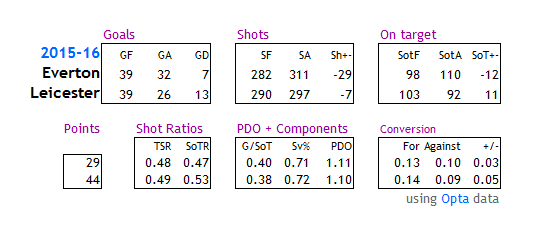 Leicester have an edge here but how does it account for fifteen points and ten places in the table? Well, this is variance in action. In the majority of multiverses in which this league is being played we find these teams among the fringes of European challengers, hoping to kick on but coveting safe passage more than tangible glory. This reality is better described in margins. In close games this season (those that finished with a goal or less between the two teams) Leicester are 10-7-1, a fantastic and unlikely to maintain record. Everton, draw specialists, have managed a far less points-lucrative 2-11-3. Yet when Everton have won they have done so with some aplomb:
Leicester have an edge here but how does it account for fifteen points and ten places in the table? Well, this is variance in action. In the majority of multiverses in which this league is being played we find these teams among the fringes of European challengers, hoping to kick on but coveting safe passage more than tangible glory. This reality is better described in margins. In close games this season (those that finished with a goal or less between the two teams) Leicester are 10-7-1, a fantastic and unlikely to maintain record. Everton, draw specialists, have managed a far less points-lucrative 2-11-3. Yet when Everton have won they have done so with some aplomb:
- Southampton away 3-0,
- heaping misery on Mourinho by beating Chelsea 3-1,
- a 3-2 win at West Brom,
- 6-2 against Sunderland,
- 4-0 versus Aston Villa.
A 1-0 victory against Newcastle is the single dull victory they have managed, so when they've been winning it's been attention grabbing stuff. Everyone remembers a couple of crushing Everton wins, right? They must be a good side! So how come they are in mid-table? They must be unlucky... And so the narrative builds. Then we go back through the analytical lens and we find the opposite: these sporadic demolitions have had a powerful effect on their measured shooting and conversion numbers. The positive extremes created that seem to indicate good luck are derived from a very small bunch of fixtures, we've seen six wins by an average of 2.5 goals yet five defeats by smaller margins: an average of 1.6 goals per game. The Everton front end has scored 20 goals in six wins and 19 in eleven draws and five defeats. In fact Everton lead the league in "average margin of victory", something I totted up to see if the theory held: 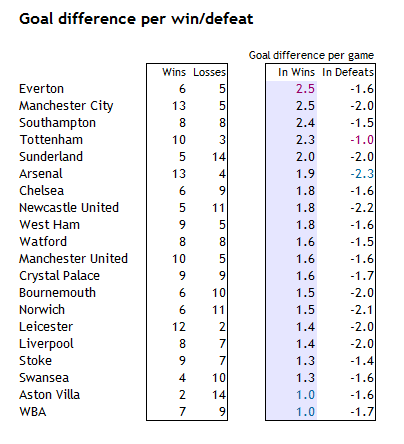 They may have won infrequently but they've when they have they have won well. This is why there is seemingly nowhere to go for Everton, pull a couple of big results out of the analysis and the rest of their games reflect quite a flat season, neither particularly lucky or unlucky, sometimes strong in attack, other times weak in defence, par numbers, mid table numbers. The kind of team that can go to the Etihad and pull off a 0-0 on a good day or lose 4-3 at home to Stoke when full of Christmas pudding. In a nutshell, an average Premier League side. Given long term fan concerns regarding investment and ownership, maintaining a position in the league in such a financially vital season is probably a fair and dispassionate target: it is what is good for the club, but when memories of Moyes and European slots are still fresh and trophies and glory still sit close to the hearts of older fans, to bounce inconsistently along doesn't quite sate desire. The £40 million for Stones, if ever on the table, could have gone a long way. It remains to be seen if it arrives again. edit: I've been kindly reminded by Paul Riley of Paul Riley's Everton season preview here on StatsBomb. Seems he wasn't too far off the mark with a 10th to 11th prediction and defensive warnings: there's truth in the numbers. ________________ Thanks for reading! Bored at work? Check out Flavio Fusi's Half Season Serie A review Dustin Ward's two part Bundesliga Round Up (Part 1, Part 2) Mohamed Mohamed's spin on Aston Villa
They may have won infrequently but they've when they have they have won well. This is why there is seemingly nowhere to go for Everton, pull a couple of big results out of the analysis and the rest of their games reflect quite a flat season, neither particularly lucky or unlucky, sometimes strong in attack, other times weak in defence, par numbers, mid table numbers. The kind of team that can go to the Etihad and pull off a 0-0 on a good day or lose 4-3 at home to Stoke when full of Christmas pudding. In a nutshell, an average Premier League side. Given long term fan concerns regarding investment and ownership, maintaining a position in the league in such a financially vital season is probably a fair and dispassionate target: it is what is good for the club, but when memories of Moyes and European slots are still fresh and trophies and glory still sit close to the hearts of older fans, to bounce inconsistently along doesn't quite sate desire. The £40 million for Stones, if ever on the table, could have gone a long way. It remains to be seen if it arrives again. edit: I've been kindly reminded by Paul Riley of Paul Riley's Everton season preview here on StatsBomb. Seems he wasn't too far off the mark with a 10th to 11th prediction and defensive warnings: there's truth in the numbers. ________________ Thanks for reading! Bored at work? Check out Flavio Fusi's Half Season Serie A review Dustin Ward's two part Bundesliga Round Up (Part 1, Part 2) Mohamed Mohamed's spin on Aston Villa
Serie A 2015-16: Half Season Review
In October, fellow StatsBomb writer Dustin Ward had a look at the wild title race in Italy.
Three months later, at the halfway of the Serie A season there are still a handful of team fighting for the Scudetto, with Juventus and Napoli as the most believable contenders according to the bookmakers.
Napoli
League Rank 1st Points 41 Shots Rank 1st Shots Conceded Rank 4th TSR Rank 3rd
Thanks to a 5-1 thrashing of Frosinone, Napoli won their first “winter title” since 1989/90 and lead the league at the halfway. In just six months, new manager Maurizio Sarri turn the 5th placed team of last year in a Scudetto favourite. In comparison to last season the Partenopei have improved their efficiency at both ends of the pitch: Napoli have increased their 1.84 goals scored per game to 1.95 and above all they got way better defensively moving from the 1.42 goals conceded per game which denied their title hopes last season, to 0.79 this season.
Napoli are the most powerful Serie A offensive force in pretty much every category, TSR excluded: they lead the league in goals scored (38), goal difference (+23), chances created (262) shots attempted (327), shots on goal attempted (118), passes in the last third (1584) and SoTR (71.5%). Their conversion rate (11.6%) is the 5th best in Italy, but it’s not much greater of the league average (~10%), while their 32.2% shots on target conversion (7th best in the league) is pretty much average, suggesting a long term sustainability of their attacking performance level. Sarri’s team is benefiting of one of the most dominant striker the Italian league has seen in ages: the 2015/16 version of Gonzalo Higuaín.
Higuaín’s season so far is better than every of his or Edinson Cavani’s Napoli seasons and in Europe's top-5 leagues just Pierre-Emerick Aubameyang has scored as many as him (18 goals). The Argentinean's 0.95 non-penalty goals p90 are unrivalled in Serie A, meaning that Higuaín has already staked a claim on the top-goalscorer title.
The only other strikers in history with 30+ goals in a single Serie A season are Luca Toni (31 goals in 38 games in 2005/06), Antonio Angelillo (33 goals in 33 games in 1958/59) and Gunnar Nordhal (35 goals in 37 games in 1949/1950 and 34 in 37 the following season).
At this rate all their records are in serious danger. Thanks to Sarri’s defensive organization and with the same centre-back pairing of last season, Napoli have conceded the 4th fewest amount of shots (187) and the 3rd fewest amount of shots on target (47), while only Juve conceded a fewer amount of xG according to Michael Caley’s data. Other good news for the Azzurri: over the last 9 seasons, the Serie A title has always been won by the team who were top of the table after 19 match-days.
Juventus
League Rank 2nd Points 39 Shots taken Rank 2nd Shots conceded Rank 2nd TSR Rank 1st
In October, after the first 10 Serie A games, Juventus had collected just 12 points, and they sat at 12th place on the table, 11 points away from then leaders Roma. Their underlying numbers were still excellent (they have essentially led in TSR for the entire season), but they had a considerable amount of bad luck in a period where Allegri was trying to find the right balance for the team, after the departures of Tévez, Vidal and Pirlo. A comeback was predictable but a fifth consecutive Scudetto seemed out of their reach.
Note: averages for the last 10 Serie A season. With a rough estimation (credit to Max Allegri) 82 points should be enough to win the league this season.
19 games into the league, Max Allegri has probably found that balance considering that Juve have won 9 games in a row and climbed to 2nd place in the table. The emergency of Dybala (5 goals and 4 assists in his last 8 games) and an in-form Mario Mandžukić (the Bianconeri have won every game in which the Croatian has scored) have contributed to raise their conversion rate to a level that fits league average (10.7%), while the comeback from injuries of the likes of Claudio Marchisio and Sami Khedira, combined with the return to the good old 3-5-2, gave the team the necessary stability in both phases of play: they now rank 6th in conversion rate against (8.9%), while no other team has recorded a lower opposition xG. Other underlying numbers like shots taken (307, 2nd best in the league), shots on target taken (97, 3rd best tied with Fiorentina), SoTR (68.3%, 2nd), shot conceded (169, 2nd), shots on target conceded (45, lowest amount tied once again with Fiorentina) reinforce Juventus' title hopes. But first they have to bare the roots of Napoli.
Inter
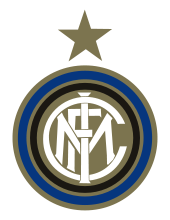
League Rank 3rd Points 39 Shots taken Rank 7th Shots conceded Rank 8th TSR Rank 8th
At the start of the season Inter's realistic target was European qualification: 19 games into the season their shot numbers are perfectly in line with a team chasing an Europa League spot. So what’s the problem then?
Well the “problem” it’s that they started 2016 at the top of the league, and after losing to Sassuolo they now sit 3rd, with the same amount of points of 2nd placed Juventus and with league leaders of Napoli just 2 points away. Inter have been able to build their point tally recording an astonishing conversion against of 5.2%.
Basically while every other team's shots against are converted at an average rate of 1 every 10 attempts, you need 10 more shots to put the ball into Samir Handanovic’s goal. Handanovic himself is probably the main contributor to this figure, since he has conceded just 12 goals and has kept 12 (!) clean sheets over the course of 19 games. The Inter goalkeeper has saved a resounding 85.5% of the 83 shots on target he has faced, remarkably over-performing his 70.3% career save rate. Just seven teams in the last seven Serie A championships have concluded a season with a SoT conversion against lesser than 20.0%.
Offensively Inter are just an average team: there are seven teams, including AC Milan and Chievo, which have scored more than Inter's 24 goals. Moreover if we consider they put 4 goals past Frosinone and Udinese, they have scored 16 goals in the remaining 17 games, scoring more than a goal in just another occasion (2-1 at Carpi) and winning 10 games by a single goal margin, upholding the fact that they build their victories on their compact defence. Also, they are pretty average at creating scoring chances (193, 7th in the league).
Mancini’s team has surely improved defensively with the likes of João Miranda and Jeison Murillo joining the team and with another destroyer like Felipe Melo partnering Gary Medel in the middle of the pitch. However Inter are not good as Juve or Napoli at preventing high-quality chances and considering the amount of shots (229, 8th) and shots on target (83, 12th) they have faced I would not be surprised to see a concrete regression in the second half of the season, especially if they will not be able to fix their relative offensive sterility. Inter concluded the year with a 9-3-1 record in games decided by a single goal which is a performance rarely sustainable over the course of an entire season.
That their record is already 10-3-3 suggests that their regression is already in progress.
Fiorentina
League Rank 4th Points 38 Shots taken Rank 3rd Shots conceded Rank 1st TSR Rank 2nd
Under Vincenzo Montella, Fiorentina collected four consecutive 4th places. At the halfway point of the 2015/16 season, the first under new manager Paulo Sousa, they sit once again at 4th even if only Inter have led the league for more weeks than la Viola. Montella’s style of play was already possession based but still Sousa found enough margin to increase this feature of Fiorentina’s philosophy.
They lead the league in average possession (62.7%) and passing accuracy (86.6%). Fiorentina have scored the second highest amount of goals in Serie A this season (37), and they have now scored in 26 consecutive Serie A games, converting 8 penalties this season, an amount that is unlikely to be doubled up in the second part of the season. Their shots number alone are very good, since they have recorded the 3rd highest amount of shots (228), but we have to consider that the 56% of those shots have been attempted from outside the box. Like many possession based teams, sometimes Fiorentina lack penetration and so they seek help from long range shots more often than any other team in the league. In their style of play, newly acquired striker Nikola Kalinić fulfils a pivotal role.
When Fiorentina are in possession the Croatian impressive movements are fundamental to almost every play of the Tuscans, because he is equally able in attacking the depth himself or in opening space for his team-mates to run into. As Sander Ijtsma pointed out on Twitter a month ago, no other Serie A team create for their striker a volume of shots so close to goal as Fiorentina do for Kalinić, but if we exclude him, the average shooting positions of his team-mates are out of the box or just inside it.
However the vast amount of time Fiorentina spend on the ball, also thanks to an effective implementation of pressing and counterpressing, gives them a decisive defensive edge. They are league leaders in shots conceded (162) and tie with Juventus in least shots on goal conceded (45). The problem is that even if they have conceded a relative small volume of shots their opponents convert those attempts quite easily. Ciprian Tatarusanu has saved just 57.8% of the shots on goal he has faced, a league worst among keepers with 900+ minutes played. Fiorentina's overall conversion against is slightly better (11.7%), but still worse than league average.
Even so, xG conceded suggest they are not remarkably under-performing. Basically they concede few chances, but the chances they do concede are largely dangerous. Fiorentina have been the only team putting 4 goals past Inter, but if we exclude that exploit at the San Siro they have lost against the other top-5 teams (Fiorentina 1-2 Roma, Napoli 2-1 Fiorentina, Juventus 3-1 Fiorentina). All in all a fifth consecutive fourth place would be very good for la Viola and Champions League qualification would be a success.
Roma
League Rank 5th Points 34 Shots taken Rank 4th Shots conceded Rank 7th TSR Rank 6th
In two seasons under Garcia, Roma were the only team able to worry Juve, even if in both occasion they finished 2nd with a 17 points gap. Given the initial struggles of the Bianconeri, many had Roma as their Scudetto favourite back then.
After their 2-1 win in Firenze (in which they recorded the worst possession % of the last 10 years) they topped the league, 699 days after the last time. But then started the crisis which lead to Garcia’s sacking and the recent appointment of Luciano Spalletti. Roma have won just 3 of their last 10 matches and just 1 of their last 5.
They have already conceded 22 goals (4 from the penalty spot): last year they conceded 31 all season, two years ago just 25 in total. The main issue is that their opponents are not riding on conversion, since Roma goal conversion against is essentially league average (10.2%) and their shots on target conversion against of 28.2% is 3% better than the league standard (but still 14% worse than Inter!). It is not the end of the story, however.
Their xG and their conversion, a 2nd best in the league 13.1%, suggest that they are also over-performing in terms of goals scored. Spalletti’s second experience on the helm of Roma will start uphill, but at least it would be difficult to make worse than the first 19 games of his predecessor. No matter how, with 7 points less than Napoli, the Giallorossi’s all-desired shot at title has most likely vanished.
Rest of the league trivia Sassuolo – If Serie A would be contended by the top-5 teams and Sassuolo only, the Neroverdi would sit 1st .
Empoli - Empoli went ahead in 14 league games this season (W9, D3, L2), only Fiorentina (15) made better among Serie A teams
AC Milan - AC Milan have had only 11.7% non-blocked shots conversion in this Serie A, in 14-15 they had recorded the highest in the league (17.2%).
Lazio – Pioli’s team has conceded just the 3rd least amount of shots, but the 40.3% of those attempts have been on goal. That’s a league worst and considering their xG numbers too, it is likely that their second part of the season would be better.
Chievo – Last year Chievo scored a league worst 28 goals. This season they have already scored 25 times.
Atalanta - Atalanta 10 red cards this season are a record among Euro top-5 leagues.
Udinese - Antonio di Natale has failed to score in his last 9 matches, his longest scoring drought since 2006. The 38 years old striker will probably hang up his boots at the end of the season.
Sampdoria - Thanks to 11 goals and 2 assists Éder have contributed to the 46% of Sampdoria goals. Only Higuaín have had a greater influence on his team.
Torino - Torino recouped 10 of their 22 points from trailing situations.
Bologna - Bologna collected 16 points in 10 matches under Roberto Donadoni, and just 6 in 9 with Delio Rossi at the helm.
Palermo - With the recent hiring of Gustavo Schelotto, Maurizio Zamparini has now hired 46 different managers over the course of his 28 years as a football president.
Genoa - Genoa have lost 5 of their last 6 matches. Last year they finished 6th, now they have just 4 points over relegation zone.
Frosinone – Frosinone have conceded 384 shots, a negative record in Euro top-5 leagues. Their matches feature the highest amount of shots of the entire league (32.5 per game).
Carpi - Carpi have converted a league worst 7.7% of their shots. However they are unbeaten in 2016 (1W-1N).
Hellas Verona – Verona are the fifth team in Serie A history winless at the halfway point. With just 8 points collected so far, they are already virtually relegated.
Conclusion
Serie A title race is still very much open, but Napoli and Juventus are the two teams who will most likely fight until the end. Fiorentina and Roma could take advantage of a probable drop in Inter level of overperformance and compete for the 3rd spot the last available for Champions League qualification. Hellas Verona have been historically bad and they are almost already in Serie B. Frosinone and Carpi have been bad on a similar level and I don't think they could overcome better established teams like Genoa or Palermo in their fight to avoid relegation.
Thanks for reading.
(All data originally from OPTA)
The Bundesliga at the Break: The Rest of the League
So we covered Bayern and Dortmund last week but there are 16 more teams to go as we recap the first half of the Bundesliga. If you loved reading about Lewandowski, Costa, and Reus surely you can't turn down a chance to read about Pascal Groß, Vladimir Darida, and Anthony Modeste even more. Let's begin with the race for 3rd: Schalke  At the start of the year they looked the least likely of the Big 6 to grab a Champions League spot and while they are a point ahead of Wolfsburg at the break, not much has changed there.
At the start of the year they looked the least likely of the Big 6 to grab a Champions League spot and while they are a point ahead of Wolfsburg at the break, not much has changed there.  The most notable accomplishment of a bland first half is the symmetry they reached with exactly 23 goals for and against along with exactly 253 shots for and against. Both are solidly above the league average, meaning if you like to see attacking play from both teams, Schalke haven't been a bad watch. The Revierderby with Dortmund was one of the most entertaining games of the year so far. One of the big reasons they don't look like a true contender for the Champions League places has been the ease at which opponents cut through the midfield. Their defensive passing map tells the story:
The most notable accomplishment of a bland first half is the symmetry they reached with exactly 23 goals for and against along with exactly 253 shots for and against. Both are solidly above the league average, meaning if you like to see attacking play from both teams, Schalke haven't been a bad watch. The Revierderby with Dortmund was one of the most entertaining games of the year so far. One of the big reasons they don't look like a true contender for the Champions League places has been the ease at which opponents cut through the midfield. Their defensive passing map tells the story: 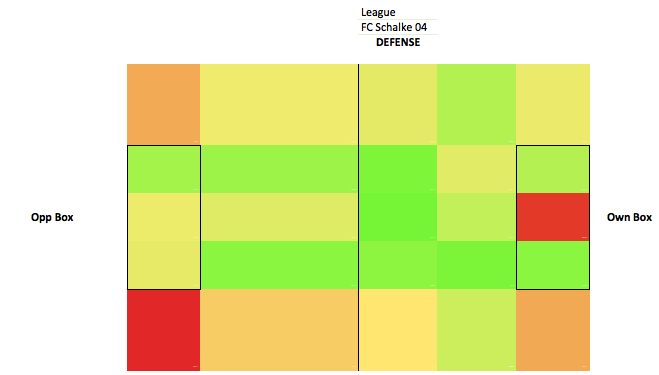 They have been able to keep opponents from getting high quality shots from these strolls through the center, and a lot of the credit has been given to Joel Matip, the in-demand center back who has popped up on several teams of the year and is rumored to be heading to Liverpool. If that's true, it probably does not reflect well on the entire team set up that one single player gets so much credit on a team muddling along in 6th with a 0 goal difference. Before I get too negative, I will point out this has been a step forward from the disastrous and short Di Matteo experiment of last season where Schalke were below par in both shots and territory. Only Stuttgart has seen their TSR improve as much as Schalke has from last year to now. That's not that surprising for a team with such a big payroll following a down year but it's not good enough to be a true contender for the Champions League without further improvement.
They have been able to keep opponents from getting high quality shots from these strolls through the center, and a lot of the credit has been given to Joel Matip, the in-demand center back who has popped up on several teams of the year and is rumored to be heading to Liverpool. If that's true, it probably does not reflect well on the entire team set up that one single player gets so much credit on a team muddling along in 6th with a 0 goal difference. Before I get too negative, I will point out this has been a step forward from the disastrous and short Di Matteo experiment of last season where Schalke were below par in both shots and territory. Only Stuttgart has seen their TSR improve as much as Schalke has from last year to now. That's not that surprising for a team with such a big payroll following a down year but it's not good enough to be a true contender for the Champions League without further improvement. 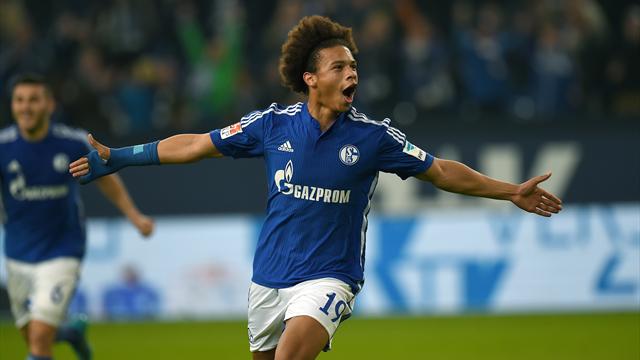 The man of the moment is Leroy Sané. He's an example of the importance of scouting when it comes to transfers. His numbers are fine enough passing, dribbling, and defending when compared to other wingers of similar repute. His main edge over your standard good winger has been his ability to get inside the box to get shots off.
The man of the moment is Leroy Sané. He's an example of the importance of scouting when it comes to transfers. His numbers are fine enough passing, dribbling, and defending when compared to other wingers of similar repute. His main edge over your standard good winger has been his ability to get inside the box to get shots off. 
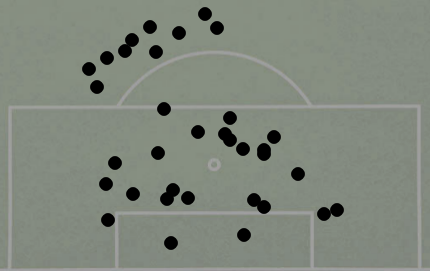 Sané can be a little peripheral at times during games and doesn't create a huge amount for his teammates, but the guy is still 20. His statistical profile is one of a very good attacking player, maybe even great. Is he good enough for Barcelona and Manchester City? That's probably beyond a simple statistical analysis. We can flag him as a generally very good prospect but the underlying skills, work ethic, and ability to learn remain beyond the spreadsheet. Leverkusen
Sané can be a little peripheral at times during games and doesn't create a huge amount for his teammates, but the guy is still 20. His statistical profile is one of a very good attacking player, maybe even great. Is he good enough for Barcelona and Manchester City? That's probably beyond a simple statistical analysis. We can flag him as a generally very good prospect but the underlying skills, work ethic, and ability to learn remain beyond the spreadsheet. Leverkusen 
 It was a disappointing first half for Schmidt's side, Chicharito's goal totals and American TV numbers aside. While Bayern and Dortmund saw their games move forward, Leverkusen saw their game drop a little in the first half despite seeming ready to make the leap when the season kicked off. The crazy press that they are known for has slacked a slight bit this season, opponents are completing more passes (even been pipped by Ingolstadt in the high press deparment) and more worryingly are getting it into dangerous areas significantly more often.
It was a disappointing first half for Schmidt's side, Chicharito's goal totals and American TV numbers aside. While Bayern and Dortmund saw their games move forward, Leverkusen saw their game drop a little in the first half despite seeming ready to make the leap when the season kicked off. The crazy press that they are known for has slacked a slight bit this season, opponents are completing more passes (even been pipped by Ingolstadt in the high press deparment) and more worryingly are getting it into dangerous areas significantly more often. 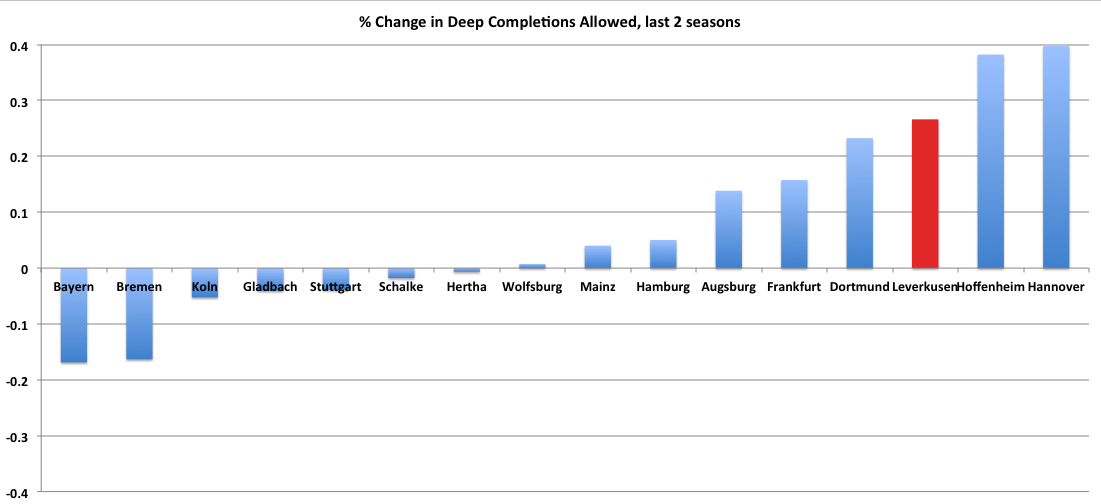 They don't have the game state reason that Dortmund do (Dortmund are ahead 53% of the time this year compared to just 28% last season which usually leads to more deep completions and shots allowed). Leverkusen actually lead only 22% of the time this season compared to 34% and trail equally more. This data suggests this fall is even worse than it appears at first blush. This slowdown on defense might conceivably be a part of an attempted tactical shift. I long clamored for Leverkusen to try to play with the ball more, as they often lost it carelessly while rushing forward. This year that has changed as they are completing 65% of their passes in the opposition half, well up from last years below league average 58%. The pace of play has slowed as significantly fewer passes are being bombed into the final third. The improved ball control hasn't quite translated to the fundamental metrics. Deep comps are level to last year, shots down a bit. There are lots of individual performances that seem impressive (Chicharito, Wendell, Kampl, and Calhanoglu in particular) and visually Leverkusen still look great sporadically but something just isn't quite adding up. The seeming attempted change in strategy hasn't made the attack any better and has taken away from their identity of high pressure D that flusters opponents. Opponents can actually feel comfortable with the ball near Leverkusen's goal this season, that's something that just never happened when they were at their best. Last year they forced opponents into hopeful long balls when attacking, while this year they are very close to league average there.
They don't have the game state reason that Dortmund do (Dortmund are ahead 53% of the time this year compared to just 28% last season which usually leads to more deep completions and shots allowed). Leverkusen actually lead only 22% of the time this season compared to 34% and trail equally more. This data suggests this fall is even worse than it appears at first blush. This slowdown on defense might conceivably be a part of an attempted tactical shift. I long clamored for Leverkusen to try to play with the ball more, as they often lost it carelessly while rushing forward. This year that has changed as they are completing 65% of their passes in the opposition half, well up from last years below league average 58%. The pace of play has slowed as significantly fewer passes are being bombed into the final third. The improved ball control hasn't quite translated to the fundamental metrics. Deep comps are level to last year, shots down a bit. There are lots of individual performances that seem impressive (Chicharito, Wendell, Kampl, and Calhanoglu in particular) and visually Leverkusen still look great sporadically but something just isn't quite adding up. The seeming attempted change in strategy hasn't made the attack any better and has taken away from their identity of high pressure D that flusters opponents. Opponents can actually feel comfortable with the ball near Leverkusen's goal this season, that's something that just never happened when they were at their best. Last year they forced opponents into hopeful long balls when attacking, while this year they are very close to league average there. 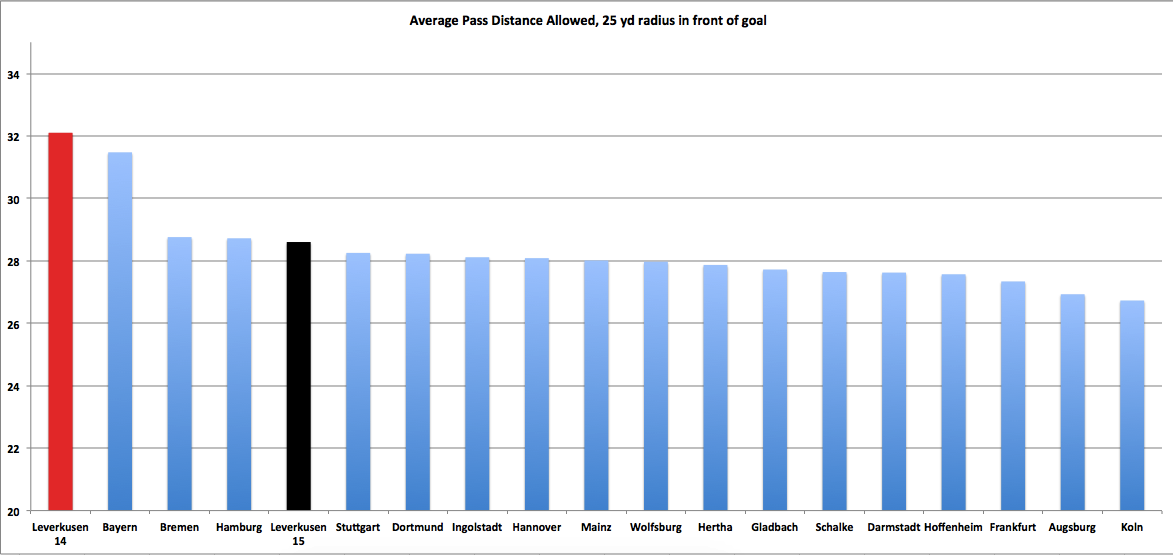 I don't quite understand why it has to be one or the other i.e. why can't Leverkusen be the pressing machine of last season that harries opponents without the ball while playing more calmly with better ball control like this season. They remain the 3rd best team in the league and the most likely of "the rest" to grab Champions League but I really hope we see Schmidt figure it out, because there is a lot more potential here than a team that's slightly better than Gladbach and Wolfsburg.
I don't quite understand why it has to be one or the other i.e. why can't Leverkusen be the pressing machine of last season that harries opponents without the ball while playing more calmly with better ball control like this season. They remain the 3rd best team in the league and the most likely of "the rest" to grab Champions League but I really hope we see Schmidt figure it out, because there is a lot more potential here than a team that's slightly better than Gladbach and Wolfsburg. 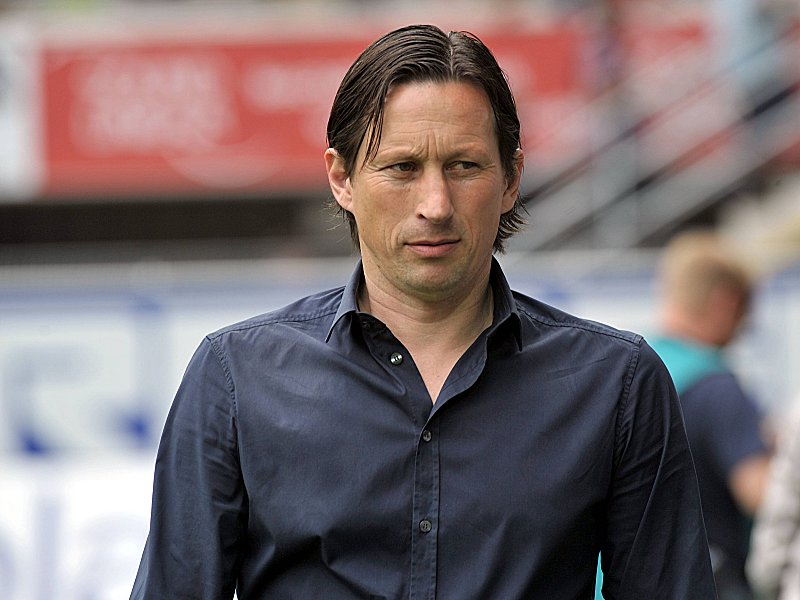
 A little experiment here. Try to guess who is Team A and who is Team B.
A little experiment here. Try to guess who is Team A and who is Team B.  Team B is Hertha Berlin of this season. Clever readers might have sniffed me out and beat me to the shocking reveal at Team A is Hertha Berlin from last season. For those unaware, last season Hertha escaped outright relegation by a single point. This year their shot and deep completion data look essentially exactly the same and they sit in the Champions League spots in 3rd place. Now some things have changed like shot distances being a bit better, but the main difference is Hertha have been much luckier. They are a little better, mainly at holding possession. Last year they had 42% possession, comfortably bottom of the league. This year they are up at 49%. Their completion map shows they are actually showing up a bit this season.
Team B is Hertha Berlin of this season. Clever readers might have sniffed me out and beat me to the shocking reveal at Team A is Hertha Berlin from last season. For those unaware, last season Hertha escaped outright relegation by a single point. This year their shot and deep completion data look essentially exactly the same and they sit in the Champions League spots in 3rd place. Now some things have changed like shot distances being a bit better, but the main difference is Hertha have been much luckier. They are a little better, mainly at holding possession. Last year they had 42% possession, comfortably bottom of the league. This year they are up at 49%. Their completion map shows they are actually showing up a bit this season. 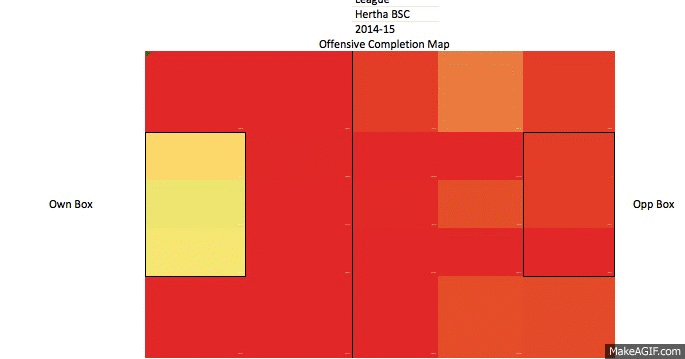 Vladimir Darida has partnered with Per Skjelbred to give Hertha a foothold in midfield. Last year the midfielders were completing around 75%, this year they are at 85%. This foothold and more importantly, the addition of Vedad Ibisevic up top, has let Hertha build a platform to actually compete at a league average rate in front of opposition goal. Last year they completed a historically low rate of passes in front of goal, this year they can actually complete a few of their very passes in front of goal. This improved ball control and competency around goal only counts for so much though, their fundamental numbers are still terrible. They are trailing much less this season, so I expect the base stats to rise a bit in the second half of the season but it won't be good news for Hertha fans. Those stats should rise because they will be trailing more, this still is far from an above average side. A top 6 finish would be fantastic. Gladbach
Vladimir Darida has partnered with Per Skjelbred to give Hertha a foothold in midfield. Last year the midfielders were completing around 75%, this year they are at 85%. This foothold and more importantly, the addition of Vedad Ibisevic up top, has let Hertha build a platform to actually compete at a league average rate in front of opposition goal. Last year they completed a historically low rate of passes in front of goal, this year they can actually complete a few of their very passes in front of goal. This improved ball control and competency around goal only counts for so much though, their fundamental numbers are still terrible. They are trailing much less this season, so I expect the base stats to rise a bit in the second half of the season but it won't be good news for Hertha fans. Those stats should rise because they will be trailing more, this still is far from an above average side. A top 6 finish would be fantastic. Gladbach 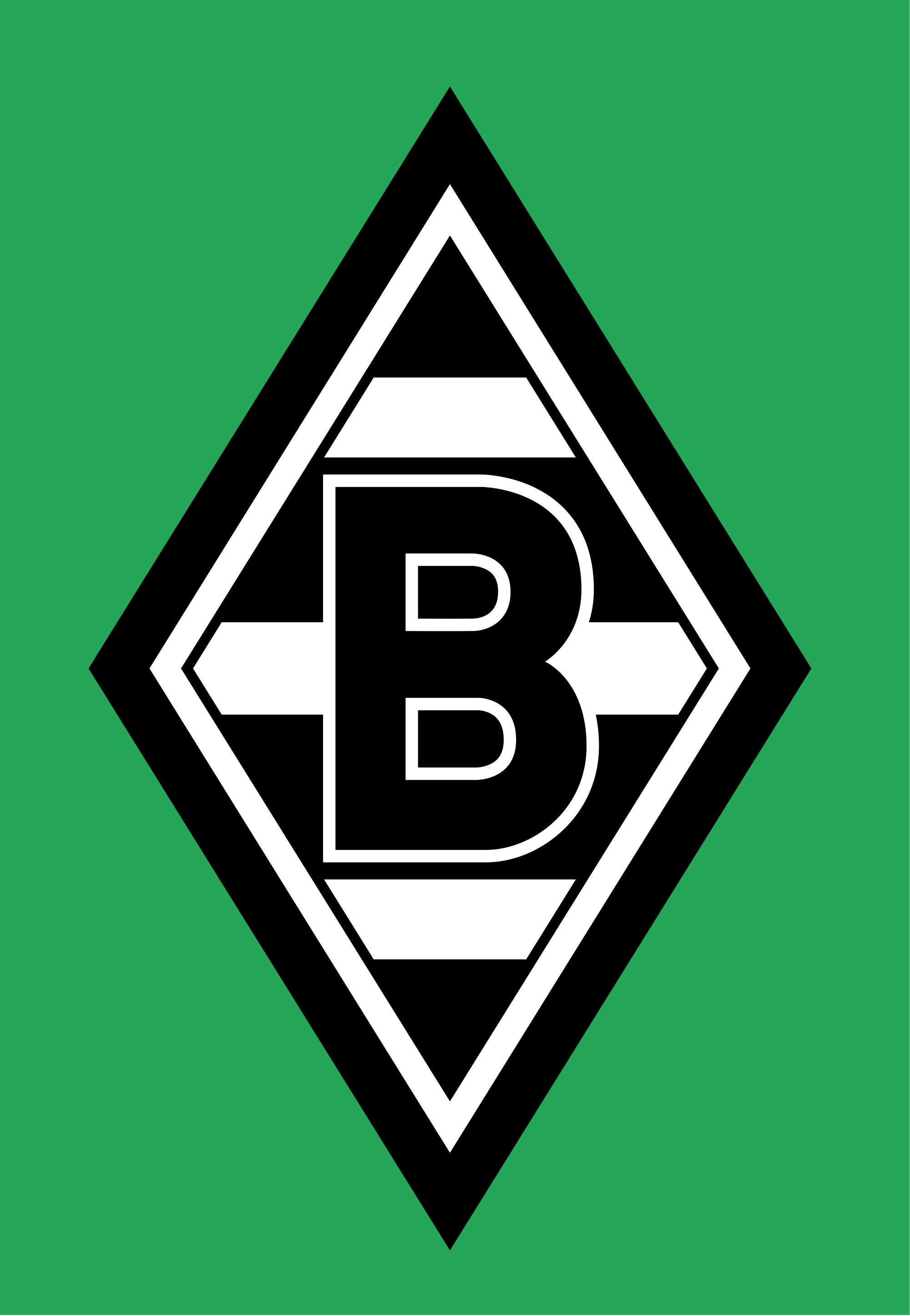
 Gladbach have been a fascinating case for stat-guys due to their continued "over-performance" of their shot stats. I wrote last year that their system under Lucien Favre was set up to perform at a higher level than their shots indicated, but then this year started and it all came crashing down. Nothing worked like the previous years and Favre stepped down after a 5 games, 5 losses, 5 awful performances start. Andre Schubert took over and immediately turned things around: Gladbach finished in 4th and he won Kicker's poll for manager of the season. What did he change?
Gladbach have been a fascinating case for stat-guys due to their continued "over-performance" of their shot stats. I wrote last year that their system under Lucien Favre was set up to perform at a higher level than their shots indicated, but then this year started and it all came crashing down. Nothing worked like the previous years and Favre stepped down after a 5 games, 5 losses, 5 awful performances start. Andre Schubert took over and immediately turned things around: Gladbach finished in 4th and he won Kicker's poll for manager of the season. What did he change?
- He's started pressing. Nothing crazy like Ingolstadt or Leverkusen, but under Schubert the Foals are at least league average when it comes to forcing opponents into losing the ball high up the pitch. This was used to great effect in arguably the best performance by any German team this year, Gladbach's 3-1 dismantling of Bayern.* Even just league average pressing is a large change from last years passive defense, which was well over a standard deviation below average when it came to the high press.https://vimeo.com/147949104 *to contextualise how impressive that game was:

- They allow shots a lot more directly. Last year Gladbach opponents were forced to play sideways and backwards in the final third at a rate 3 standard deviations above the league average. This set D forced shots from a high distance, blocked a lot of shots, and generally pressured shooters very well. This year that's gone: they are essentially league average in all those categories.
- Flipped the positioning of the two forward players. Raffael seems to have taken the more advanced Max Kruse role from last season (while playing a little more directly), while Lars Stindl has found a home up the pitch in the Raffael 2014 role after being less effective further back in midfield at the start of the year.
- To fill the Kramer role (which Stindl was supposed to), Schubert has plugged in Mahmoud Dahoud. The young Syrian has been a more attacking player than Kramer was but has eased some of the overwhelming ball-carrying load Xhaka was carrying at the start of the year. The approximately 130-pound youngster is an exciting player to watch as he develops as he has shown the ability to range forward for an assist or a shot. I'll repeat my Weigl advice for Dahoud: 100 pushups and mix in some PB&J's for strength gain.
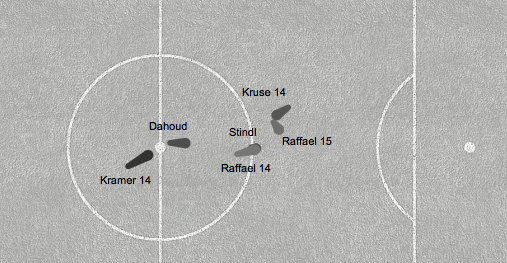 Those positional tweaks aside, with the ball things really aren't too much different when you look at the team-wide metrics. Gladbach still complete a huge percentage of their passes, they are still great around the goal, are patient all over the pitch, and are still converting well above what shot models would expect them to (for example, Michael Caley's model has them scoring 10 more goals than expected). Maybe this isn't that surprising, they still have great passers of the ball up front with Raffael and Lars Stindl. Gladbach are in an interesting position where they are no longer doing any of the things that helped them keep goals allowed so far below what their shots indicated these past three years but still are performing well, mainly from a continued efficient attack. The key metric to watch in the second half will be shots and deep completions allowed. For Schubert to prove he's a coach that can keep Gladbach among the top UCL contenders he will need to get these well below the Favre-era numbers and probably below the league average. They played the most promising game of the season with their beatdown of Bayern, so we know a very good team is in there, we just need to see it over the final 17 games to be sure. Wolfsburg Looked more in-depth at them here. The New Boys Ingolstadt
Those positional tweaks aside, with the ball things really aren't too much different when you look at the team-wide metrics. Gladbach still complete a huge percentage of their passes, they are still great around the goal, are patient all over the pitch, and are still converting well above what shot models would expect them to (for example, Michael Caley's model has them scoring 10 more goals than expected). Maybe this isn't that surprising, they still have great passers of the ball up front with Raffael and Lars Stindl. Gladbach are in an interesting position where they are no longer doing any of the things that helped them keep goals allowed so far below what their shots indicated these past three years but still are performing well, mainly from a continued efficient attack. The key metric to watch in the second half will be shots and deep completions allowed. For Schubert to prove he's a coach that can keep Gladbach among the top UCL contenders he will need to get these well below the Favre-era numbers and probably below the league average. They played the most promising game of the season with their beatdown of Bayern, so we know a very good team is in there, we just need to see it over the final 17 games to be sure. Wolfsburg Looked more in-depth at them here. The New Boys Ingolstadt  The newly-promoted side have been one of the most fascinating teams in the league. They've scored a brutal 11 goals, by far least in the league, but have also allowed fewer goals than anyone but Bayern (17). The average Ingolstadt game has seen 1.7 goals, which is about 35 minutes worth of a Dortmund game. Taking the facts I've laid out so far, you'd expect Ingolstadt to be a boring, conservative team that sits deep to try and lower the shot quality. You'd also be wrong. Austrian manager Ralph Hasenhüttl isn't directing his players to do anything fancy or impressive when Ingolstadt have the ball: they are playing the 2nd longest passes and have the 2nd-lowest completion % in the league. They've used this attack limitation and turned it into an advantage on defense. Ingolstadt's attacking possessions end 3 yards closer to the opposition goal than all but one other team, they then use this directness to push the press high. And they really press high:
The newly-promoted side have been one of the most fascinating teams in the league. They've scored a brutal 11 goals, by far least in the league, but have also allowed fewer goals than anyone but Bayern (17). The average Ingolstadt game has seen 1.7 goals, which is about 35 minutes worth of a Dortmund game. Taking the facts I've laid out so far, you'd expect Ingolstadt to be a boring, conservative team that sits deep to try and lower the shot quality. You'd also be wrong. Austrian manager Ralph Hasenhüttl isn't directing his players to do anything fancy or impressive when Ingolstadt have the ball: they are playing the 2nd longest passes and have the 2nd-lowest completion % in the league. They've used this attack limitation and turned it into an advantage on defense. Ingolstadt's attacking possessions end 3 yards closer to the opposition goal than all but one other team, they then use this directness to push the press high. And they really press high: 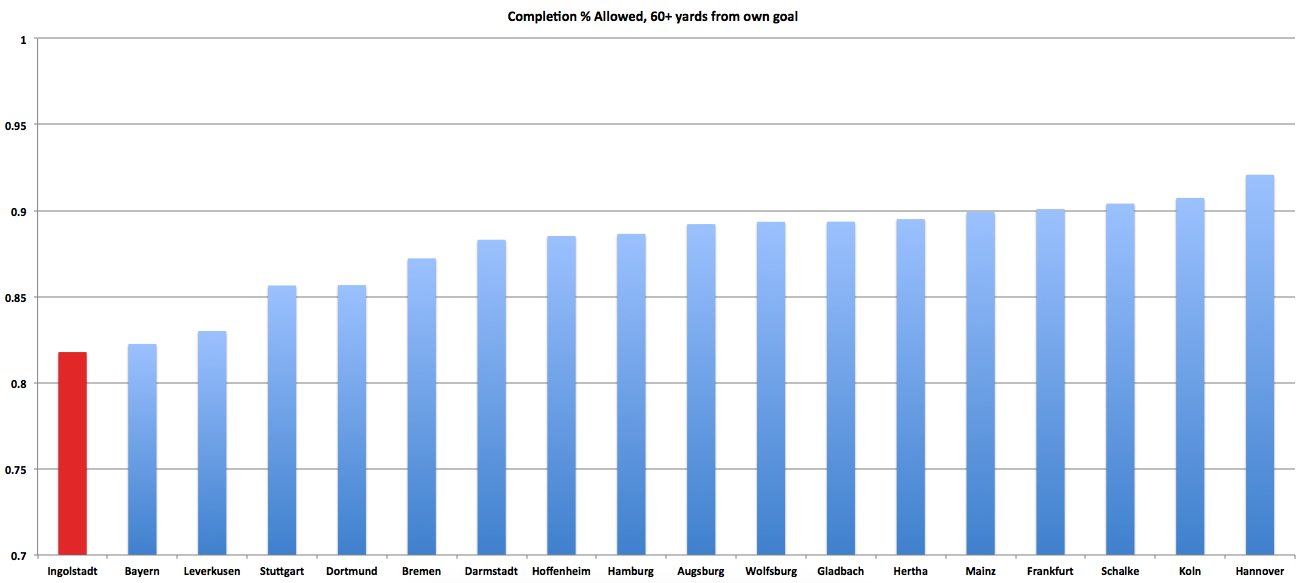 Not even the crazy pressure of Bayern and Leverkusen has topped Ingolstadt's. They've been able to win the ball back higher than anyone but Bayern, and though they haven't turned this into any semblance of a quality attack they are winning the field position battle in a significant way to shut down games. Ingolstadt have avoided the Celta/Rayo/last year Tottenham trap of the high pressing team that is easy to cut open at the back, opponents are actually below average at completing passes around goal. I would love to see what this style can do with a few more highly skilled attackers added in. Because when it comes to attackers, Ingolstadt might just have one. The insane reliance on Pascal Groß is almost comical. The 2nd-most key passes on Ingolstadt have come from Matthew Leckie, with 18. Groß has 49. As mentioned last week, Groß has more key passes than anyone else in the Bundesliga. With this one-man reliance comes some serious symmetry problems: Ingolstadt have 57 chances created from passes on the far right of the pitch and just 22 on the left, no other team comes close as you'd expect.
Not even the crazy pressure of Bayern and Leverkusen has topped Ingolstadt's. They've been able to win the ball back higher than anyone but Bayern, and though they haven't turned this into any semblance of a quality attack they are winning the field position battle in a significant way to shut down games. Ingolstadt have avoided the Celta/Rayo/last year Tottenham trap of the high pressing team that is easy to cut open at the back, opponents are actually below average at completing passes around goal. I would love to see what this style can do with a few more highly skilled attackers added in. Because when it comes to attackers, Ingolstadt might just have one. The insane reliance on Pascal Groß is almost comical. The 2nd-most key passes on Ingolstadt have come from Matthew Leckie, with 18. Groß has 49. As mentioned last week, Groß has more key passes than anyone else in the Bundesliga. With this one-man reliance comes some serious symmetry problems: Ingolstadt have 57 chances created from passes on the far right of the pitch and just 22 on the left, no other team comes close as you'd expect. 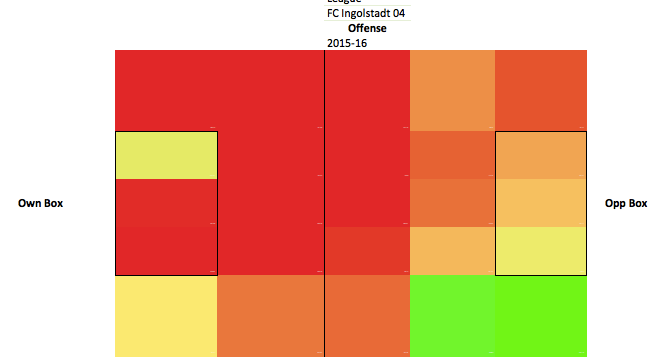 Stop Groß and guard your left when you play Ingolstadt. They look to be reasonably safe 5 places above relegation and it will be interesting to see the super-defensive side evolve. Darmstadt
Stop Groß and guard your left when you play Ingolstadt. They look to be reasonably safe 5 places above relegation and it will be interesting to see the super-defensive side evolve. Darmstadt  The long ball kings. What happens when your only strategy with the ball is simply heaving it forward and long.
The long ball kings. What happens when your only strategy with the ball is simply heaving it forward and long. 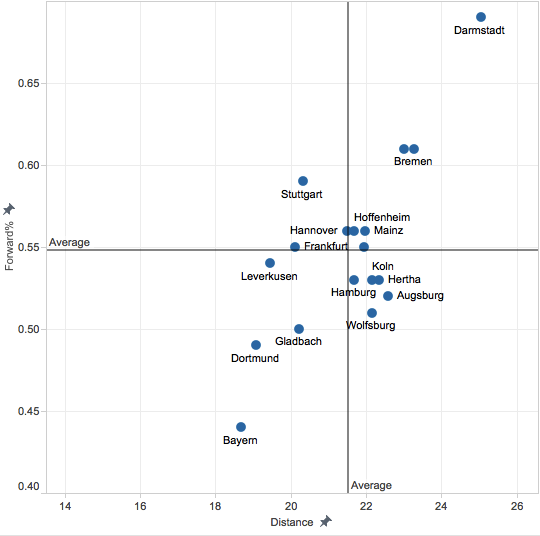 Unsurprisingly this approach has led to 37% possession and 56% pass completion. This long-ball game waned a bit as the season went on, as they played more like a normal team. The first 5 games, their average pass length was above 28 yards before falling down sub 25 the rest of the year. They almost had to cut it down a bit, at one point a couple months into the season they had completed 5 passes in a row once. One time. As you can see from their summary table, they have been relegation worthy in territory control but surprisingly have been shooting from very close and forcing opponents to shoot from far out. That seems very unlikely to hold up and the lack of a real way to keep possession means they will be one of the favorites to go down, even with the 3 point edge on 16th they hold right now. Biggest Fallers Hannover and Hoffenheim have collapsed. Last year Hoffenheim threatened for a Europa League spot and got passed by Dortmund right at the end of the season. This year they are dead last. Hannover are right above them, still reeling from losing Mr. Everything Lars Stindl. Neither team can keep opponents from just pouring in on their goal:
Unsurprisingly this approach has led to 37% possession and 56% pass completion. This long-ball game waned a bit as the season went on, as they played more like a normal team. The first 5 games, their average pass length was above 28 yards before falling down sub 25 the rest of the year. They almost had to cut it down a bit, at one point a couple months into the season they had completed 5 passes in a row once. One time. As you can see from their summary table, they have been relegation worthy in territory control but surprisingly have been shooting from very close and forcing opponents to shoot from far out. That seems very unlikely to hold up and the lack of a real way to keep possession means they will be one of the favorites to go down, even with the 3 point edge on 16th they hold right now. Biggest Fallers Hannover and Hoffenheim have collapsed. Last year Hoffenheim threatened for a Europa League spot and got passed by Dortmund right at the end of the season. This year they are dead last. Hannover are right above them, still reeling from losing Mr. Everything Lars Stindl. Neither team can keep opponents from just pouring in on their goal: 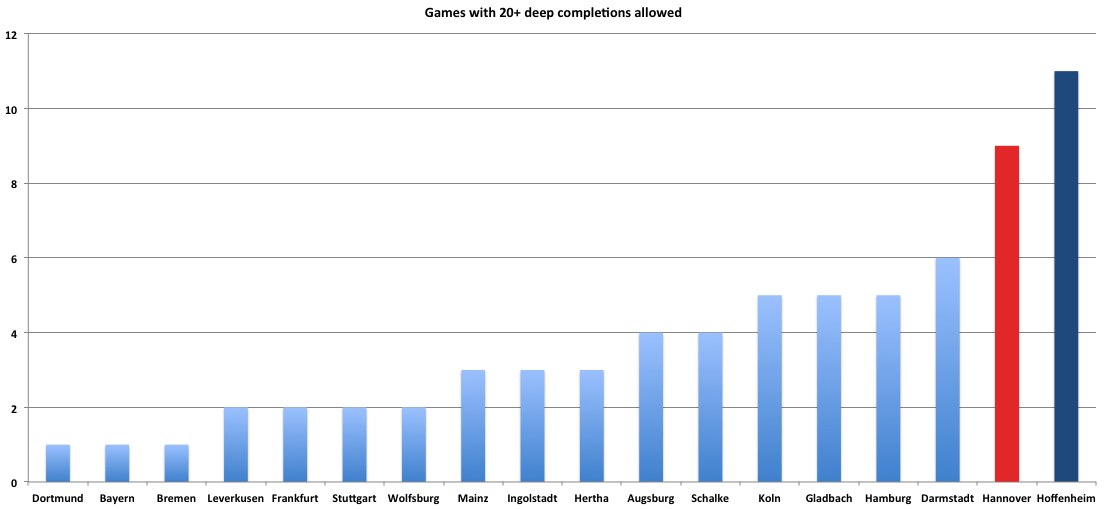 and can't ever put sustained pressure on the opposition:
and can't ever put sustained pressure on the opposition: 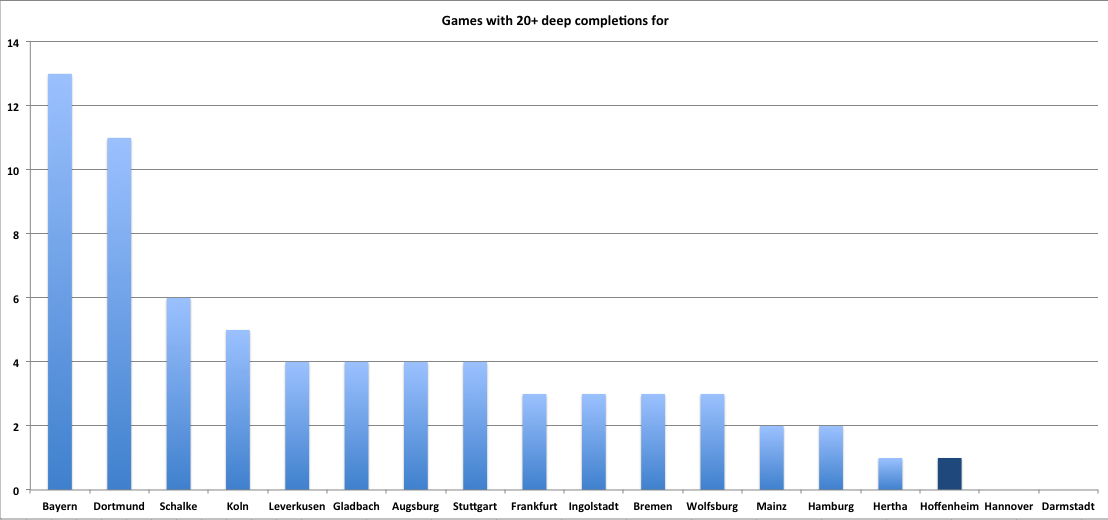 Hannover looks the most hopeless, they are the leading favorite for relegation. Hoffenheim are bad, but not quite as bad, and have some interesting elements that make them more interesting to watch. They might have the only player in a major league who could plausibly feature for the Afghani national side in Nadiem Amiri and they have also have appointed a 28-year old coach in Julian Nagelsmann for next season, who could become the youngest coach in Bundesliga history if they stay up.
Hannover looks the most hopeless, they are the leading favorite for relegation. Hoffenheim are bad, but not quite as bad, and have some interesting elements that make them more interesting to watch. They might have the only player in a major league who could plausibly feature for the Afghani national side in Nadiem Amiri and they have also have appointed a 28-year old coach in Julian Nagelsmann for next season, who could become the youngest coach in Bundesliga history if they stay up. 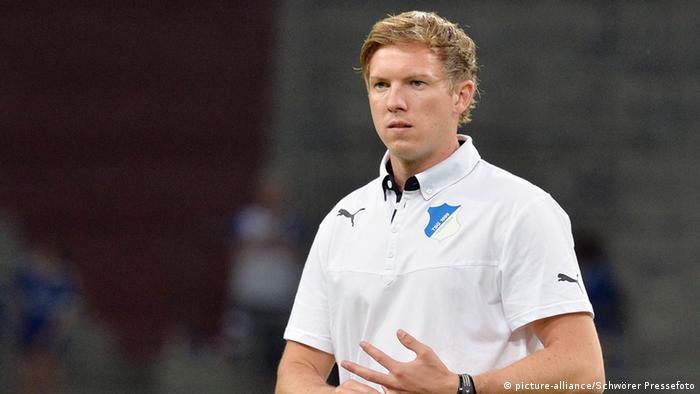
 Of the teams returning to the Bundesliga from last season, none allowed more deep completions than Koln and only Hertha had fewer on the attacking side. Their shots had also come from the furthest distance away and they took the 2nd-fewest shots. There were all kinds of danger signals emanating from this side, but this year those concerns have mostly faded away. No team has improved their deep completion total more (Koln is +4.3/game), no team has improved their average shot distance more (3 yards closer), and only Stuttgart have seen a larger jump in shots (Koln have added 1.7 shots). Anthony Modeste has found himself in some pretty impressive company across Europe as the tip of this sharpened Koln spear.
Of the teams returning to the Bundesliga from last season, none allowed more deep completions than Koln and only Hertha had fewer on the attacking side. Their shots had also come from the furthest distance away and they took the 2nd-fewest shots. There were all kinds of danger signals emanating from this side, but this year those concerns have mostly faded away. No team has improved their deep completion total more (Koln is +4.3/game), no team has improved their average shot distance more (3 yards closer), and only Stuttgart have seen a larger jump in shots (Koln have added 1.7 shots). Anthony Modeste has found himself in some pretty impressive company across Europe as the tip of this sharpened Koln spear. 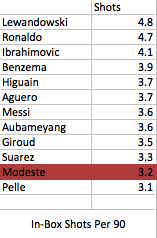 Their attack is extremely cross-heavy, the top 2 key pass providers are fullbacks Hector and Risse and their pass in the final 25 yards is longer than anyone's but Hannover and fellow crossers Wolfsburg. This is not a team that spends time with complicated interplay, it throws the ball forward into the box.
Their attack is extremely cross-heavy, the top 2 key pass providers are fullbacks Hector and Risse and their pass in the final 25 yards is longer than anyone's but Hannover and fellow crossers Wolfsburg. This is not a team that spends time with complicated interplay, it throws the ball forward into the box. 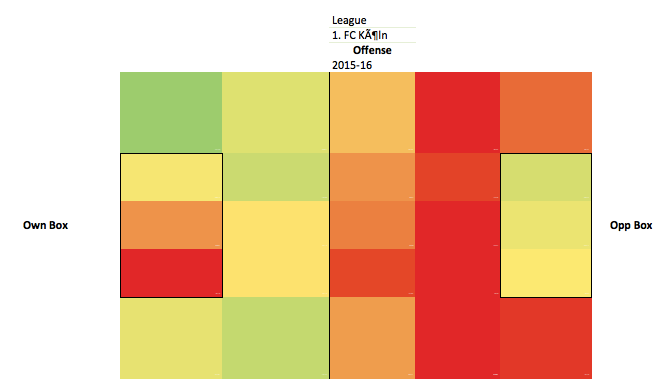 And if you've heard all about the frantic pace and high pressing of the Bundesliga, don't watch Koln. They've pressed less than any other team but Hannover this season. Even if the style is a bit brutalistic, it's working and Koln is playing a lot more like a comfortable mid-table team this year. Others Werder Bremen and Stuttgart are two fascinating cases. Both have seen their fundamental numbers climb signficantly from last season but both are sitting in relegation places right now. Their underlying numbers probably overrate both teams as they have both trailed 37% of the time, more than anyone bar Hannover. However, the table likely underrates them. Neither are among the top candidates to go down and I expect both to perform more like mid-table teams. I wrote about Stuttgart's fascinating season here. My recommendation for Stuttgart is try a little less Kostic with his sloppiness with the ball, and play more Rupp and Maxim. Sell Kostic if you can get the huge fee he's rumored to be commanding. Also, see if you can determine the stylistic change from Zorniger to Kramny:
And if you've heard all about the frantic pace and high pressing of the Bundesliga, don't watch Koln. They've pressed less than any other team but Hannover this season. Even if the style is a bit brutalistic, it's working and Koln is playing a lot more like a comfortable mid-table team this year. Others Werder Bremen and Stuttgart are two fascinating cases. Both have seen their fundamental numbers climb signficantly from last season but both are sitting in relegation places right now. Their underlying numbers probably overrate both teams as they have both trailed 37% of the time, more than anyone bar Hannover. However, the table likely underrates them. Neither are among the top candidates to go down and I expect both to perform more like mid-table teams. I wrote about Stuttgart's fascinating season here. My recommendation for Stuttgart is try a little less Kostic with his sloppiness with the ball, and play more Rupp and Maxim. Sell Kostic if you can get the huge fee he's rumored to be commanding. Also, see if you can determine the stylistic change from Zorniger to Kramny: 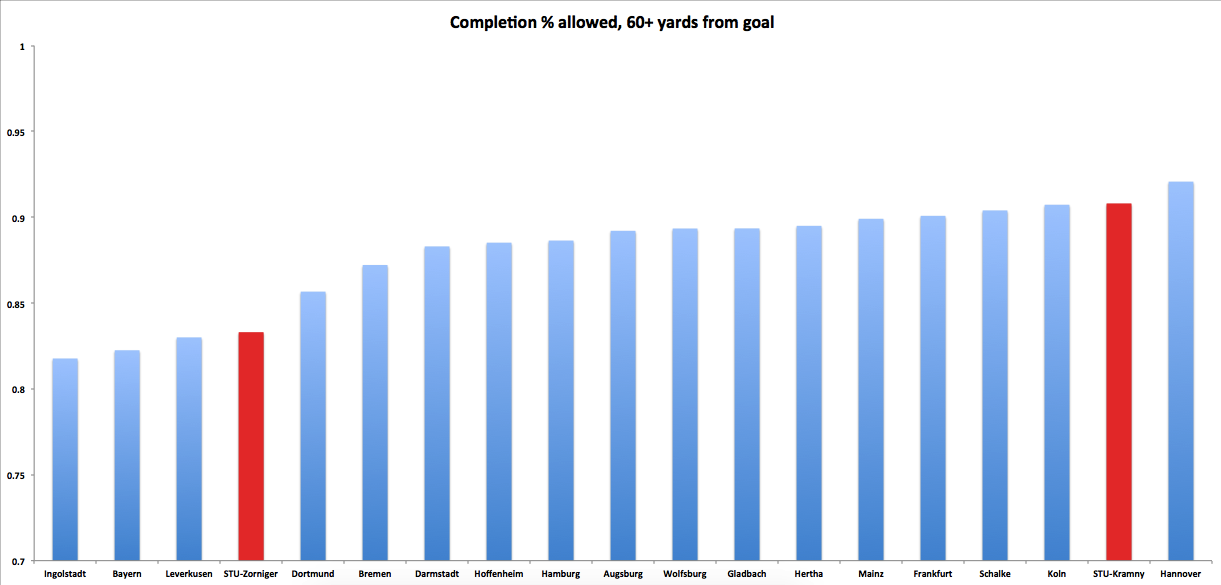 That's it for the Bundesliga at the Break. Even with the title essentially sown up, it should be a great second half up and down the league table. Hopefully this has helped you get ready for it.
That's it for the Bundesliga at the Break. Even with the title essentially sown up, it should be a great second half up and down the league table. Hopefully this has helped you get ready for it.
How Bad Are Aston Villa?
Coming into this season I was somewhat bullish on Aston Villa. Okay that's not quite true but I thought they'd at least be semi-competent. Admittedly, some of this was colored by the fact that Villa bought four Ligue 1 players in the summer and I liked three and a half of them (the half being Jordan Ayew). I loved the Jordan Amavi signing and thought that he'd do good things at LB, Idrissa Gueye knows who he is as a CM and Veretout produced interesting playmaking numbers at a young age even though he mixed it up between playing CM and as a #10. I had my issues with Ayew because I thought he was inefficient when on the ball, but overall I thought Villa did well with their French recruitment.
Obviously our pal Tim Sherwood was still the manager but last season he had posted middling shot numbers, especially compared to the travesty on that front during Paul Lambert's reign. You knew it wouldn't last this well but at least it was something. And now you look at Aston Villa and it's just depressing. Any attempt from pundits and writers to explain away the season majors on slamming their transfer policy over the summer. How the owner has lost interest and let the ex Arsenal men running the club ruin a once proud English football institution (I don't believe this is true, but hey, narratives).
Villa are having one of the worst seasons in the history of the Premier League. They're on pace to tie 2005-06 Sunderland for the 2nd worst season tally in PL history at 15. Make no mistake, Aston Villa are pretty damn bad and their overall projections this season have them as the most likely relegated team in the PL by a huge margin. They've been much worse than I expected and the wheels have fallen off big time for the club.
However looking at a rough projection of talent level through shot metrics and it gives a bad picture but not quite as bad as you might think given their lack of points. Using shots on target, Aston Villa would rank 18th, using Paul Riley's xG, 17th. Both project Villa with an expected point total of around 19-20 instead of their current eight. So it's gotten me to wonder just why Aston Villa are 11-12 points off those projected talent levels. What the hell has gotten them to such a state that there's almost certainly no way to survive?
Just on a peripheral level, Aston Villa have been unlucky. Their PDO of 87.2 is the second worst in the PL and if that mark holds, it'd be the 6th lowest mark in the Opta era. But then you peel back the onion a bit more and you can see why some of this is happening. Brad Guzan since coming to the PL has always posted bad SV%'s and Aston Villa as a team haven't had a SV% that's come close to hitting 70% since his arrival. When adding shot location context, it gets even worse. Paul Riley has done extensive work on goalkeepers using his xG model and video analysis and Guzan as a shot stopper has been one of the worst goalies in the PL.
There are still many things we don't know about goalies, but the mounting evidence does suggest that Brad Guzan has sucked as a shot stopper since coming to the PL. Add to that other factors such as claiming balls and distribution patterns, stuff that Sam Jackson talks a lot about and the growing picture makes it more clear that Brad Guzan is or has become a below par goalie that Aston Villa have retained for multiple years. One other hilarious thing about Brad Guzan and Aston Villa this season: Aston Villa when leading in a game have a save percentage of 37.5%. 37.5%! I can't even comprehend having such a terrible SV% like that when in a winning position. Given this fact it also won't shock you that they have had the least time in a winning position in the PL this season.
When you have a bad goalkeeper, you better have a defense that's bloody good at shot suppression both in quality and quantity to limit as much damage as possible, and Aston Villa do not qualify for either. They suck at shot suppression (any benefit from being 11th in shots allowed is destroyed by being tied for 18th in shots on target allowed) and suppressing quality of shots, (15th in xG against).
Watching Aston Villa defend half the time is like watching a drunk circus act, you know it's going to end up in misery and you're just counting down the clock. Their defense can be spread so open whether it be in transition or in a set position, it's looks like a modern day re-enactment of Moses parting the Red Seas.
There's a very strong argument to be had that Aston Villa employ the worst fullback combination in the PL between Alan Hutton and Kieran Richardson. The downgrade from Jordan Amavi to Richardson was massive and Alan Hutton this season might be the worst RB I've ever seen. He regularly does moronic stuff defensively and his crossing abilities aren't anywhere good enough to cover up for stuff like this.
You think we're just cherry picking? Oh we're just getting started. He somehow allowed all of 5'4 Nathan Dyer to dart in behind him for the game winning goal versus Leicester.
He gave up this doozy of a penalty to Theo Walcott after being burned by him on the flanks.
He failed to help at all with Daniel Sturridge's run for his goal that basically ended it for Villa that day.
There's a bunch more examples I could've used but you get the deal. It's no surprise that both Hutton and Richardson are sub-par PL players. Both are over 31 and play a young man's position, especially so in a faster tempo league. The injury to Jordan Amavi robbed Villa of a potential starlet at LB. The other options that Villa have at fullback are uninspiring, especially on the right side and it leaves the club with the following options:
- Buy a RB in the January Transfer Window
- Move Micah Richards into the RB slot and pray that works
- Do nothing and keep banging your head against the wall with the Hutton/Bacuna RB core
If Aston Villa were 3-4 points back of 17th, I could see option 1 being reasonable. As it stands, Aston Villa have next to no chance of surviving so wasting money in January seems kind of pointless unless it's a player with massive upside. Making Micah Richards a RB again might be the lesser of evils, but if his time at Fiorentina last season was any indication, Richards as a RB would also probably end in a disaster. At least playing Richards at RB would allow them to play the better CB tandem of Okore and Lescott (Something the folks at 7500 To Holte talked about).
It's hard to see how Aston Villa can go about fixing their defensive problems. Small things like playing Okore/Lescott at CB could help trim numbers a little bit but nothing extraordinary. Aly Cissokho over Richardson is an upgrade but nothing compared to having Jordan Amavi there. Maybe playing a double pivot consisting two of Westwood/Gueye/Sanchez could help a tiny bit which would mean making Jordan Veretout the full time #10. Again though, I'm skeptical after this much evidence that tweaks like that would help curtail things in front of Guzan. Their personnel looks primed to concede loads of shots unless a brutally defensive manager like Tony Pulis was hired and entirely sacrificed offense for defense.
It isn't any better if you look at Villa's offensive output this season. Aston Villa rank 18th in shots for, tied for 18th in shots on target for and 20th in expected goals for. They aren't even getting in the box: Aston Villa have 48.1% of their shots come from outside the penalty area and only Norwich have a higher % at 48.7. If you want to see a good attack versus a team like Aston Villa, here you go.
As funny as it sounds, Aston Villa might even be over-performing in their outside the box shots. Using Danny Page's excellent Expected Goal Simulator, I used Aston Villa's xG numbers from outside the penalty area and ran a simulation on the likelihood of scoring 5 goals from those situations. 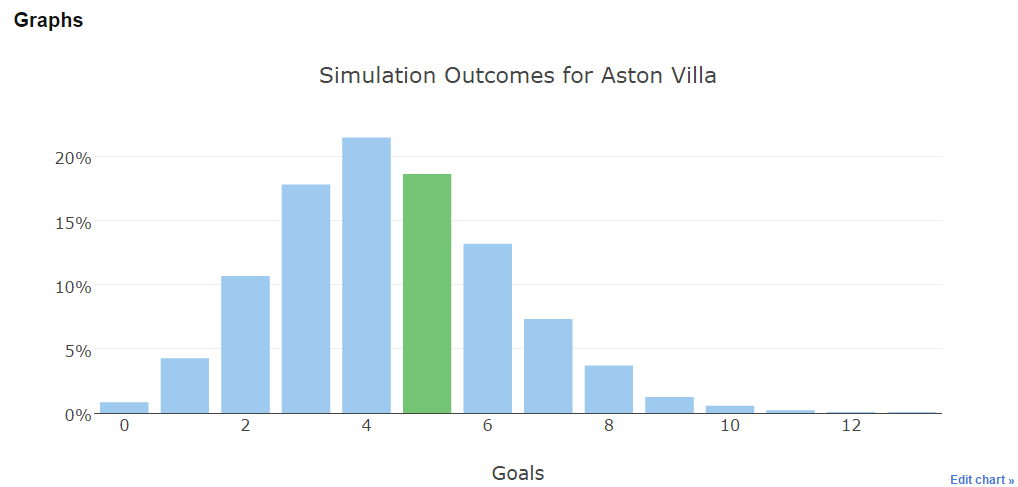
It's nothing extreme but the description of this simulation said that they expected Villa to score four goals and 55% of those simulations had a sign of over performance. Given Villa's situation both offensively and overall, even a slight hint of over performance is a bad sign.
It goes without saying but losing Christian Benteke in the summer was a massive loss. He's had his glaring flaws in Liverpool's scheme but he was a great focal point for a club like Aston Villa. Though Tactics Tim did post average shot differential numbers when he took over, he also presided over Benteke's return to form and among other things rode that to survival . Looking at Aston Villa's roster and you can see why they've struggled massively without him. It's just a poorly assembled mishmash. I would broadly classify Aston Villa's attacking players in these categories:
- Talented Dribblers who do nothing else: Jack Grealish, Adama Traore
- Runners who also do very little elsewhere: Scott Sinclair, Gabriel Agbonlahor
- Decent attacking midfielders not getting a long enough leash in their favorite position: Carles Gil, Jordan Veretout
- Flawed Strikers: Rudy Gustede, Jordan Ayew
There's very little penetration when Villa are settled in the opponent's final third and, surprise, these moments are few and far between. They rank in the bottom third in shots coming from established possessions in the opposition half. There doesn't seem to be much of an identity, with faint moments of counter attacking football spliced in with a lack of coordination in terms of supporting the striker in the final third.
There's two different game plans for Villa, depending on who is starting up front. If it's Rudy Gustede, the plan is more or less just pumping crosses at a high volume and hoping enough of them reach the target. When Ayew is up top, Villa still pump crosses but he also likes to have the ball to his feet. Sadly, Ayew has always ranked very high in dispossession and unsuccessful dribble numbers during his time in France, and it was a main reason why I was fairly skeptical of his signing. Though those numbers are slightly down, he's more or less been the same player he's always been; a high usage striker whose goal scoring record isn't good enough to justify such a stranglehold on a team's attack.
Aston Villa probably shouldn't be 11 points behind Swansea for 17th place, and as bad as Brad Guzan is, he shouldn't have a SV% in winning situations that's actually lower than Everton and Leicester's overall Scoring %. But I would make a strong argument that they are the worst team in the PL and the 19-20 point talent levels projected by xG and SoT to some extent flatters them. It's a very flawed roster with probably the worst defensive backbone in the PL and an attacking system nowhere near good enough to make up for it.
When Aston Villa are relegated this season, the mainstream UK writers will predictably blame the foreign recruitment (AKA the French players), a lack of players with league experience, Chief Executive Tom Fox and Sporting director Hendrik Almstadt, and possibly even Remi Garde as well. Screams of "well if you hired someone like Sam Allardyce, Aston Villa wouldn't be in this spot" will be heard. It ignores the fact that Sunderland are still awful under Allardyce and Garde did good things at Lyon when they were at their worst financially, a situation that in its own way was just as hard as what he's encountering with Aston Villa.
What I don't see is anyone talking about, or at least not as combined weight of evidence that has significantly contributed to the situation; is Brad Guzan being terrible for years, or Alan Hutton also being terrible, or Micah Richards' career winding down at age 27, or even Jack Grealish being another overhyped UK product. If there's anything to be blamed, it's the "proven PL experience" players that sorely lack in quality. The constant squad turnover has helped foster this situation and it's left the French players among others to be the scapegoat for the deterioration of Aston Villa. The foreign recruitment wasn't perfect, and the Adama Traore contract situation is probably the best example of that but the known quantities of the experienced PL players have not been good enough; I would much rather have bet on recruitment, brought the foreign players in and had faith in them.
Aston Villa are in a state of hurt as a club and there's no easy way out. It's been the perfect storm of bad quality and a pinch of unluckiness. It is very fair to say the lack of cohesion within the club over the years has led to their downfall. This is the type of situation that could result in them languishing in the Championship for years to come, similar to Fulham. Will the young talent they have stay in a lesser league or get cherry-picked the moment they go down? Either way, it looks to be a sad way for this novel to end, one of the Premier League's original members will be no more and it's tough to see any alternative endings being written for Aston Villa.
A Compilation of EPL Model Predictions after Round 20/38
 Introduction The 3rd round FA Cup weekend is already under way which means a break from the arduous Premier League season. With 20 out of the 38 rounds finished and 200 current season matches to draw data from, it seems like a good time to attempt to predict what might happen at the end of the season. Will Leicester City carry on with their spectacular early, but recently waning, form and be crowned champions at the end of the year, having been fighting against relegation just the year before? Will Spurs win their first league title in more than half-a-century, or will it be one of the more usual suspects in Arsenal or Manchester City? What should we expect from traditional powerhouses Manchester United and Chelsea? And is there any salvation for Aston Villa? Too many questions and if you are looking for definitive answers, this is NOT the place to be. What you will find here is a collection of probability estimates to help answer the questions above, and words or phrases like “probably”, “most likely”, “maybe”, “perhaps”, “outside chance” etc, which exemplify the often quoted “Statistics means never having to say you're certain.”. And no, I’m not sure whose quote that is. There are a number of football prediction models out there as a lot of people prefer to base their opinions on data rather than their gut feelings. Some of the predictions aren’t publicly available; others are regularly posted on blogs or social media. But in either case, a comparison between different model predictions is not always feasible. Wouldn’t it be nice to have some of these predictions, side by side, not in a competitive sense, but rather in a complementary fashion? Quite often, in statistics, combining predictions from different models improves the overall performance of a forecasting model so why not use the wisdom of the models (to paraphrase https://en.wikipedia.org/wiki/Wisdom_of_the_crowd) in a “poll of models” set-up? Participants Twitterland was the go-to place to ask for contributions and I was pleasantly surprised to find out that people were quite willing to share their figures. In total, there were 15 participants, all of them submitting end-of-season points’ estimates for each team in the Premier League, while all but one of them shared their estimated probability distribution of each team ending up in each position in the final table. The contributors (to whom I owe a big “Thank you” and a beer whenever we meet!) are in alphabetical order of their Twitter usernames: @11tegen11, @cchappas, @colinttrainor, @DaveLaidig, @EuroClubIndex (via @SimonGleave), @fussbALEXperte, @GoalImpact, @goalprojection, @JamesWGrayson, @MC_of_A, @opisthokonta, @seconddropp, @stats4footy, @SteMc74 and @WillTGM Note that I didn’t request additional information on the models especially as some have quite extensive explanations already publicly available online while some are private. In addition, increasing the response burden unnecessarily could have resulted in lower participation figures so if you need more details on the models, contact their creators directly. Without further ado, let’s have a look at the results. And what better place to start with but with the top of the league.
Introduction The 3rd round FA Cup weekend is already under way which means a break from the arduous Premier League season. With 20 out of the 38 rounds finished and 200 current season matches to draw data from, it seems like a good time to attempt to predict what might happen at the end of the season. Will Leicester City carry on with their spectacular early, but recently waning, form and be crowned champions at the end of the year, having been fighting against relegation just the year before? Will Spurs win their first league title in more than half-a-century, or will it be one of the more usual suspects in Arsenal or Manchester City? What should we expect from traditional powerhouses Manchester United and Chelsea? And is there any salvation for Aston Villa? Too many questions and if you are looking for definitive answers, this is NOT the place to be. What you will find here is a collection of probability estimates to help answer the questions above, and words or phrases like “probably”, “most likely”, “maybe”, “perhaps”, “outside chance” etc, which exemplify the often quoted “Statistics means never having to say you're certain.”. And no, I’m not sure whose quote that is. There are a number of football prediction models out there as a lot of people prefer to base their opinions on data rather than their gut feelings. Some of the predictions aren’t publicly available; others are regularly posted on blogs or social media. But in either case, a comparison between different model predictions is not always feasible. Wouldn’t it be nice to have some of these predictions, side by side, not in a competitive sense, but rather in a complementary fashion? Quite often, in statistics, combining predictions from different models improves the overall performance of a forecasting model so why not use the wisdom of the models (to paraphrase https://en.wikipedia.org/wiki/Wisdom_of_the_crowd) in a “poll of models” set-up? Participants Twitterland was the go-to place to ask for contributions and I was pleasantly surprised to find out that people were quite willing to share their figures. In total, there were 15 participants, all of them submitting end-of-season points’ estimates for each team in the Premier League, while all but one of them shared their estimated probability distribution of each team ending up in each position in the final table. The contributors (to whom I owe a big “Thank you” and a beer whenever we meet!) are in alphabetical order of their Twitter usernames: @11tegen11, @cchappas, @colinttrainor, @DaveLaidig, @EuroClubIndex (via @SimonGleave), @fussbALEXperte, @GoalImpact, @goalprojection, @JamesWGrayson, @MC_of_A, @opisthokonta, @seconddropp, @stats4footy, @SteMc74 and @WillTGM Note that I didn’t request additional information on the models especially as some have quite extensive explanations already publicly available online while some are private. In addition, increasing the response burden unnecessarily could have resulted in lower participation figures so if you need more details on the models, contact their creators directly. Without further ado, let’s have a look at the results. And what better place to start with but with the top of the league.
Stats Note:
- For those not familiar with boxplots, they are a visualisation tool to graphically depict information on a dataset through its quartiles. The two sides of the box are the 1st and 3rd quartile while the line inside the box shows the median i.e. the 2nd The whiskers on each side can represent different values but in this case, they extend to the minimum and the maximum value within 1.5 x IQR (interquartile range) of the closest quartile. If there are values outside this range, there are represented as points.
- Each model prediction is represented by a differently coloured point in the following plots. To avoid overlapping and to hopefully make the plots a bit clearer, points were randomly moved horizontally for each team.
Here endeth the stats lesson!
Results So who’s going to win it? 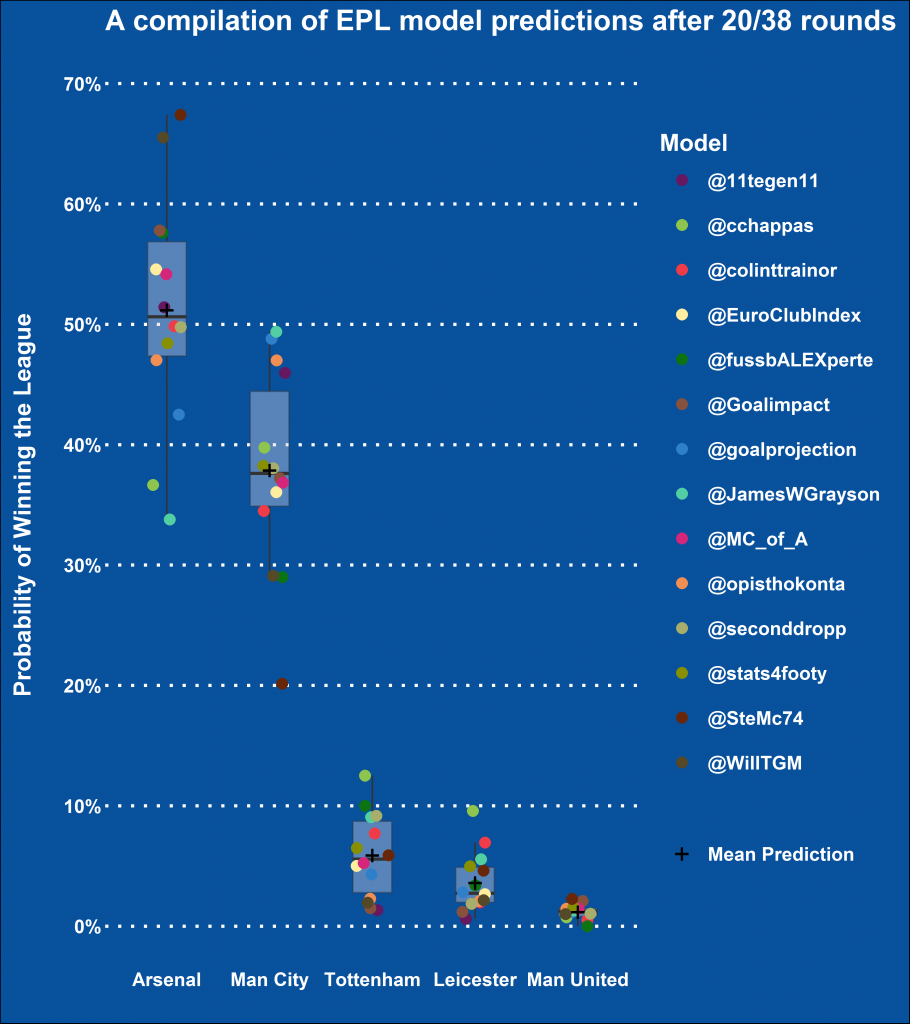 Well, this is quite interesting. The Gunners and the Citizens are the clear favourites, but there’s a lot of variability in the predictions. Arsenal’s league chances range from 34% to 67% with an interquartile range of 47% to 57%. Both the mean and the median prediction are close together and approximately 51%, suggesting a generally symmetric distribution. At the same time, Manchester City’s chances are rated generally lower but with some overlap. Both the average probability prediction for the Citizen’s winning the league and the median prediction stand at 38% approximately. There is slightly less variability amongst the predictions (partly because of the lower overall mean) and the IQR is between 35% and 44%. Interestingly enough, some models prefer Arsenal; some prefer City and some can’t separate the two. Unfortunately for Spurs and Leicester City fans, it would seem that the chances of their teams winning the league are relatively small. Not negligible by any means, but small nevertheless. Manchester United have also been included in the plot as their mean prediction is above 1% (the threshold used for inclusion in the chart) but they are unlikely to challenge based on what the models currently predict. It would be a huge surprise if anyone else topped the table at the end of the season. What about Top 4 Finish?
Well, this is quite interesting. The Gunners and the Citizens are the clear favourites, but there’s a lot of variability in the predictions. Arsenal’s league chances range from 34% to 67% with an interquartile range of 47% to 57%. Both the mean and the median prediction are close together and approximately 51%, suggesting a generally symmetric distribution. At the same time, Manchester City’s chances are rated generally lower but with some overlap. Both the average probability prediction for the Citizen’s winning the league and the median prediction stand at 38% approximately. There is slightly less variability amongst the predictions (partly because of the lower overall mean) and the IQR is between 35% and 44%. Interestingly enough, some models prefer Arsenal; some prefer City and some can’t separate the two. Unfortunately for Spurs and Leicester City fans, it would seem that the chances of their teams winning the league are relatively small. Not negligible by any means, but small nevertheless. Manchester United have also been included in the plot as their mean prediction is above 1% (the threshold used for inclusion in the chart) but they are unlikely to challenge based on what the models currently predict. It would be a huge surprise if anyone else topped the table at the end of the season. What about Top 4 Finish? 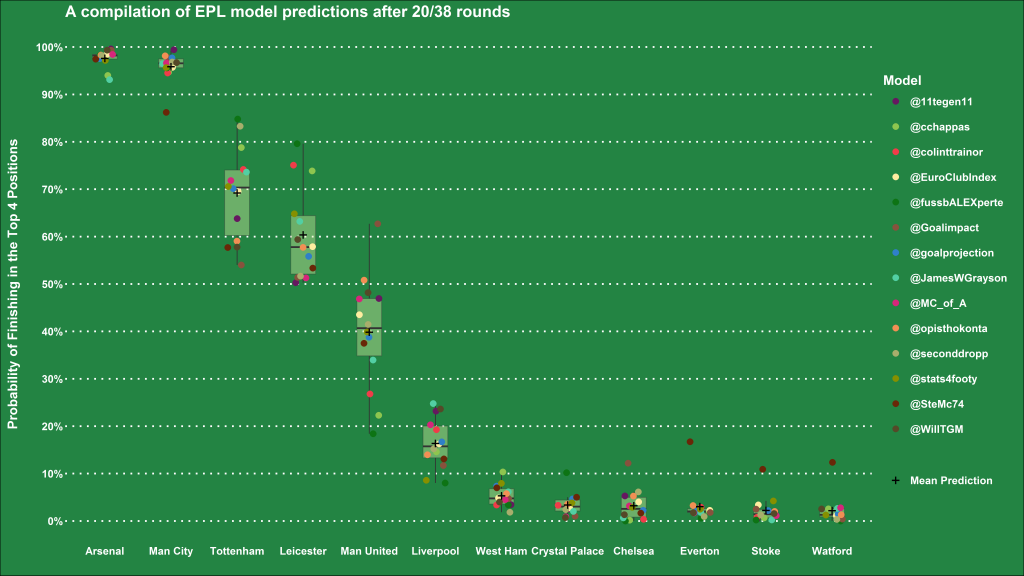 Arsenal and Manchester City are almost guaranteed a finish in the Top 4 positions, so there are only two positions left. Spurs look very well placed with an average chance of 69% which nevertheless ranges from around 55% in some models to a very large 85%. They are closely followed by Leicester City whose distribution of Top 4 probability estimates is positively skewed i.e. most models estimate those chances to be between 50%-60% with a few in the 65%-80% (!) range. Louis van Gaal’s Manchester United is a big question mark, exhibiting very high variability in the models’ estimated probabilities of a Top 4 finish with models predicting their chances as low as below 20% and as high as above 60%. Finally, there seems to be an outside chance of Klopp’s Liverpool to break the Champions League places’ party with the rest of the teams rated very low by most models bar the odd outlier. And the wooden spoon goes to ….?
Arsenal and Manchester City are almost guaranteed a finish in the Top 4 positions, so there are only two positions left. Spurs look very well placed with an average chance of 69% which nevertheless ranges from around 55% in some models to a very large 85%. They are closely followed by Leicester City whose distribution of Top 4 probability estimates is positively skewed i.e. most models estimate those chances to be between 50%-60% with a few in the 65%-80% (!) range. Louis van Gaal’s Manchester United is a big question mark, exhibiting very high variability in the models’ estimated probabilities of a Top 4 finish with models predicting their chances as low as below 20% and as high as above 60%. Finally, there seems to be an outside chance of Klopp’s Liverpool to break the Champions League places’ party with the rest of the teams rated very low by most models bar the odd outlier. And the wooden spoon goes to ….? 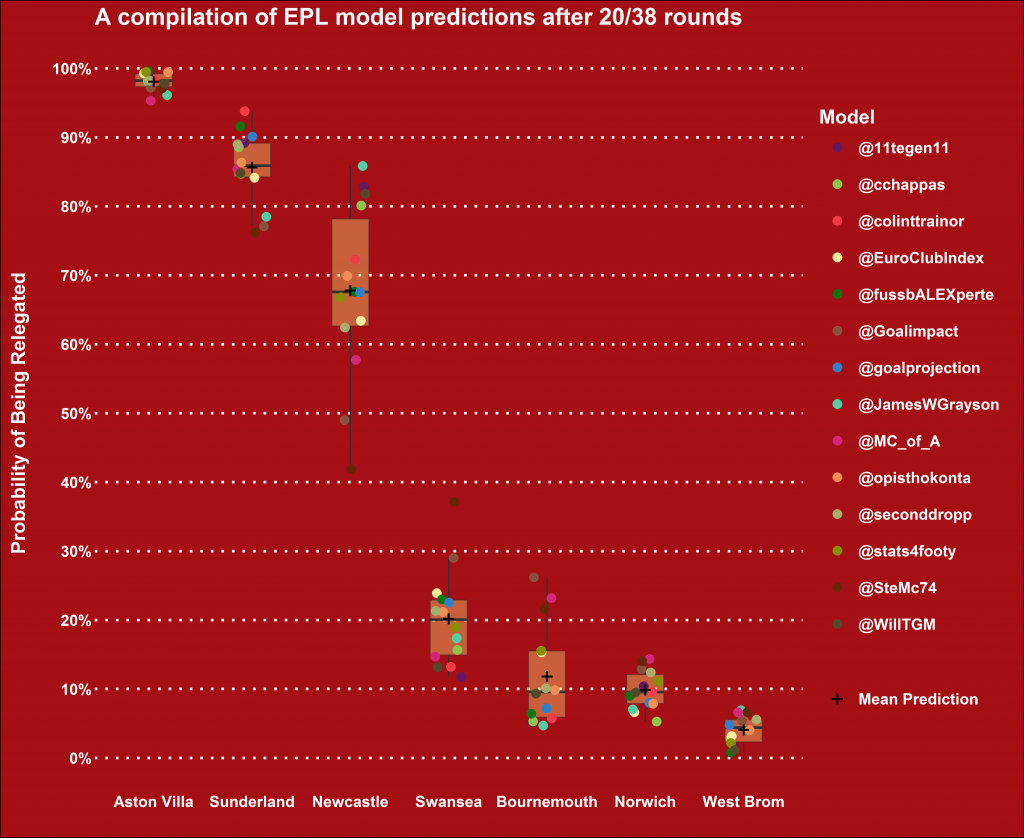 … Aston Villa, who else? Followed by Sunderland and probably Newcastle. But definitely (“definitely”? Ooh, careful there!) Aston Villa. The models all agree that it’s not looking good for Remi Garde’s team. With a survival chance of 5% under the most optimistic scenario, the Villains will need to start planning for life in the Championship. Sunderland follow closely while there is a lot of uncertainty regarding Newcastle. Some models rate their chances of survival below 20% while more optimistic Geordie fans will choose to believe the other end of the spectrum where their chance of survival is rated at 58%! If either of Newcastle or Sunderland do escape relegation (okay, okay, or if Villa perform Houdini-esque escape), the most likely team to follow them are Swansea or possibly one of the newcomers Bournemouth or Norwich. What about <insert team’s name here>? Well, I thought you might ask so I’ve prepared the following couple of charts to satisfy your needs. The first one shows the mean probability for each team ending in each position across all models as a heatmap while the second one also illustrates the median probability with a backdrop of how individual models rated each team’s chances.
… Aston Villa, who else? Followed by Sunderland and probably Newcastle. But definitely (“definitely”? Ooh, careful there!) Aston Villa. The models all agree that it’s not looking good for Remi Garde’s team. With a survival chance of 5% under the most optimistic scenario, the Villains will need to start planning for life in the Championship. Sunderland follow closely while there is a lot of uncertainty regarding Newcastle. Some models rate their chances of survival below 20% while more optimistic Geordie fans will choose to believe the other end of the spectrum where their chance of survival is rated at 58%! If either of Newcastle or Sunderland do escape relegation (okay, okay, or if Villa perform Houdini-esque escape), the most likely team to follow them are Swansea or possibly one of the newcomers Bournemouth or Norwich. What about <insert team’s name here>? Well, I thought you might ask so I’ve prepared the following couple of charts to satisfy your needs. The first one shows the mean probability for each team ending in each position across all models as a heatmap while the second one also illustrates the median probability with a backdrop of how individual models rated each team’s chances. 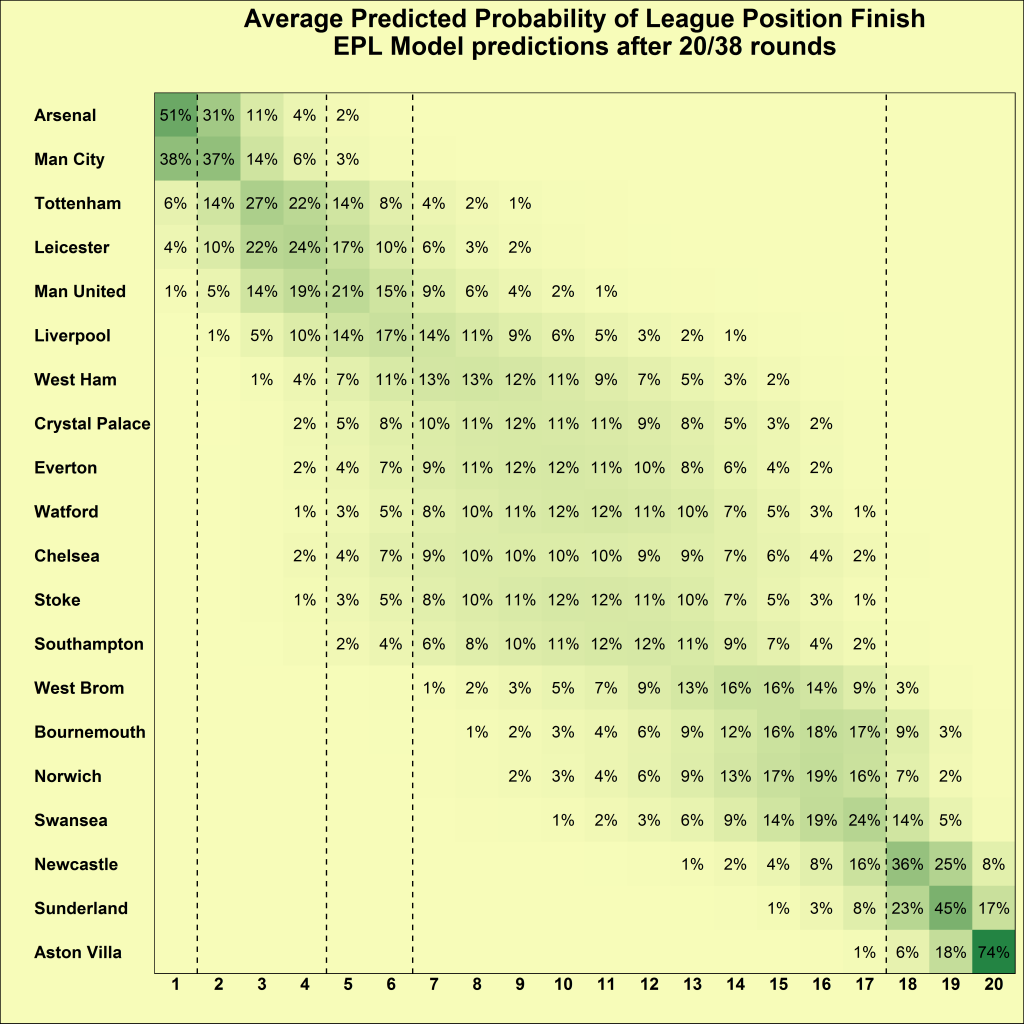
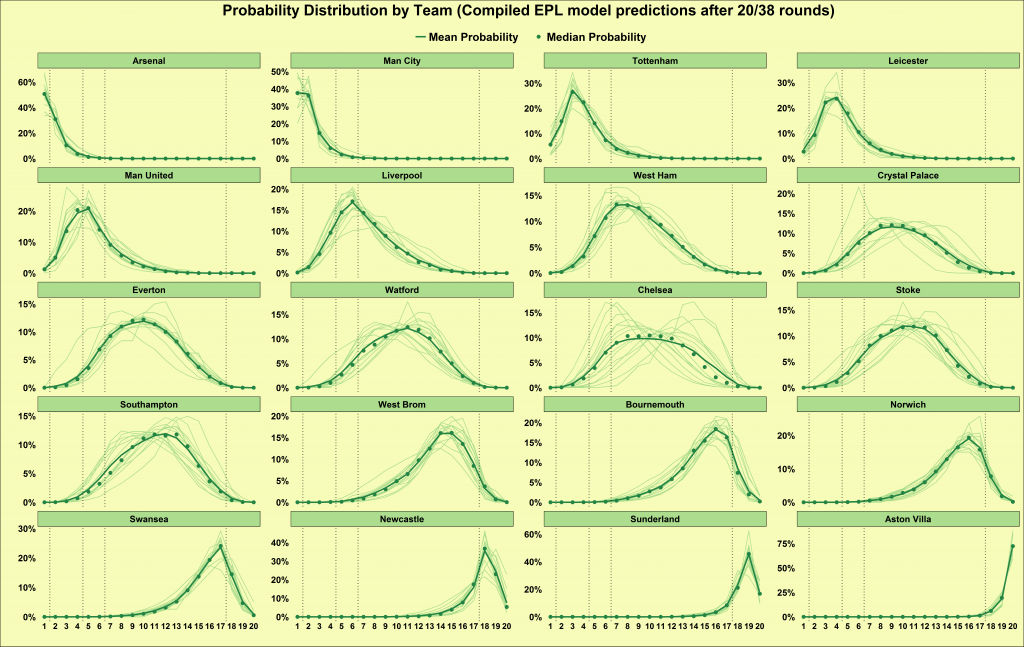 What’s interesting is that the models tend to more or less agree in most cases, but there are specific examples where they rate teams quite differently. Football developments at Chelsea this year were surprising to say the least, which seems to have left the models perplexed as to whether the rest of the season’s matches will see last year’s version of Chelsea taking over from this year’s early season performance. Some have Chelsea’s likeliest position between 5th and 7th whereas others expect them to finish between 13th and 15th. Perhaps, somewhere between the two ranges will be the outcome at the end of the season as the mean and median probability across all models would suggest. A lot of the points mentioned in this piece are also illustrated by the following chart showing the predicted number of points for each team, as well as Sporting Index quotes after round 20, for the end-of-season points’ total.
What’s interesting is that the models tend to more or less agree in most cases, but there are specific examples where they rate teams quite differently. Football developments at Chelsea this year were surprising to say the least, which seems to have left the models perplexed as to whether the rest of the season’s matches will see last year’s version of Chelsea taking over from this year’s early season performance. Some have Chelsea’s likeliest position between 5th and 7th whereas others expect them to finish between 13th and 15th. Perhaps, somewhere between the two ranges will be the outcome at the end of the season as the mean and median probability across all models would suggest. A lot of the points mentioned in this piece are also illustrated by the following chart showing the predicted number of points for each team, as well as Sporting Index quotes after round 20, for the end-of-season points’ total. 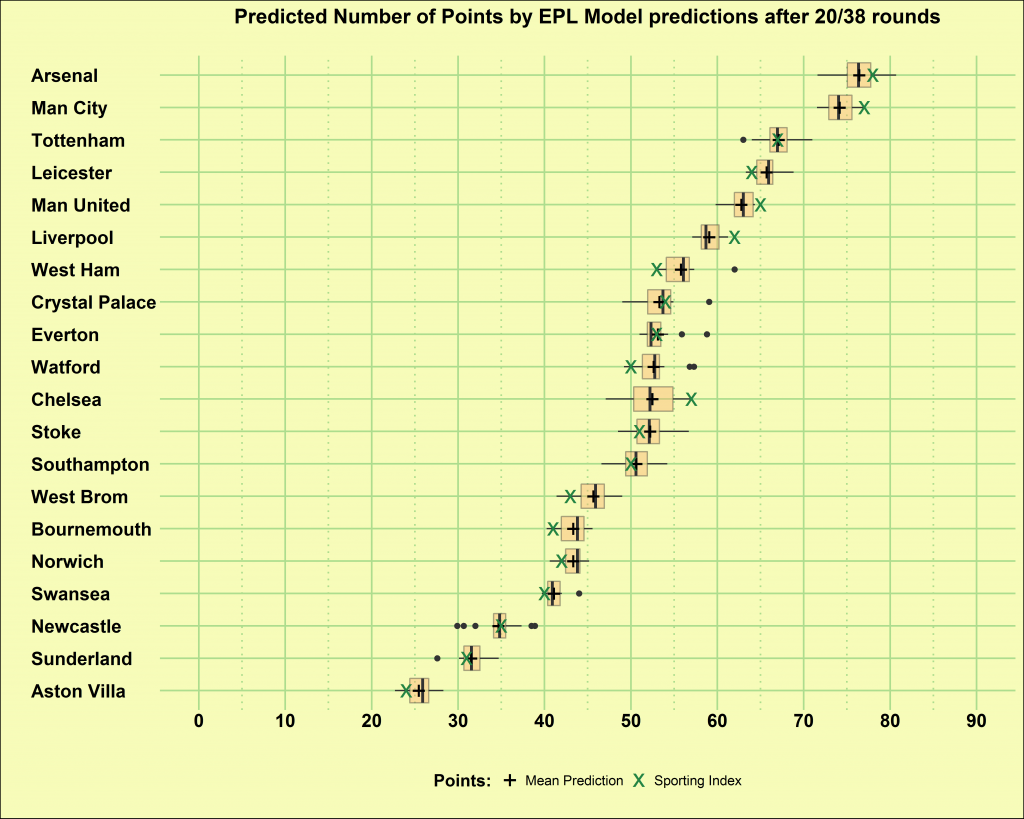 As mentioned before, Arsenal and Manchester City are rated as favourites in the title race, while Aston Villa are expected to be relegated somewhere around the 25 points mark. From the small sample data that we have, Newcastle’s predicted points total seems to follow a leptokurtic (there’s a word you never thought you’d read in a football-related piece!) distribution, i.e. with a high peak in the middle and fatter tails on either side. Furthermore, the chart shows the higher uncertainty around Cheslea’s final points total compared to other teams. Interestingly enough, Sporting Index expect Guus Hiddink’s team to perform towards the higher end of that (wider) range. Finally, while the title-winning team is expected to finish with a lower total (between 75 and 80 points) compared to previous seasons, the often quoted “40 points for survival” threshold seems to hold true according to the models’ expectations. A final note … It goes without saying that this report is simply a picture of what these models currently predict. After a few rounds or the next set of matches even, predictions may change especially for those models which heavily depend on recent form so the results may not necessarily be valid for a long time. Furthermore, if any model takes into account additional information such as injuries to key players, suspensions, or elimination from cups even this weekend’s FA Cup matches may have an effect on a team’s league chances. Having said that, although it may be interesting to monitor how these predictions change until the end of the season there are no plans to repeat this exercise on a regular basis. But enough with what we expect; let's see what real life has in store for us!
As mentioned before, Arsenal and Manchester City are rated as favourites in the title race, while Aston Villa are expected to be relegated somewhere around the 25 points mark. From the small sample data that we have, Newcastle’s predicted points total seems to follow a leptokurtic (there’s a word you never thought you’d read in a football-related piece!) distribution, i.e. with a high peak in the middle and fatter tails on either side. Furthermore, the chart shows the higher uncertainty around Cheslea’s final points total compared to other teams. Interestingly enough, Sporting Index expect Guus Hiddink’s team to perform towards the higher end of that (wider) range. Finally, while the title-winning team is expected to finish with a lower total (between 75 and 80 points) compared to previous seasons, the often quoted “40 points for survival” threshold seems to hold true according to the models’ expectations. A final note … It goes without saying that this report is simply a picture of what these models currently predict. After a few rounds or the next set of matches even, predictions may change especially for those models which heavily depend on recent form so the results may not necessarily be valid for a long time. Furthermore, if any model takes into account additional information such as injuries to key players, suspensions, or elimination from cups even this weekend’s FA Cup matches may have an effect on a team’s league chances. Having said that, although it may be interesting to monitor how these predictions change until the end of the season there are no plans to repeat this exercise on a regular basis. But enough with what we expect; let's see what real life has in store for us!
The Bundesliga at the Break: Bayern and Dortmund
As the Pep era comes to a close and the Tuchel era dawns, it looks like business as usual in the Bundesliga. Bayern are 8 points ahead of Dortmund while BVB have a a comfortable 6 point edge on Hertha in 3rd. Bayern have pretty much wrapped up the title barring a shock but Dortmund's improvements have seen them establish themselves as a legit rival if Bayern drop from their otherwordly level just a bit. Title races in the future have the potential to be something special, but let's not get ahead of ourselves. Today we look at the teams as they have performed so far this season and some questions for the second half of the year.
In Pep Guardiola’s final year, Bayern have pushed their game up another level. Their shot levels have never been higher and their shots allowed have shrunk below 7 per game, a level that seems unlikely to be reached anywhere anytime soon. Opponents barely get a sniff of goal, they are under 7 deep completions per game. For a few weeks before the injury problems hit, it was a pleasure to just enjoy a team who seemed to have almost solved the game.
A Bayern game is essentially played completely in the opposition half, the stat that drove this home the most to me: Bayern complete more passes within a 25-yard radius of opponents goal than their opponents attempt.
The Central Push All this huge forward pressure allows Bayern to have a myriad of attacking options, it's not surprising when you see 4 or 5 players in the box as they close in on goal. This year they are approaching shots a little differently. Bayern have the ball in the opposition half significantly more this season and spend a lot less time attacking on the wings. The center of the team has been pushed up and is more prominent. We can see the forward push in gif form here. 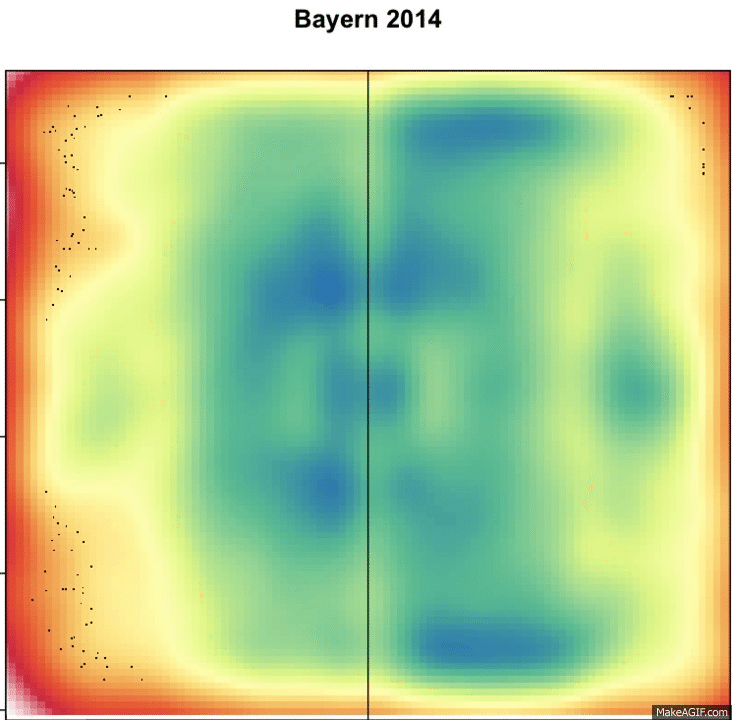 One of the big reasons the ball is on the wings less this year than last is the change in personnel. Franck Ribery came back for one game, scored, then immediately was ruled out again with injury. Last year Ribery racked up a huge 78 passes per 90 out wide, and while Douglas Costa has played extremely well as a replacement, he's not that type of player. His passes are generally further forward and come way less often: he makes 46 passes per 90, 30 fewer than Ribery. I wonder if Pep prefers it this way: an aggressive creative player who can make fewer touches count on the wing instead of running the game through it. It's something we might found out in the second half. Another reason for this push (or possibly an output of it) is Xabi Alonso has pushed up significantly. His average pass begins several yards into the opposition half this season after starting in Bayern's own half last year. The other big positional change comes from Alaba, which is unsurprising as he has yet to start in midfield.
One of the big reasons the ball is on the wings less this year than last is the change in personnel. Franck Ribery came back for one game, scored, then immediately was ruled out again with injury. Last year Ribery racked up a huge 78 passes per 90 out wide, and while Douglas Costa has played extremely well as a replacement, he's not that type of player. His passes are generally further forward and come way less often: he makes 46 passes per 90, 30 fewer than Ribery. I wonder if Pep prefers it this way: an aggressive creative player who can make fewer touches count on the wing instead of running the game through it. It's something we might found out in the second half. Another reason for this push (or possibly an output of it) is Xabi Alonso has pushed up significantly. His average pass begins several yards into the opposition half this season after starting in Bayern's own half last year. The other big positional change comes from Alaba, which is unsurprising as he has yet to start in midfield. 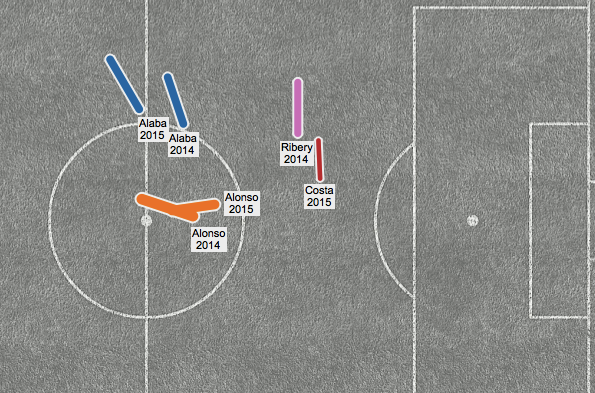 One of the benefits of the interior forward push has been the improved passing game deep down the field, led by improvements from Müller and Lewandowski. The two forwards haven't changed their positioning much and are playing similar passes as far as attacking aggression compared to last season but both have seen a significant 4% bump in their completion percentages, presumably because there are more passing options closer to them. This has helped Bayern increase the danger of their deep possessions: last year they attempted more deep passes, while completing a good, not great, 41%. This year the number of passes has dropped but their success rate leads the Bundesliga at 44%. The rising percentage has come at least partially from attempting even shorter passes (under 24 yards on average when league average is around 28). Shorter, more successful passes in dangerous areas is the story this year. Staggering Shot Volume from Lewandowski and a Thought Experiment Of course, when it comes to Lewandowski it's not the passing that catches the eye but the insane shot volumes from quality positions. Last year he took 3.8 total shots per 90, this year he's taking 4.8 from inside the box alone. Unsurprisingly, that rate leads Europe (only Ronaldo is close) and is almost a shot more than Bayern opponents take in total. This leads to the obvious question: how good would Bayern be if they were allowed only 2 non-Lewandowski shots per game? Making the leap to the assumption that Lewandowski would keep his shot rate around 6 per game despite opponents knowing they could focus on him, we figure 8 total shots for Bayern. Assuming a drop in the Lewandowski conversion rate to .15 and a non-Lewandowski conversion rate of 0.4 (the NL's would only take great shots), we figure they will score 1.7 goals per game while allowing 0.5. Using Martin Eastwood's pythagorean expectation we come up with Bayern around 73 points with this method. With great rigor, we can conclude that Bayern would still be reasonably strong favorites to win the league and would finish 2nd at worst with a hard cap of 2 non-Lewandowski shots per game. I think you would have to cut it to 20 total non-Lewandowski shots over the whole season to threaten Champions League. The Stifling Defense Defensively, sometimes the hype around Schmidt's Leverkusen overshadows the steady heat Bayern put on you. Bayern and Leverkusen are way ahead of the pack in pressure, both holding opponents under 70% passing. The Bayern defensive line is so high they can help in the attack, as seen by Javi Martinez's close range header from open play against Schalke and Jerome Boateng's passing. More importantly the high line means they cut off your escape opportunities very quickly while Neuer's range limits the amount of space to run behind. No team wins the ball back higher up the pitch and as we saw earlier, they are historically stingy with the number of dangerous passes they allow. And these passes are not just rare, but come from long range. As short as Bayern passes are in the attacking area, their opponents are forced into even longer passes when attacking.
One of the benefits of the interior forward push has been the improved passing game deep down the field, led by improvements from Müller and Lewandowski. The two forwards haven't changed their positioning much and are playing similar passes as far as attacking aggression compared to last season but both have seen a significant 4% bump in their completion percentages, presumably because there are more passing options closer to them. This has helped Bayern increase the danger of their deep possessions: last year they attempted more deep passes, while completing a good, not great, 41%. This year the number of passes has dropped but their success rate leads the Bundesliga at 44%. The rising percentage has come at least partially from attempting even shorter passes (under 24 yards on average when league average is around 28). Shorter, more successful passes in dangerous areas is the story this year. Staggering Shot Volume from Lewandowski and a Thought Experiment Of course, when it comes to Lewandowski it's not the passing that catches the eye but the insane shot volumes from quality positions. Last year he took 3.8 total shots per 90, this year he's taking 4.8 from inside the box alone. Unsurprisingly, that rate leads Europe (only Ronaldo is close) and is almost a shot more than Bayern opponents take in total. This leads to the obvious question: how good would Bayern be if they were allowed only 2 non-Lewandowski shots per game? Making the leap to the assumption that Lewandowski would keep his shot rate around 6 per game despite opponents knowing they could focus on him, we figure 8 total shots for Bayern. Assuming a drop in the Lewandowski conversion rate to .15 and a non-Lewandowski conversion rate of 0.4 (the NL's would only take great shots), we figure they will score 1.7 goals per game while allowing 0.5. Using Martin Eastwood's pythagorean expectation we come up with Bayern around 73 points with this method. With great rigor, we can conclude that Bayern would still be reasonably strong favorites to win the league and would finish 2nd at worst with a hard cap of 2 non-Lewandowski shots per game. I think you would have to cut it to 20 total non-Lewandowski shots over the whole season to threaten Champions League. The Stifling Defense Defensively, sometimes the hype around Schmidt's Leverkusen overshadows the steady heat Bayern put on you. Bayern and Leverkusen are way ahead of the pack in pressure, both holding opponents under 70% passing. The Bayern defensive line is so high they can help in the attack, as seen by Javi Martinez's close range header from open play against Schalke and Jerome Boateng's passing. More importantly the high line means they cut off your escape opportunities very quickly while Neuer's range limits the amount of space to run behind. No team wins the ball back higher up the pitch and as we saw earlier, they are historically stingy with the number of dangerous passes they allow. And these passes are not just rare, but come from long range. As short as Bayern passes are in the attacking area, their opponents are forced into even longer passes when attacking. 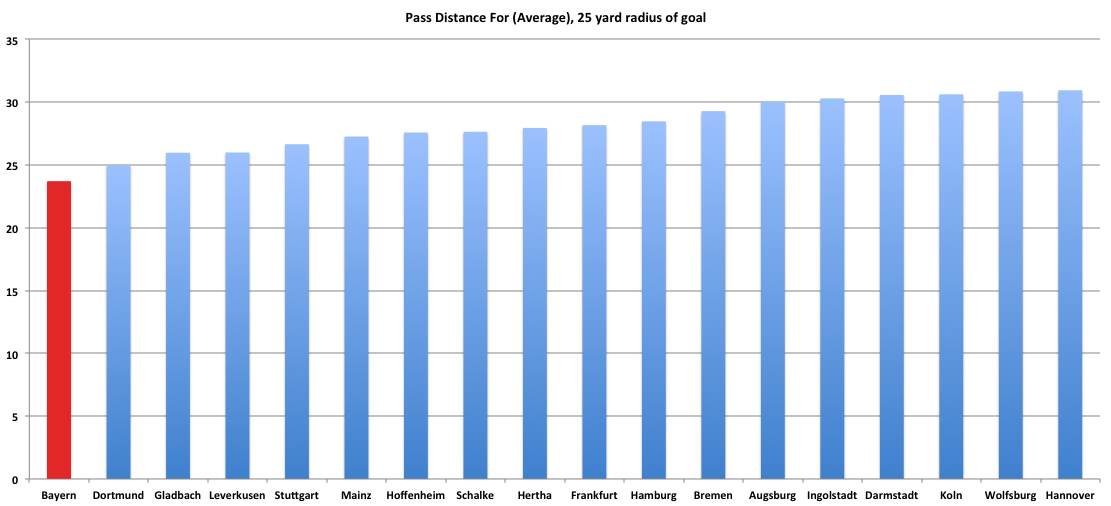
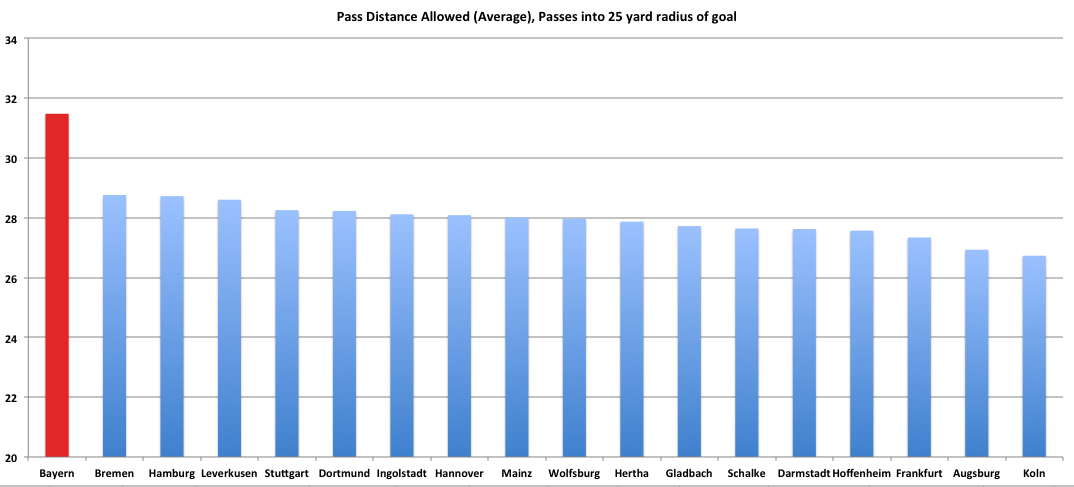 A weak link? When healthy, there is essentially nothing wrong with Bayern. The important part is "when healthy" because there is a way to stop them, and it comes when their wingers go down with injuries. In my Bundesliga preview, I pointed out that last season when both Robben and Ribery were out Bayern's performance dropped from unstoppable to a great, but not truly dominant level. We've seen something similar at the end of the Hinrunde this season when Costa, Ribery, and Robben were all out:
A weak link? When healthy, there is essentially nothing wrong with Bayern. The important part is "when healthy" because there is a way to stop them, and it comes when their wingers go down with injuries. In my Bundesliga preview, I pointed out that last season when both Robben and Ribery were out Bayern's performance dropped from unstoppable to a great, but not truly dominant level. We've seen something similar at the end of the Hinrunde this season when Costa, Ribery, and Robben were all out: 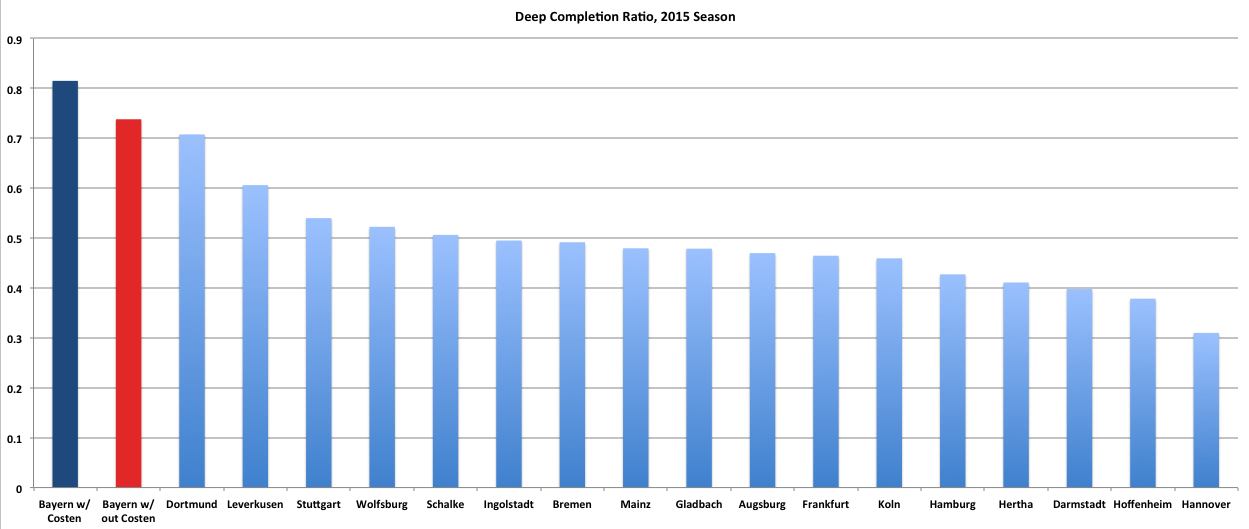 Up until the final match-day, I held out some hope we might see the lead at 5, or even 3 points, heading into the break. I would then be able to brandish this graph and proclaim Bayern are at risk if they can't get their wingers back and we might have a title race between two roughly equally matched teams. Instead, the lead is 8 after Dortmund no-showed at Koln and the race is likely over. Rückrunde Questions Will they be healthy? And if everyone is healthy how will Mario Götze be used? Someone on Bayern seems likely to become the best player in the world who doesn't regularly start and Götze seems like a candidate to fill that role. Who will Pep go for if both Ribery and Costa are healthy? The brilliance we've seen from Costa (voted player of the year in at least one poll) is more peripheral than the heavily involved passing machine that Ribery has been in recent years. We don't really know if his body can still hold up to a lot of minutes yet. Hopefully we get to see Ribery back in full flow and this decision will not be made by injury. Can they win the Champions League? Of course they can. They are right there with Barcelona when healthy; fans everywhere would win if we see the two face off, preferably in a semifinal, at full health.
Up until the final match-day, I held out some hope we might see the lead at 5, or even 3 points, heading into the break. I would then be able to brandish this graph and proclaim Bayern are at risk if they can't get their wingers back and we might have a title race between two roughly equally matched teams. Instead, the lead is 8 after Dortmund no-showed at Koln and the race is likely over. Rückrunde Questions Will they be healthy? And if everyone is healthy how will Mario Götze be used? Someone on Bayern seems likely to become the best player in the world who doesn't regularly start and Götze seems like a candidate to fill that role. Who will Pep go for if both Ribery and Costa are healthy? The brilliance we've seen from Costa (voted player of the year in at least one poll) is more peripheral than the heavily involved passing machine that Ribery has been in recent years. We don't really know if his body can still hold up to a lot of minutes yet. Hopefully we get to see Ribery back in full flow and this decision will not be made by injury. Can they win the Champions League? Of course they can. They are right there with Barcelona when healthy; fans everywhere would win if we see the two face off, preferably in a semifinal, at full health. 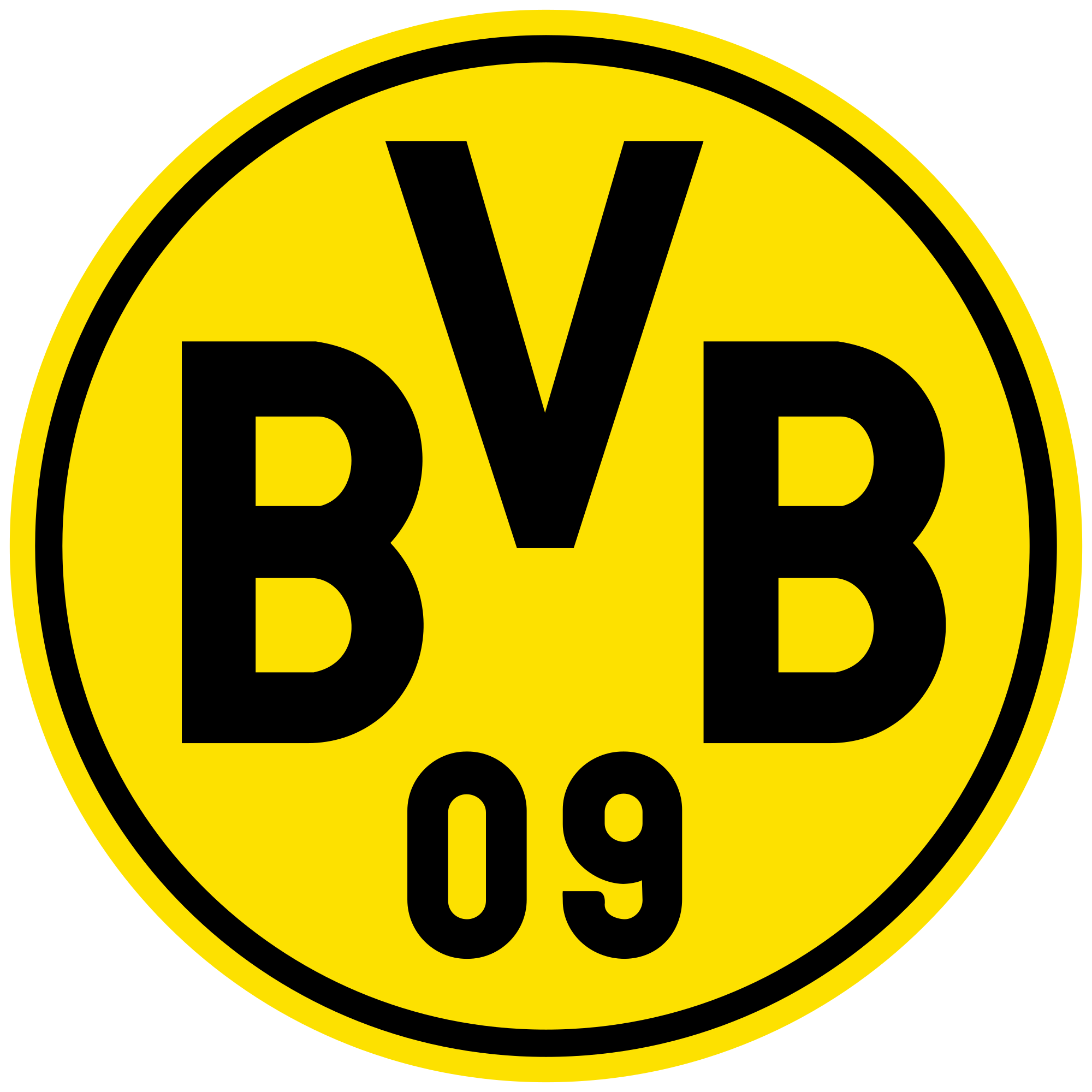 Dortmund
Dortmund  Climbing Back to the Top Through Improved Attack The first 17 games for Thomas Tuchel as the head man at Dortmund have pretty much been an unqualified success. Dortmund have returned to a comfortable 2nd place position behind powerful underlying numbers. Simply checking the goals from last year to this show the attack has improved in leaps and bounds, last year Dortmund scored just 47 goals all season while they have already reached that number at the break this year. Obviously, last year was an anomaly as far as bad luck goes but it's not simple luck reversion, the underlying numbers are significantly improved on the attacking side. First, they simply have more of the ball in dangerous spots: their deep completion numbers have jumped up over 4 per game to come close to matching Bayern.
Climbing Back to the Top Through Improved Attack The first 17 games for Thomas Tuchel as the head man at Dortmund have pretty much been an unqualified success. Dortmund have returned to a comfortable 2nd place position behind powerful underlying numbers. Simply checking the goals from last year to this show the attack has improved in leaps and bounds, last year Dortmund scored just 47 goals all season while they have already reached that number at the break this year. Obviously, last year was an anomaly as far as bad luck goes but it's not simple luck reversion, the underlying numbers are significantly improved on the attacking side. First, they simply have more of the ball in dangerous spots: their deep completion numbers have jumped up over 4 per game to come close to matching Bayern. 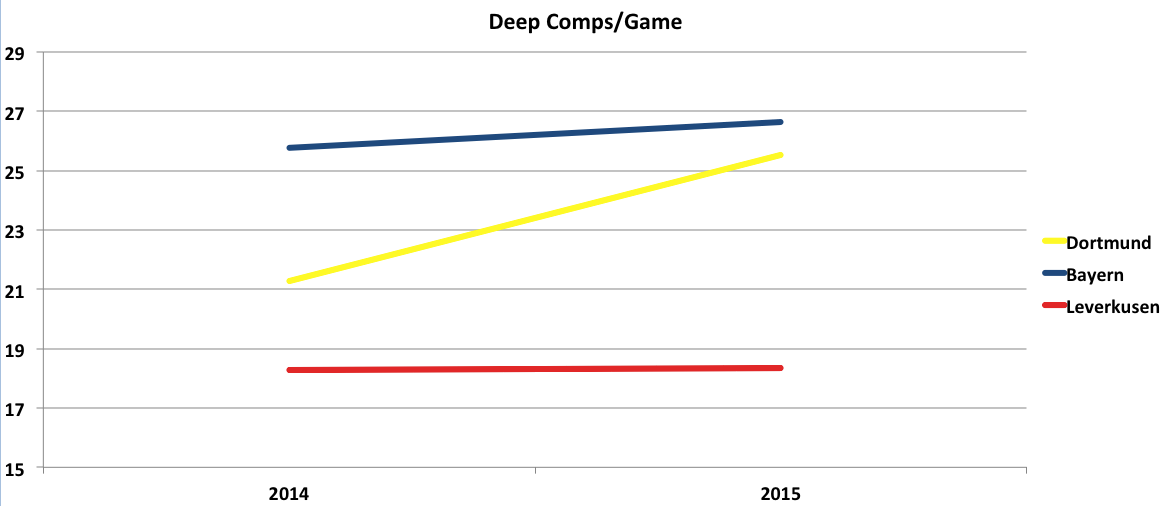 The style is more conducive to generating goals than it was last season. The team has changed how they attack from the wild, at times ineffective, scramble of the final Klopp year to a more measured approach this season. They take many more shots from established possession, as shown by a Michael Caley article in October, and they play their way up the field using much shorter passes this season. This more measured approach has paid off big time around the goal. Last season Dortmund were essentially league average in completion % around goal while attempting those passes from league average locations, this year they are just barely behind Bayern at the top of those rankings. This attack looks much more like an elite side than last seasons.
The style is more conducive to generating goals than it was last season. The team has changed how they attack from the wild, at times ineffective, scramble of the final Klopp year to a more measured approach this season. They take many more shots from established possession, as shown by a Michael Caley article in October, and they play their way up the field using much shorter passes this season. This more measured approach has paid off big time around the goal. Last season Dortmund were essentially league average in completion % around goal while attempting those passes from league average locations, this year they are just barely behind Bayern at the top of those rankings. This attack looks much more like an elite side than last seasons.  Main Man Mkhitaryan
Main Man Mkhitaryan 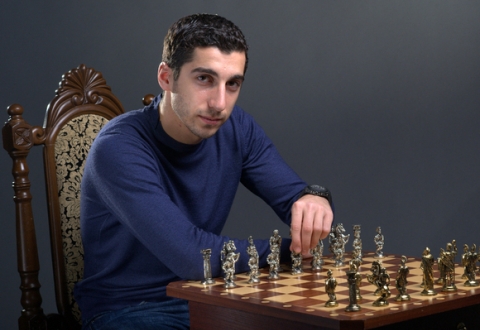 The player who has been the most influential has certainly been Henrikh Mkhitaryan. His struggles last season were a bit overblown and a bit unlucky, he was still one of the top attacking players in the league, but there is no question he has taken a step forward this season. He leads the Bundesliga in several categories: -passes completed in final 25 yards (76, next highest is Calhanoglu at 63) -assists, (his 8 are tied with Raffael) -pictures taken playing chess in casual attire (2, Papadopoulos and Holtby tied for 2nd) and -short key passes (37, lead Müller by 1. Total key passes are led by cross/corner-heavy Pascal Groß from Ingolstadt). Along with his passing brilliance he has chipped in 6 goals and takes 3.2 shots per 90 with over half of those coming inside the box. Özil has been amazing and no one has the stat-line to match up with him this season, but if you were looking for someone who comes the closest it would be Mkhitaryan. His rise to Dortmund's King man has seen Marco Reus fade a bit from the center of the board. Tuchel's more controlled style plays more to Mkhi's strengths than Klopp's free-wheeling tactics which played toward Reus, though this trend began last year.
The player who has been the most influential has certainly been Henrikh Mkhitaryan. His struggles last season were a bit overblown and a bit unlucky, he was still one of the top attacking players in the league, but there is no question he has taken a step forward this season. He leads the Bundesliga in several categories: -passes completed in final 25 yards (76, next highest is Calhanoglu at 63) -assists, (his 8 are tied with Raffael) -pictures taken playing chess in casual attire (2, Papadopoulos and Holtby tied for 2nd) and -short key passes (37, lead Müller by 1. Total key passes are led by cross/corner-heavy Pascal Groß from Ingolstadt). Along with his passing brilliance he has chipped in 6 goals and takes 3.2 shots per 90 with over half of those coming inside the box. Özil has been amazing and no one has the stat-line to match up with him this season, but if you were looking for someone who comes the closest it would be Mkhitaryan. His rise to Dortmund's King man has seen Marco Reus fade a bit from the center of the board. Tuchel's more controlled style plays more to Mkhi's strengths than Klopp's free-wheeling tactics which played toward Reus, though this trend began last year. 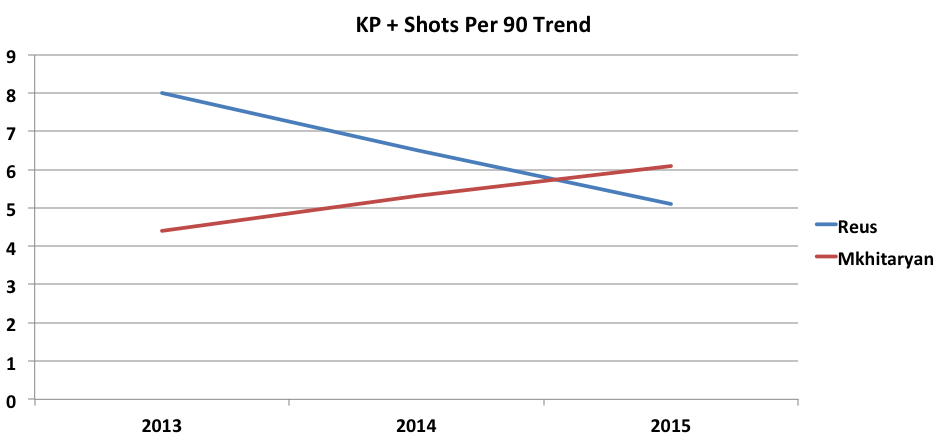 The Beating Heart and Weigl's Pushup Regime While Mkhitaryan racks up the counting stats, Gundögan and Weigl have been the beating heart of the side. Those two finished the year 1st and 3rd in total passes played. Weigl has great passing numbers in his slightly more withdrawn role and is widely admired by all the tactical experts who watch the league but I can't help wondering how much better he could be if he simply did 100 pushups a day. That's my one free suggestion, Adam Lallana and Mahmoud Dahoud are free to take it as well.
The Beating Heart and Weigl's Pushup Regime While Mkhitaryan racks up the counting stats, Gundögan and Weigl have been the beating heart of the side. Those two finished the year 1st and 3rd in total passes played. Weigl has great passing numbers in his slightly more withdrawn role and is widely admired by all the tactical experts who watch the league but I can't help wondering how much better he could be if he simply did 100 pushups a day. That's my one free suggestion, Adam Lallana and Mahmoud Dahoud are free to take it as well. 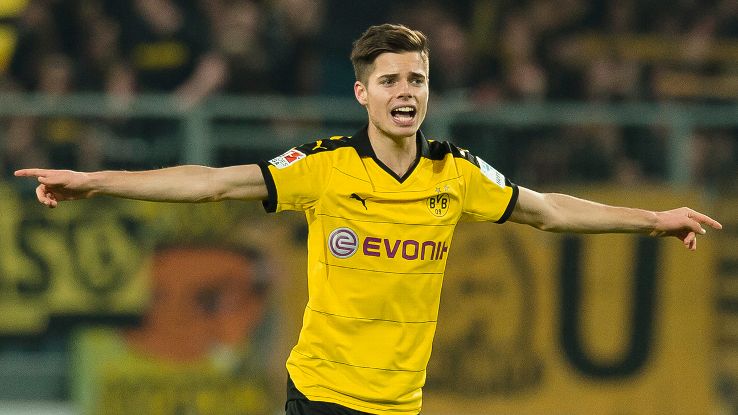
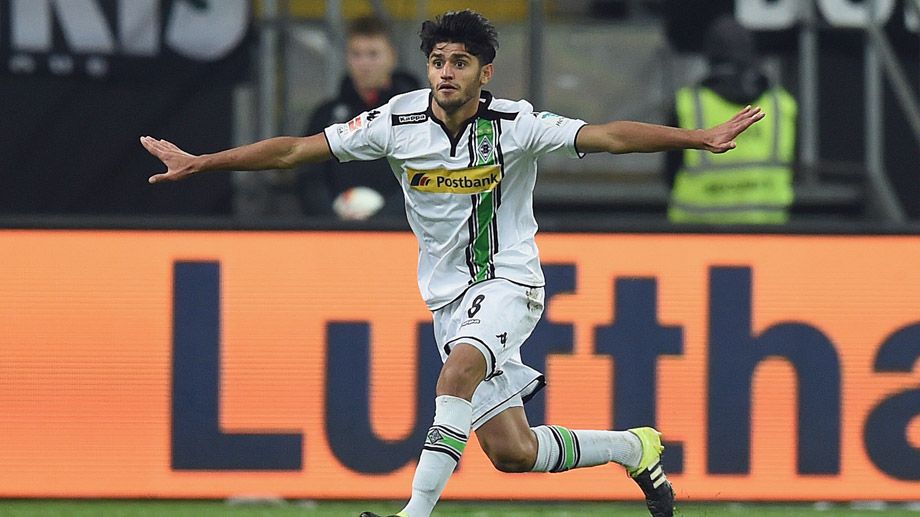
The Weak Link When Dortmund have the ball, they aren't far off Bayern and are certainly one of the best teams across Europe. Without the ball, there are still some of the same frailties we saw last season. You could see in the summary above Dortmund allow the 2nd-closest average shot in the league. This has helped opponents get a higher % of shots on target against Dortmund than any other team in the league at 46%. That has added up to 23 goals allowed already. Last year Dortmund suffered through a similar phenomenon where they generally stifled opponents but the rare successful attacks were of extremely high value. The fact this trend has continued with an improved goalie is worrying and is what is keeping them from seriously challenging Bayern and joining the very top of European clubs. Stats like these always bring up the debate of "How good is Mats Hummels really?" He puts together an amazing highlight reel and his passing quality can be excellent but in recent years he makes several head-scratching plays a month and can look a bit slow or unfocused from time to time. Constantin Eckner wrote a piece detailing the questions around Hummels performance that summed up the issue nicely. Dortmund dropped him for a short while, but then suffered one of their worst performances of the year against Wolfsburg and he soon returned to the lineup. Is he that much better than Sokratis and Bender? I don't know. What I do know is if I had three wishes from the omnipotent Soccer Genie who would tell me exactly how valuable certain players were I'd ask for Hummels first of all. He's a fascinating player and by all accounts a fascinating person. (The next two might be Neuer and Raffael). A worrying(?) sign that merits further investigation was uncovered by Samira Kumar's great research on center back gaps on crosses against Bayern. Dortmund's centerbacks had the widest gap between them, with a large gap between the RB and CB as well. This is just one game but it's an interesting lead. Slacking Press? With no Klopp, you might expect the press to have slacked off but that hasn't happened. In fact, Dortmund's press is forcing more incompletions far from goal than ever before. 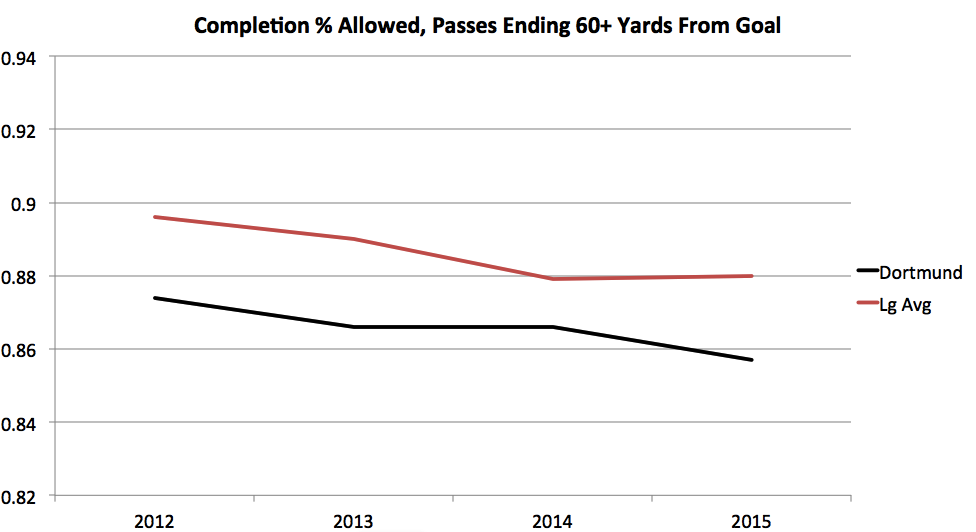 Tuchel said he wouldn't change too much and it doesn't look like the strong pressure has eased much at all. Changing Positions
Tuchel said he wouldn't change too much and it doesn't look like the strong pressure has eased much at all. Changing Positions 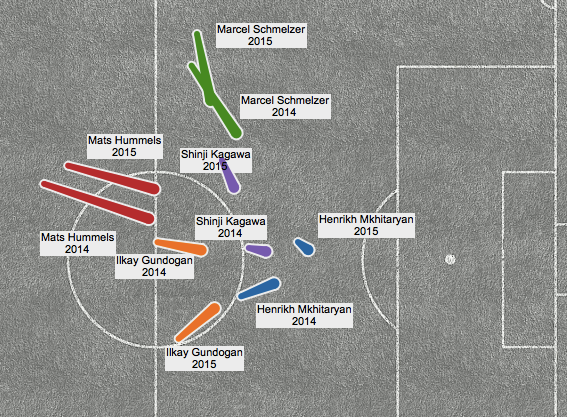 We can see significant positional differences from Mkhitaryan, Kagawa, and Gundögan this year as the midfield has been rejiggered. We see minor differences, mainly less aggression, from Hummels and Schmelzer. Rückrunde Questions Will depth be a problem? Adrian Ramos hasn't proven a quality backup up front, meaning key man Pierre-Emerick Aubameyang is rarely rested. Gonzalo Castro has emerged as the season progressed and is extremely versatile but after him, there isn't too much depth in attack with Januzaj not trusted and Hoffman out to Gladbach. Outside of fullback, Dortmund really don't have too much depth anywhere. And even there new signee Park has been quite unimpressive. Can they fix the defensive missteps that have led to 65 goals allowed over the past 51 games? This is the big step they need to make to build momentum for next years title challenge against Ancelotti's Bayern. This year remains a dream but Dortmund have made big strides to get back very close to being an elite European club.
We can see significant positional differences from Mkhitaryan, Kagawa, and Gundögan this year as the midfield has been rejiggered. We see minor differences, mainly less aggression, from Hummels and Schmelzer. Rückrunde Questions Will depth be a problem? Adrian Ramos hasn't proven a quality backup up front, meaning key man Pierre-Emerick Aubameyang is rarely rested. Gonzalo Castro has emerged as the season progressed and is extremely versatile but after him, there isn't too much depth in attack with Januzaj not trusted and Hoffman out to Gladbach. Outside of fullback, Dortmund really don't have too much depth anywhere. And even there new signee Park has been quite unimpressive. Can they fix the defensive missteps that have led to 65 goals allowed over the past 51 games? This is the big step they need to make to build momentum for next years title challenge against Ancelotti's Bayern. This year remains a dream but Dortmund have made big strides to get back very close to being an elite European club.
Your Perfectly Average 2015-16 PL Side: Starring Watford
There's been something of a lower class uprising in the Premier League over the last 9-12 months. Leicester were left for dead last season yet here they are lurking around first place despite most analysts saying they shouldn't be there and won't stay there (in fairness, they shouldn't but that's already been discussed). Bournemouth have remarkably remained a positive shot differential team this season despite a litany of injuries to their attacking core (with expected goal numbers not painting Bournemouth quite as highly, locations have hurt them), and have Crystal Palace somehow found a formula of making the shots that hit the target incredibly valuable? (Well, no they haven't but the divergence between TSR/ xG formulas that count all shots versus SoTR/xG models that count only SoT is fascinating). Nestled in with this rising class is Watford. The club with the same owners as Udinese have been a pleasant surprise this season. This was hard to see coming as they gained automatic promotion last season with numbers that at least on the peripheral level weren't really impressive. Their TSR was barely above par at .512, their SoTR of .555 was better but again didn't suggest that they should've finished in the automatic promotion spots. All things being equal though, The Championship is as advertised: a wacky land of misfits trying to gain promotion and there's evidence to suggest that basic shot metrics don't translate well repeatability wise compared to the rigidness of the PL. Over the summer, Watford, laden with some Premier League cash opened their check books and spent on the likes of Etienne Capoue and Jose Holebas. Bookies widely predicted them as one of the teams that were likely to go down this year and it made a decent amount of sense, although despite widespread spending being compared to QPR seemed like a couple bridges too far. Here's the thing, Watford have actually been good this year. Okay that's not entirely true. They've been good at one end of the field this season and it's their defense. Simply put, through 20 games Watford's defense has held up quite well. They rank in the top 9 in shots conceded, top 7 in shots on target conceded and depending on the xG model at hand, they rank them somewhere in the upper mid table.. I'm actually quite surprised at how good Watford are defensively. Signing a player like Capoue does help in strengthening your defense but you would think that a team that wasn't particularly great in terms of shot suppression in the Championship would struggle to find greater success in a considerably higher level league, but here Watford are to buck that. Using Paul Riley's xG numbers, Watford are on pace to have an xG against of 43.6, which going back to 2010-11 would be the best defensive output of a promoted club. The only club I could find that were within 5 goals of that mark was Crystal Palace in 2013-14, and it took a midseason hire of football's favorite manager Tony Pulis to accomplish that. What's helped Watford defensively this year is they've spent a vast amount of time in a +1 game state. No club in the PL has spent more time up by one goal than Watford and if you want to just simplify it to just being in a winning position, Watford still rank fourth in that area, 170 minutes above the league average.  Being in a winning position often means you can have a save% higher than normal, which Joel Salamon talked about that with United a month ago. That being said, it's not even that Watford are doing similar things like United are in terms of pushing teams back as far away from their final third area as possible. Watford are just below the league average in both final third and neutral zone passes conceded. And when it comes to SV%, Watford's are only ~1-2% above the league average whether tied or up by a goal, unlike United who literally form a wall once they're in a +1 game state. You add all these things together, and it gives an overall picture of a slightly above average defense that should be able to hang on for another 18 games. No ridiculous save% in any situation and decent shot quality suppression. An added bonus for Watford is that their defense has done well versus big clubs. They limited Tottenham to 10 shots despite being down to 10 men, Manchester City got 16 shots against them but the quality of those chances weren't anything to write home about, and Chelsea was more of the same. Riley's numbers have Watford pretty much dead on with their 22 goals conceded at 22.94, and there really isn't too much negative to write about Watford defensively except that their goalie Heurelho Gomes is prone to the hilarious gaff every once in a while. Transitioning up the pitch to their attack and it's a mixed picture. Let's start with the positives: It's fun to see a good ole English 4-4-2 up and about, particularly when the two up front complement each other so well. Troy Deeney and Odion Ighalo scored loads of goals last year in the Championship with a combined tally of 41, 38 of them of the non penalty goal variety for a per 90 combined rate of 0.64. Ighalo in particular had an absurd scoring run, with a NPG per 90 rate of 0.93. Some of that has changed with Deeney only being limited to six goals this season and his conversion rate plummeting into the low teens. But one thing that hasn't changed is Ighalo still scoring goals at a ludicrous rate. His NPG per 90 this season is at 0.75, a mark that's very comparable to the likes of Romelu Lukaku (0.77) and Sergio Aguero (0.81). Ighalo's xG per 90 mark of 0.55 and an overall conversion rate of 20.6% suggests that there's some overperformance in his season, but it isn't uncommon to see strikers have seasons where they overperform xG data by 4-6 goals. Ighalo at full flight is a joy to watch, with his performance versus Liverpool a perfect example. He was built to play in a high tempo league, and he's thrived this season in a way that even scouts who liked him couldn't even have imagined. The problem with Watford is once you get past those two, it's just grizzly when it comes to offensive production (and that's probably being nice). Deeney and Ighalo have scored 20 of Watford's 25 goals. That isn't a misprint. That is staggering and when you look at the squad they've assembled this season, you can see why that's the case. It's filled with a bunch of late prime age journeyman that you would be hard pressed to know anything about. Contrast that with Leicester, another team that primarily plays a 4-4-2, and they have 5-6 guys who at the very least pose some type of goal/playmaking threat. Assuming Watford stay up, and it's almost impossible for them not to, this will be an area they need to heavily invest in. There are some other things to worry about with Watford in attack. Their on target conversion rate overall is 33.3%, third highest in the PL behind Leicester and Everton. Also a quirky trait about Watford is their ability to score at a ridiculous rate when they're either tied or down a goal. It's funny, they're ~13% below the league average in scoring goals when winning but 13% above average in scoring when the game is tied. No team has a higher conversion rate when the game is tied and only Everton have a higher rate when down in a game.
Being in a winning position often means you can have a save% higher than normal, which Joel Salamon talked about that with United a month ago. That being said, it's not even that Watford are doing similar things like United are in terms of pushing teams back as far away from their final third area as possible. Watford are just below the league average in both final third and neutral zone passes conceded. And when it comes to SV%, Watford's are only ~1-2% above the league average whether tied or up by a goal, unlike United who literally form a wall once they're in a +1 game state. You add all these things together, and it gives an overall picture of a slightly above average defense that should be able to hang on for another 18 games. No ridiculous save% in any situation and decent shot quality suppression. An added bonus for Watford is that their defense has done well versus big clubs. They limited Tottenham to 10 shots despite being down to 10 men, Manchester City got 16 shots against them but the quality of those chances weren't anything to write home about, and Chelsea was more of the same. Riley's numbers have Watford pretty much dead on with their 22 goals conceded at 22.94, and there really isn't too much negative to write about Watford defensively except that their goalie Heurelho Gomes is prone to the hilarious gaff every once in a while. Transitioning up the pitch to their attack and it's a mixed picture. Let's start with the positives: It's fun to see a good ole English 4-4-2 up and about, particularly when the two up front complement each other so well. Troy Deeney and Odion Ighalo scored loads of goals last year in the Championship with a combined tally of 41, 38 of them of the non penalty goal variety for a per 90 combined rate of 0.64. Ighalo in particular had an absurd scoring run, with a NPG per 90 rate of 0.93. Some of that has changed with Deeney only being limited to six goals this season and his conversion rate plummeting into the low teens. But one thing that hasn't changed is Ighalo still scoring goals at a ludicrous rate. His NPG per 90 this season is at 0.75, a mark that's very comparable to the likes of Romelu Lukaku (0.77) and Sergio Aguero (0.81). Ighalo's xG per 90 mark of 0.55 and an overall conversion rate of 20.6% suggests that there's some overperformance in his season, but it isn't uncommon to see strikers have seasons where they overperform xG data by 4-6 goals. Ighalo at full flight is a joy to watch, with his performance versus Liverpool a perfect example. He was built to play in a high tempo league, and he's thrived this season in a way that even scouts who liked him couldn't even have imagined. The problem with Watford is once you get past those two, it's just grizzly when it comes to offensive production (and that's probably being nice). Deeney and Ighalo have scored 20 of Watford's 25 goals. That isn't a misprint. That is staggering and when you look at the squad they've assembled this season, you can see why that's the case. It's filled with a bunch of late prime age journeyman that you would be hard pressed to know anything about. Contrast that with Leicester, another team that primarily plays a 4-4-2, and they have 5-6 guys who at the very least pose some type of goal/playmaking threat. Assuming Watford stay up, and it's almost impossible for them not to, this will be an area they need to heavily invest in. There are some other things to worry about with Watford in attack. Their on target conversion rate overall is 33.3%, third highest in the PL behind Leicester and Everton. Also a quirky trait about Watford is their ability to score at a ridiculous rate when they're either tied or down a goal. It's funny, they're ~13% below the league average in scoring goals when winning but 13% above average in scoring when the game is tied. No team has a higher conversion rate when the game is tied and only Everton have a higher rate when down in a game. 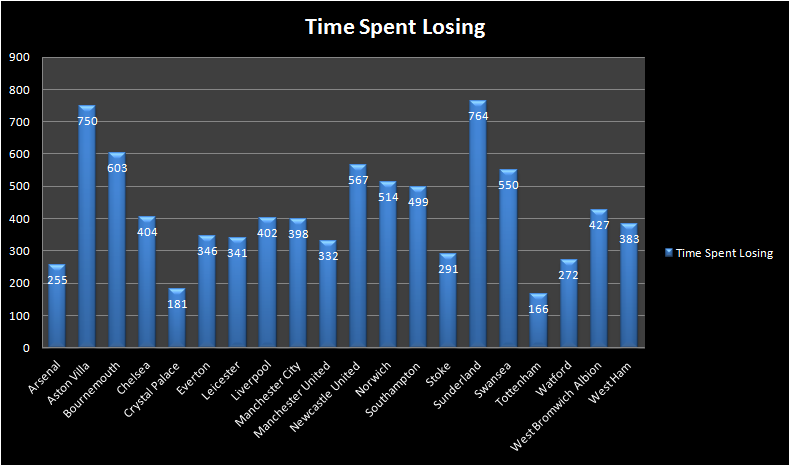
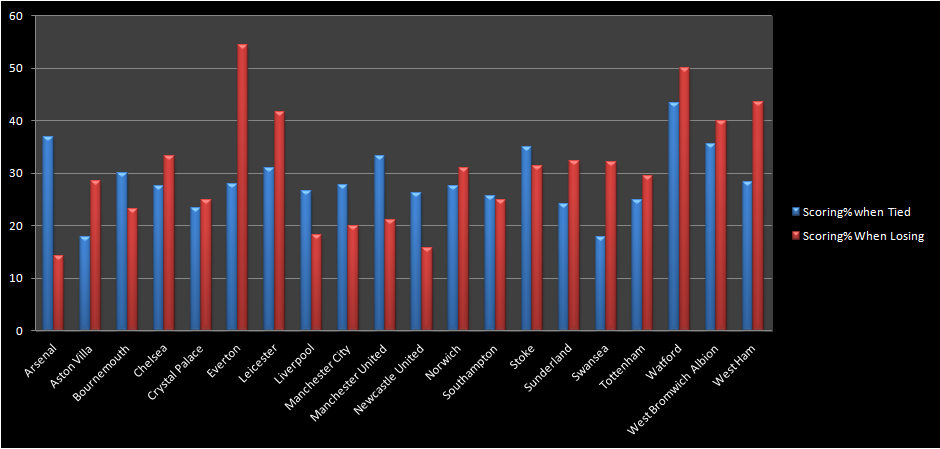 If and when those numbers even up, you'll probably see Watford come down a peg or two in their goal scoring which may make for an unpleasant scene. Having said all of that, Watford have more or less been as good as their current league standings. Yes an overall PDO of 104.8 does scream a little bit of regression, yes their talent level whether using xG or SoT suggests that Watford have gained 2-3 more points than they should but that's nothing extraordinary and end of season projections have them finishing in around 9th place. They have an above average defense and a striker who's been on top form since the start of last season. For a first season in the PL, it's almost the quintessential type of year to have. There are obvious problems that need to be addressed and the failed loan acquisition of Juan Iturbe suggests that Watford weren't blind to their attacking woes. In many ways, their season is the opposite to QPR's from last year and this despite a transfer model that looked so very similar, which is one of the nicer compliments one could give to 2015-16 Watford.
If and when those numbers even up, you'll probably see Watford come down a peg or two in their goal scoring which may make for an unpleasant scene. Having said all of that, Watford have more or less been as good as their current league standings. Yes an overall PDO of 104.8 does scream a little bit of regression, yes their talent level whether using xG or SoT suggests that Watford have gained 2-3 more points than they should but that's nothing extraordinary and end of season projections have them finishing in around 9th place. They have an above average defense and a striker who's been on top form since the start of last season. For a first season in the PL, it's almost the quintessential type of year to have. There are obvious problems that need to be addressed and the failed loan acquisition of Juan Iturbe suggests that Watford weren't blind to their attacking woes. In many ways, their season is the opposite to QPR's from last year and this despite a transfer model that looked so very similar, which is one of the nicer compliments one could give to 2015-16 Watford.
